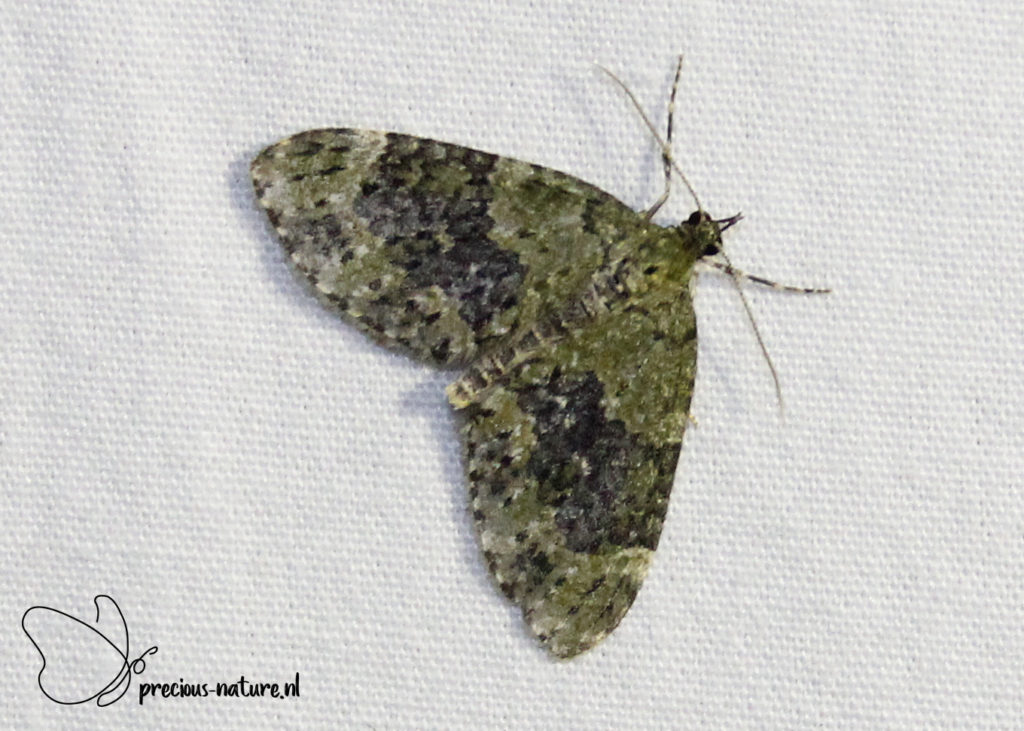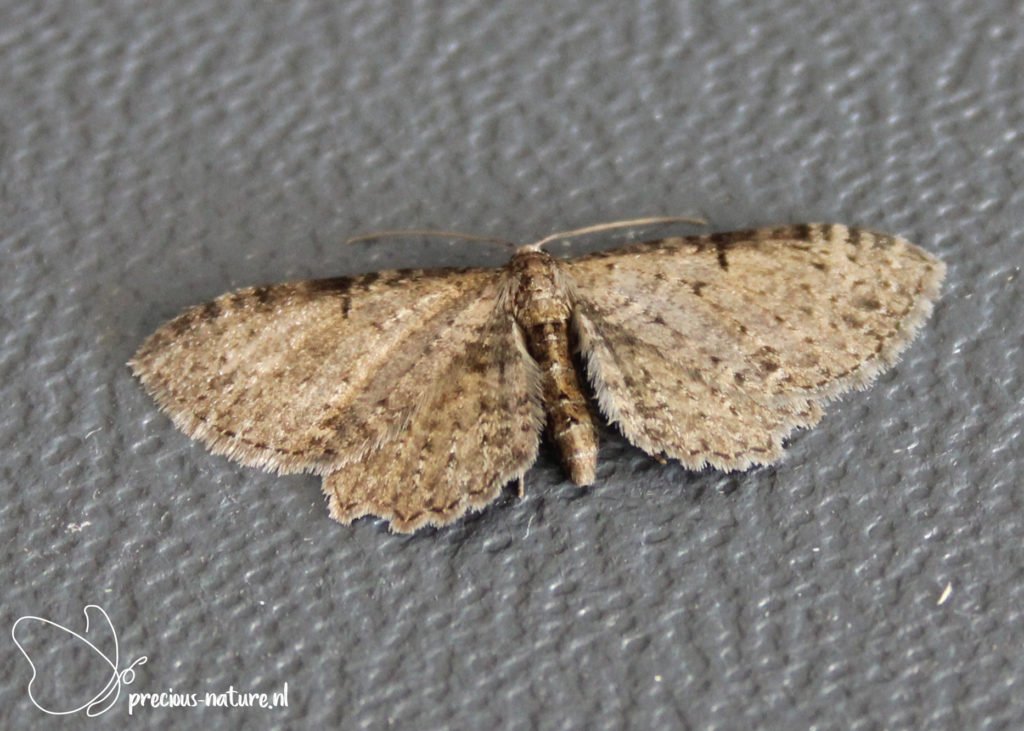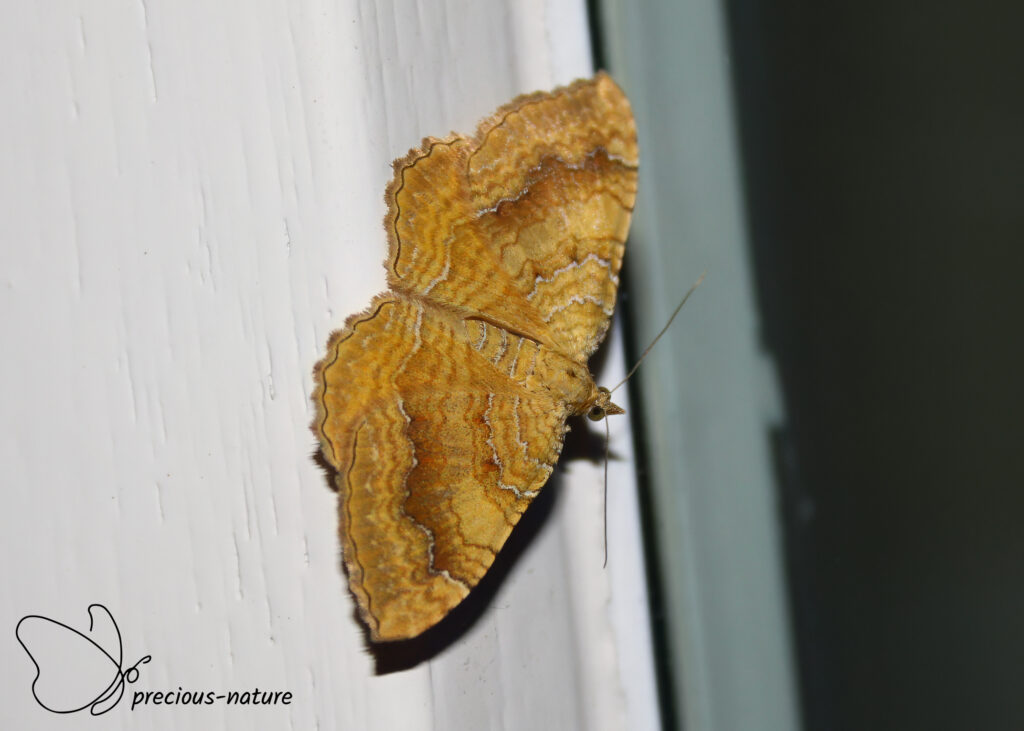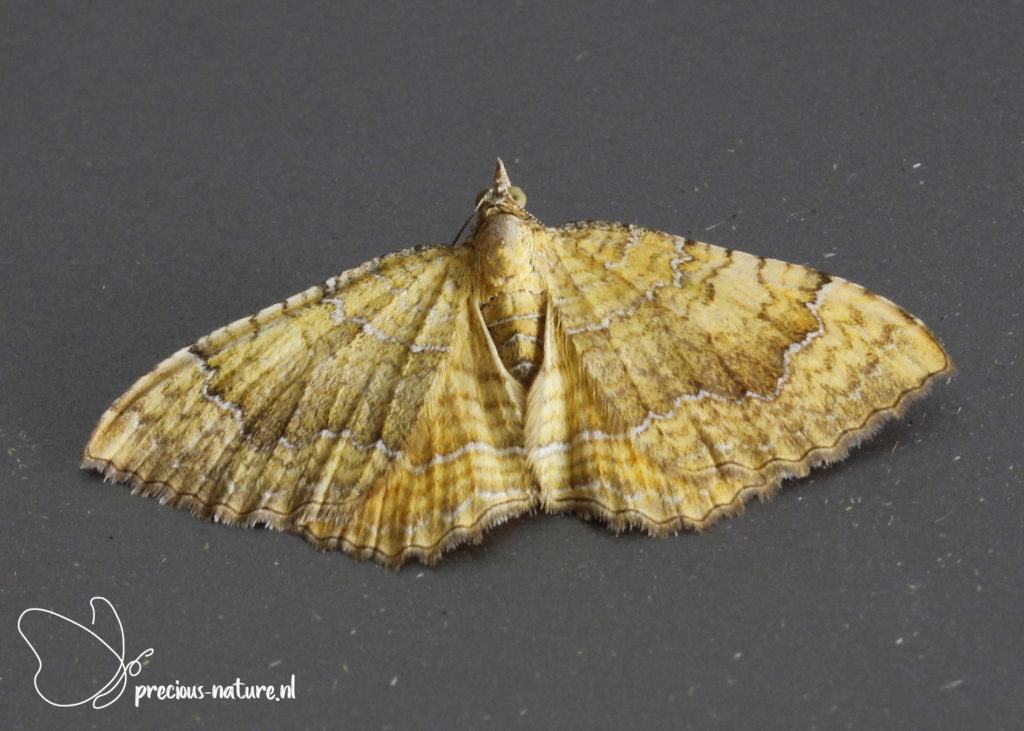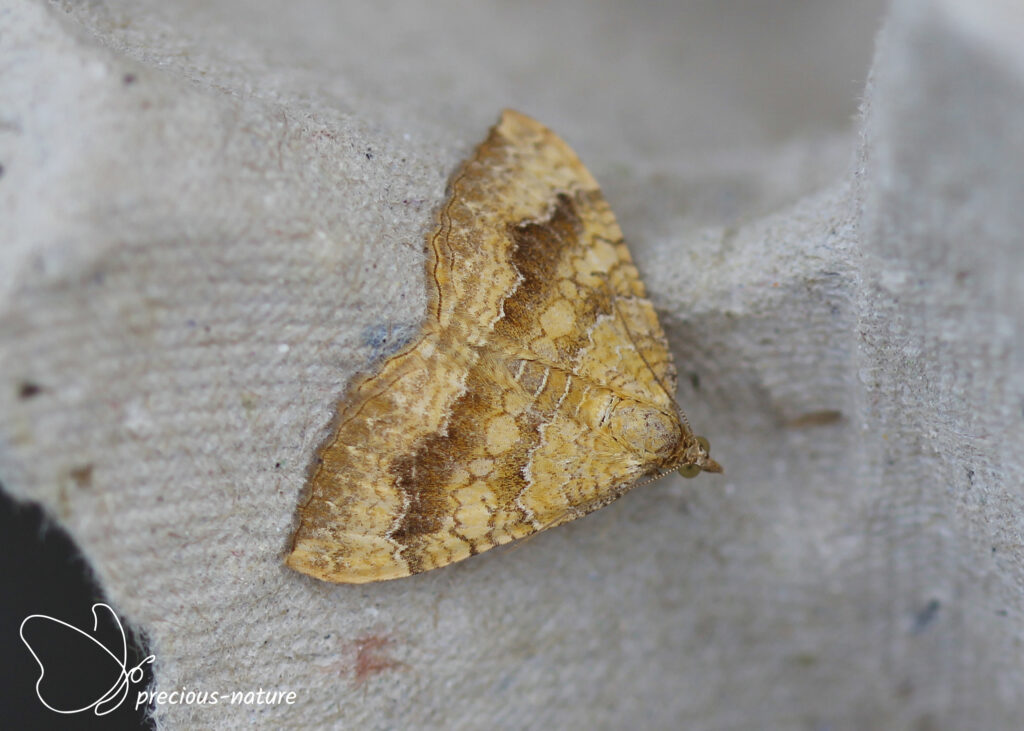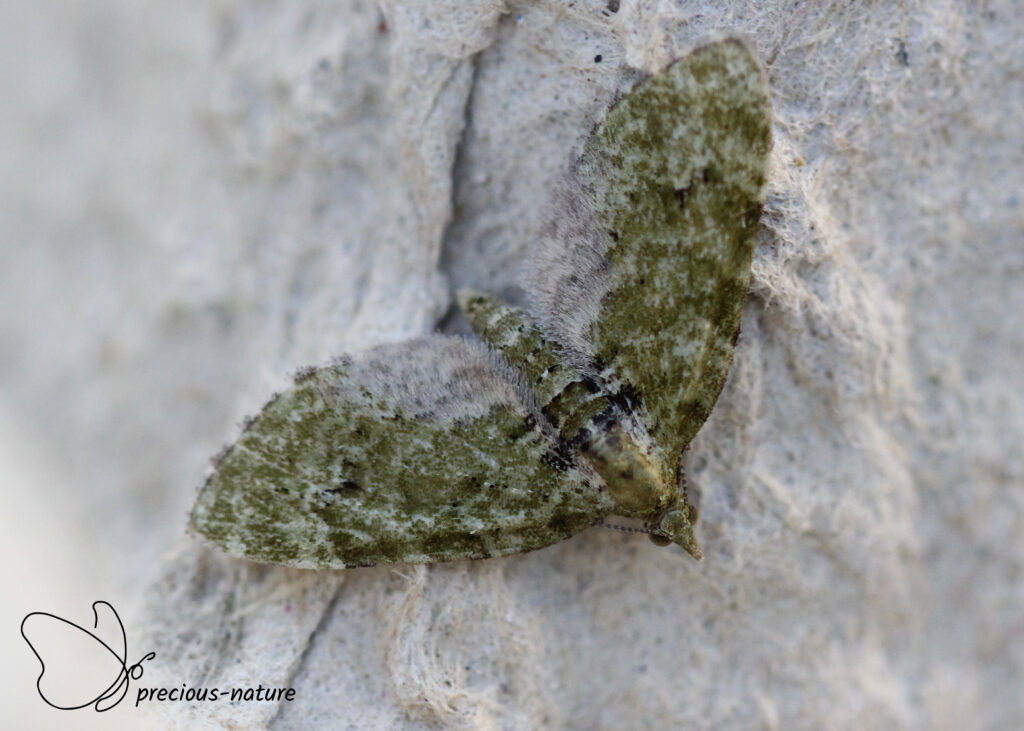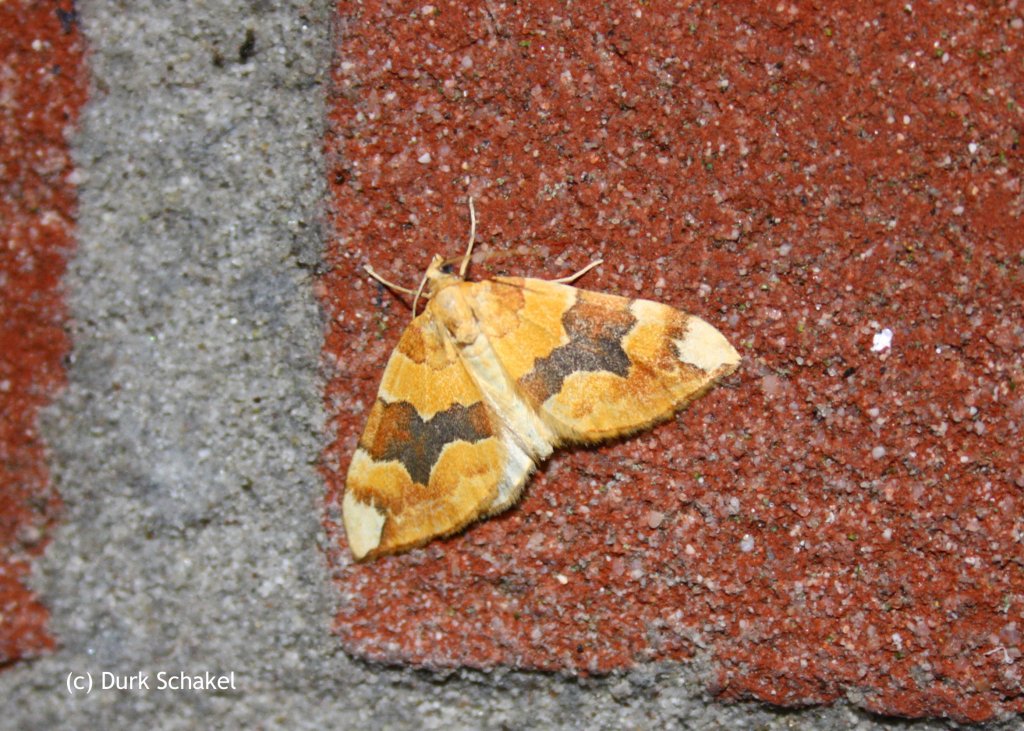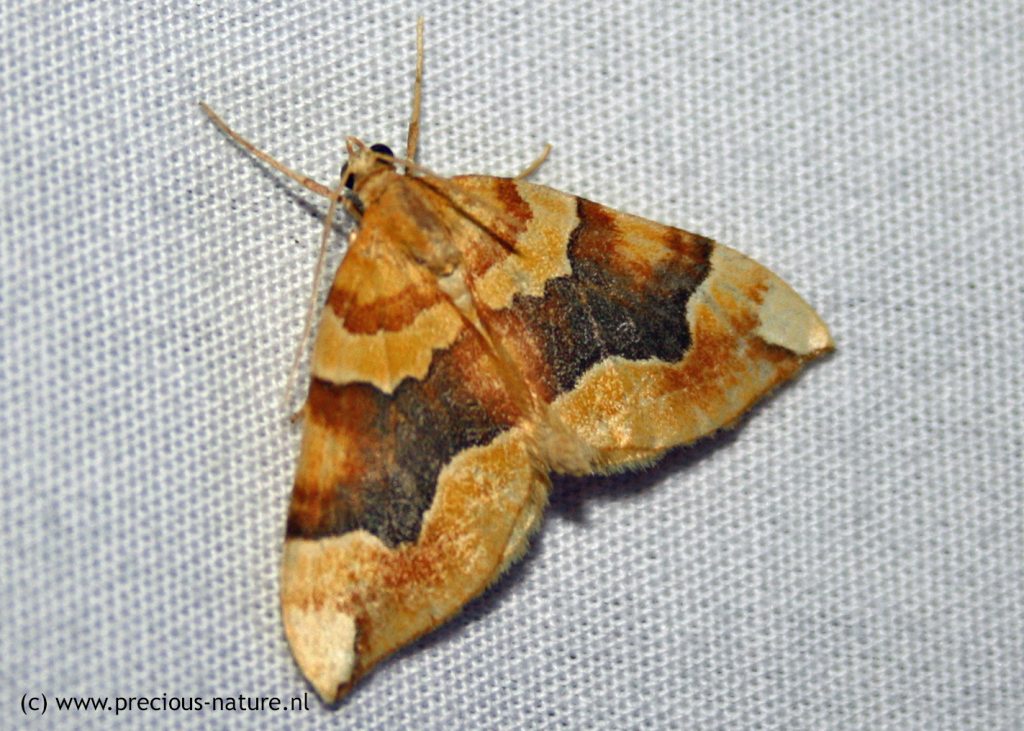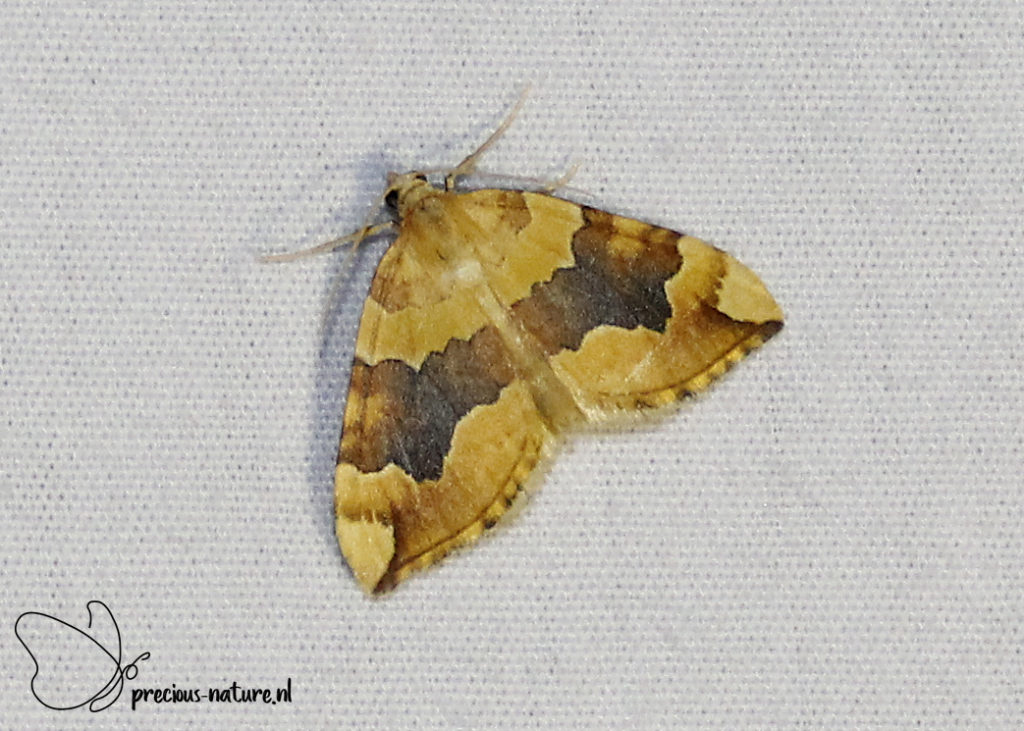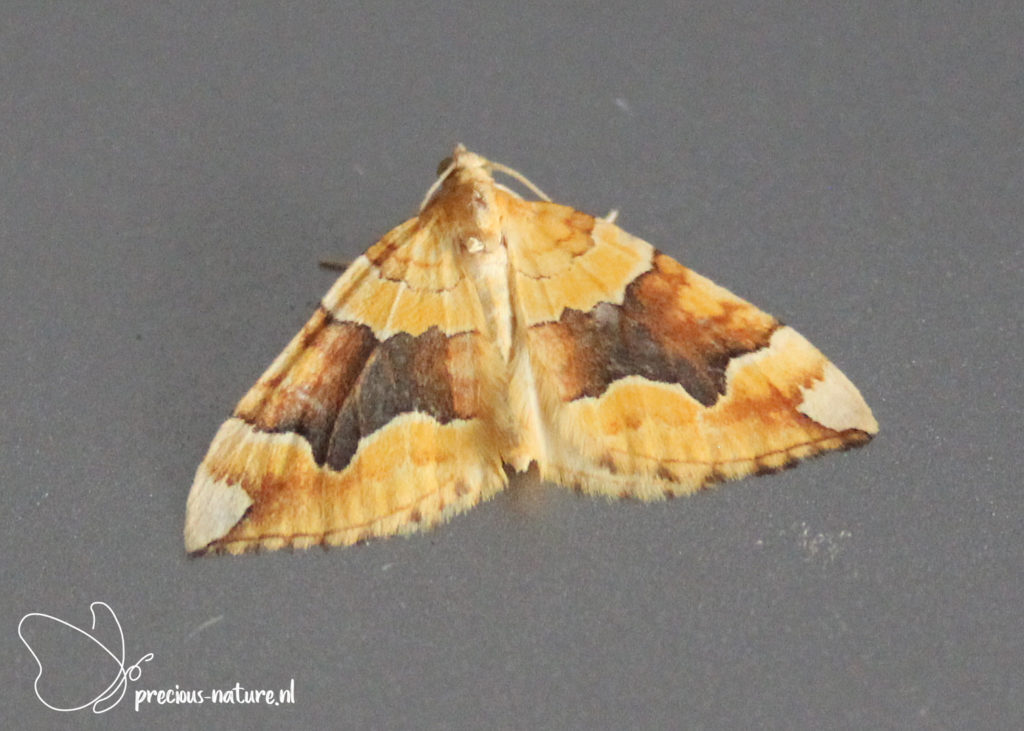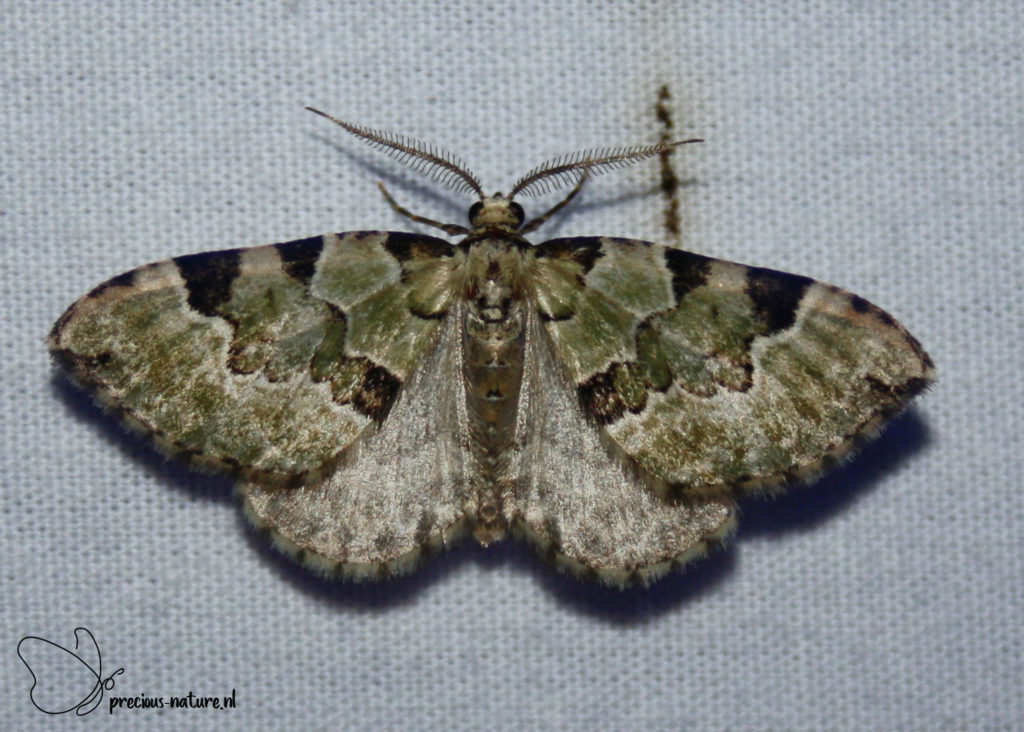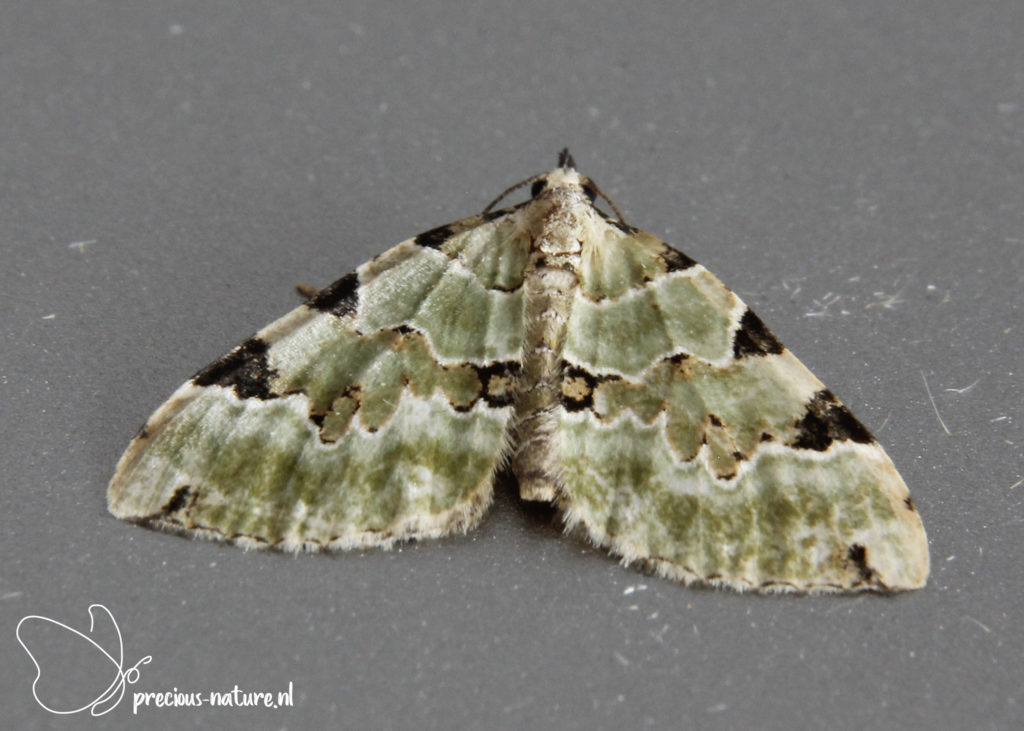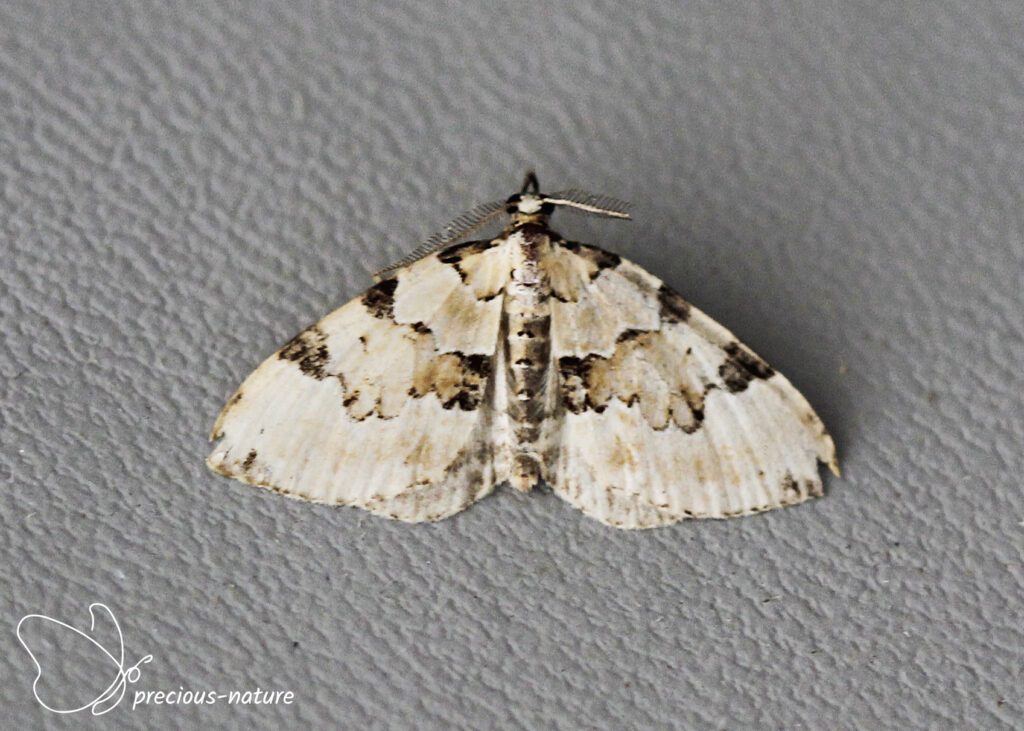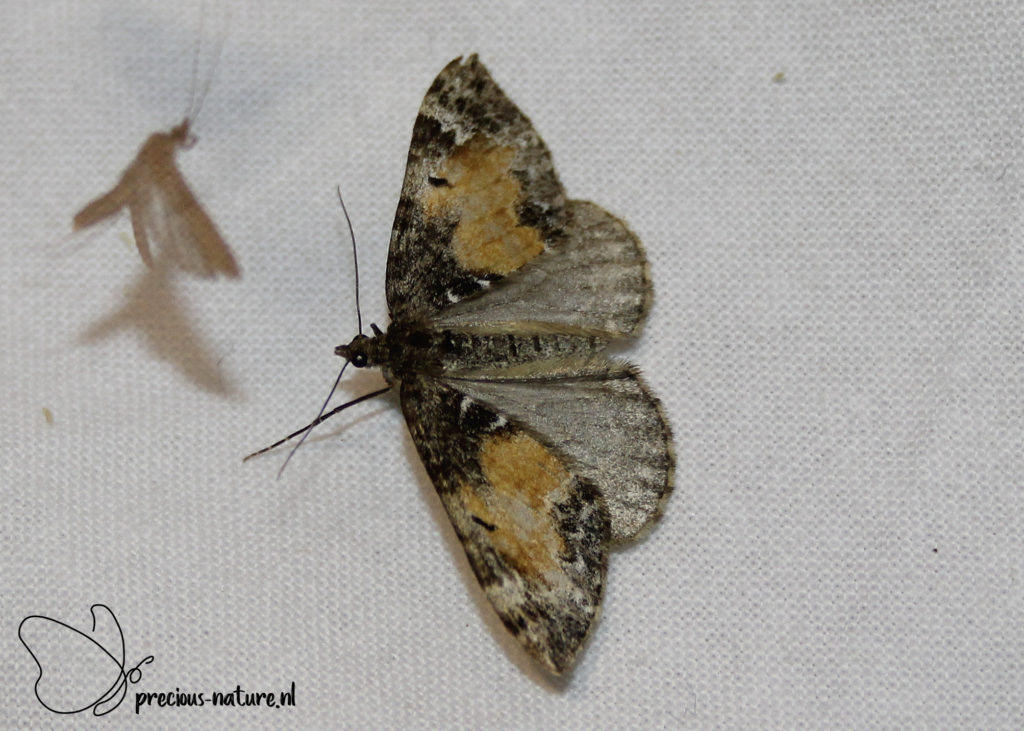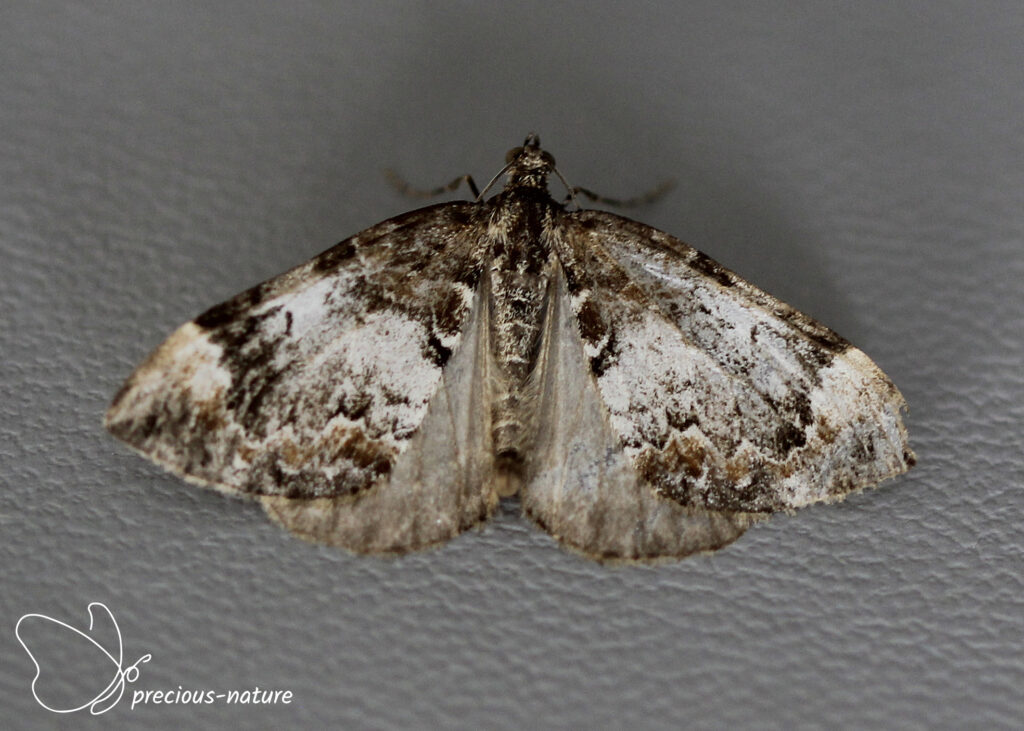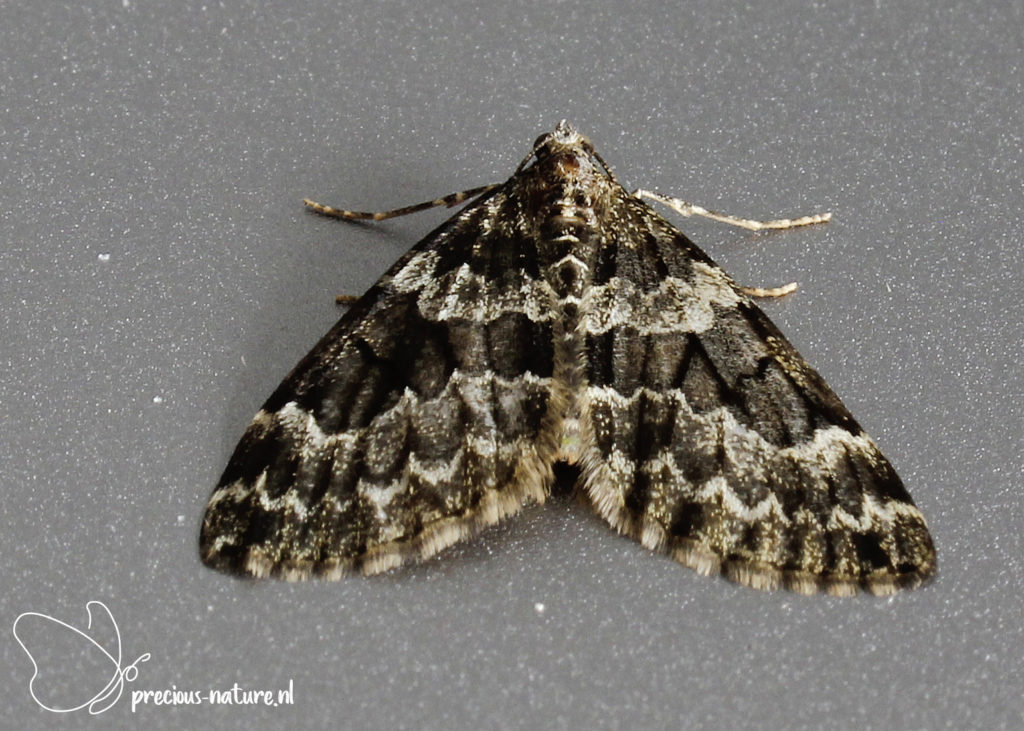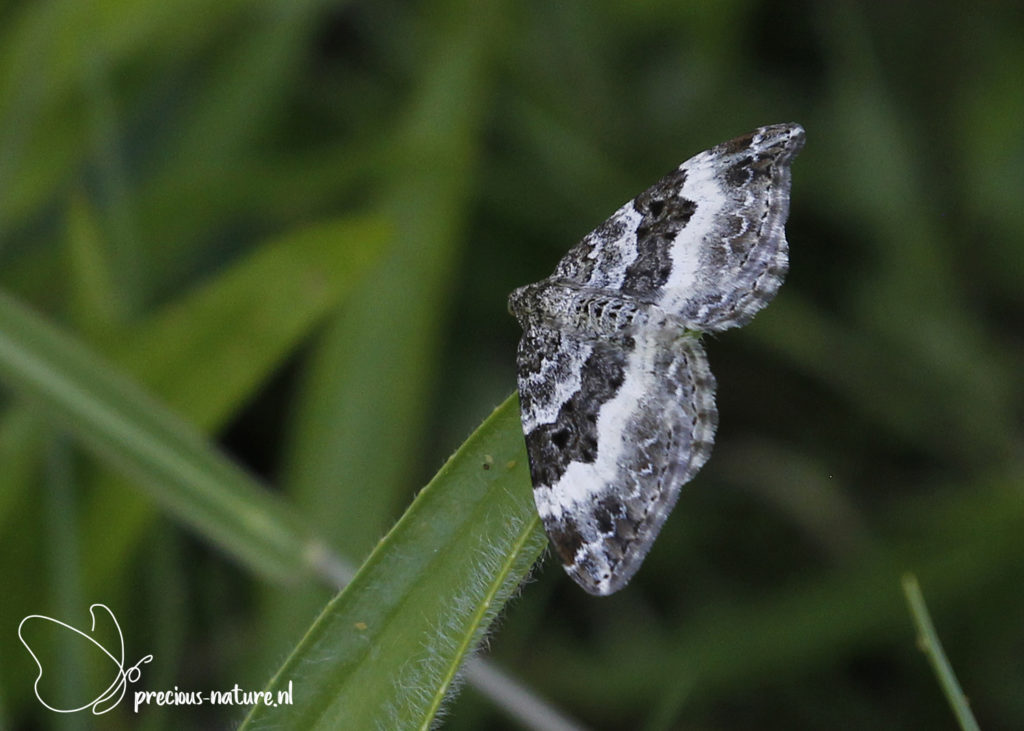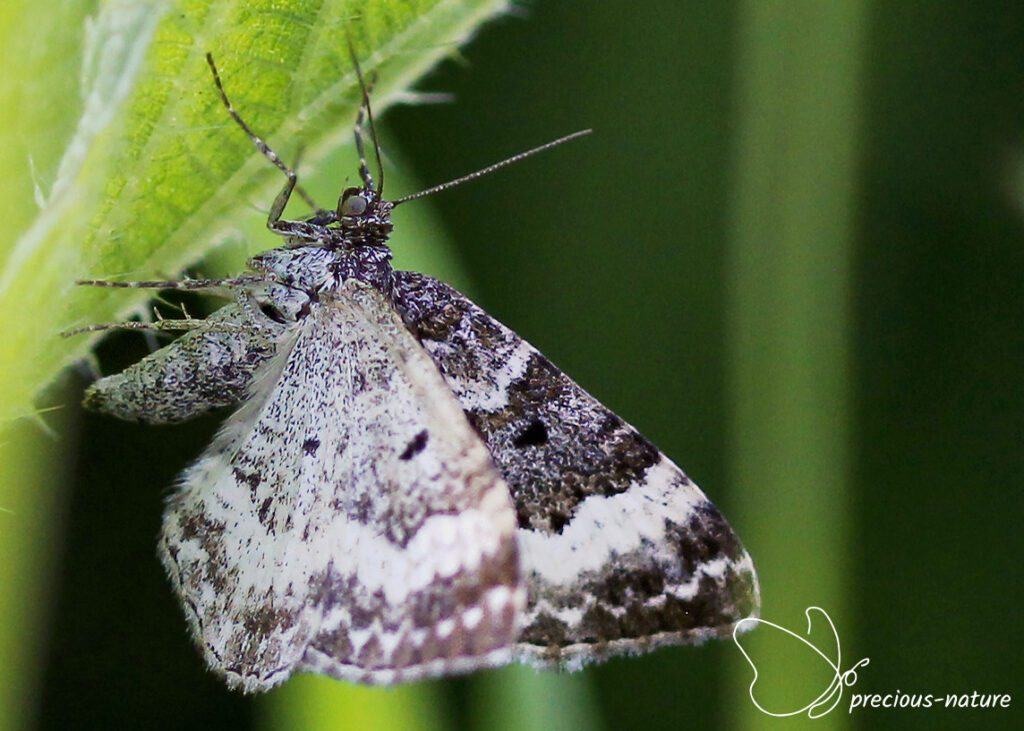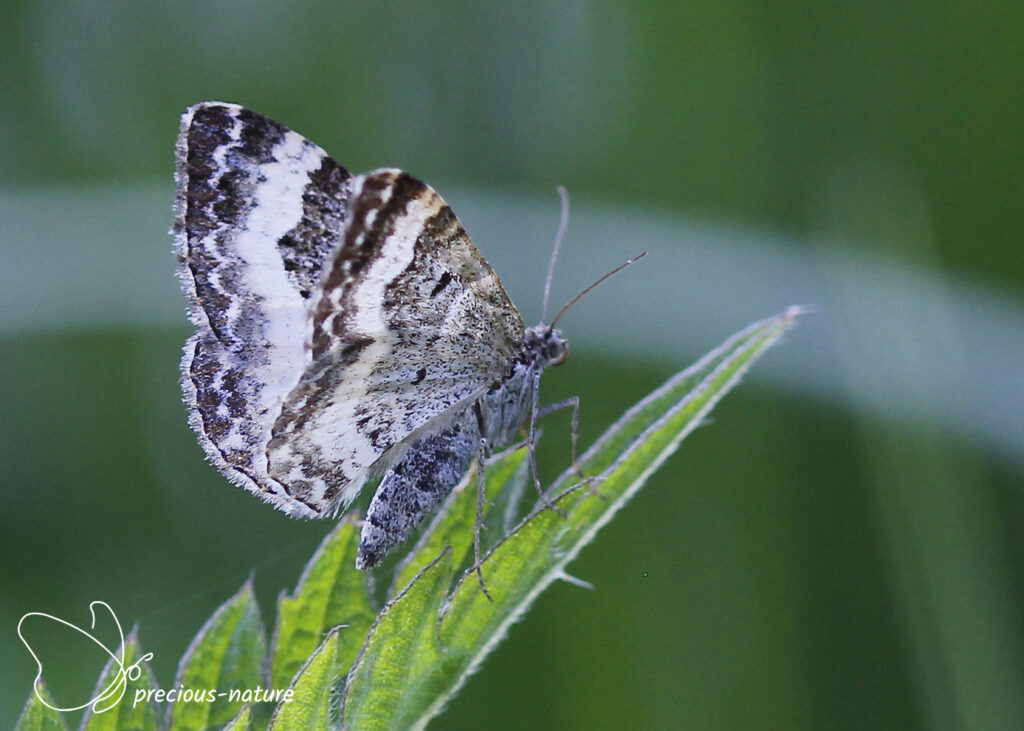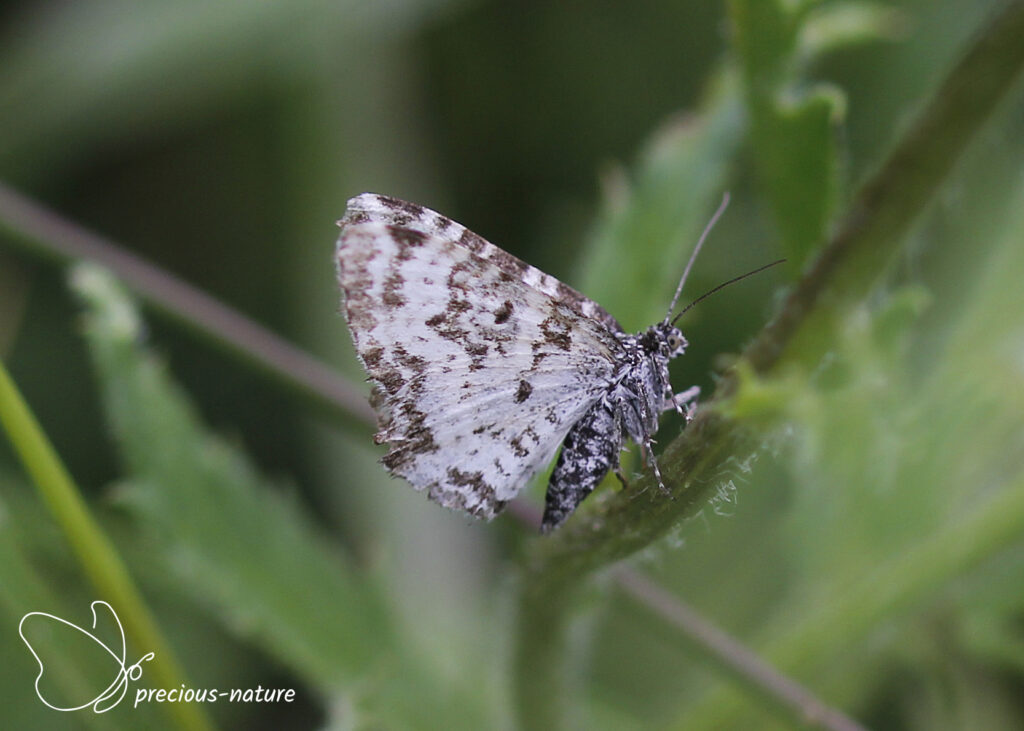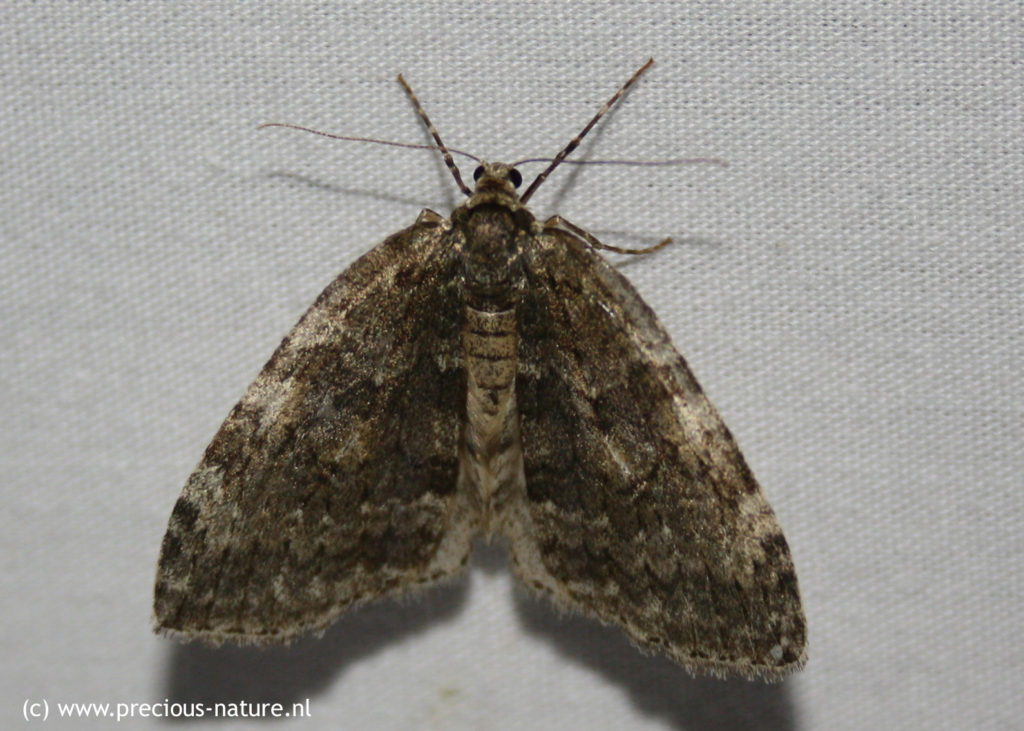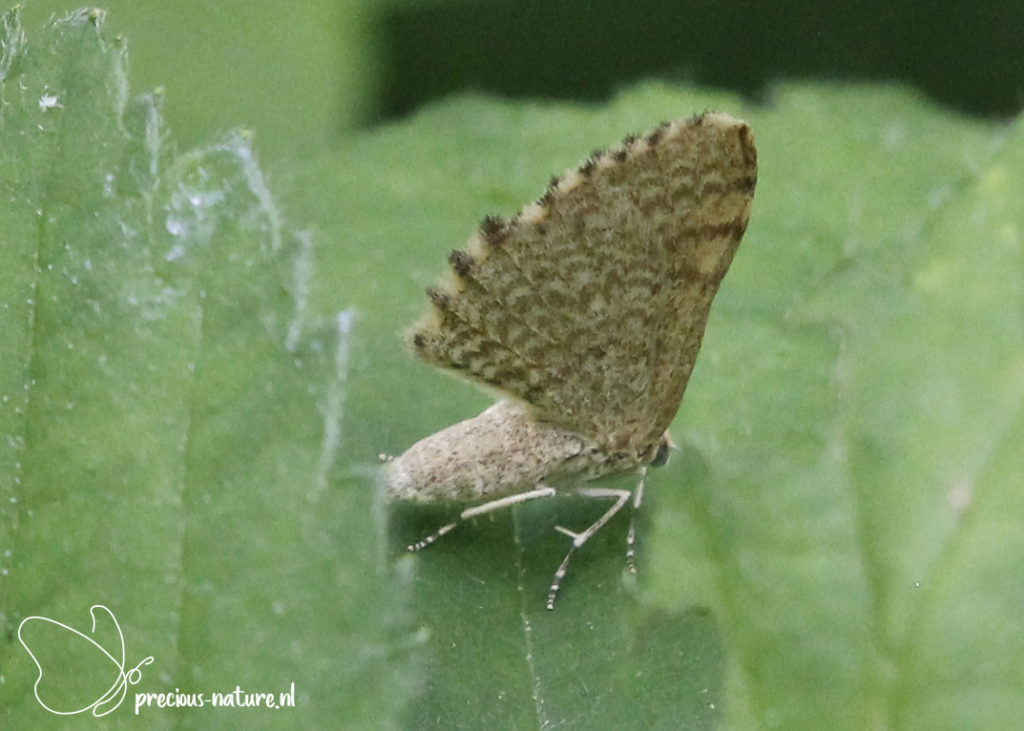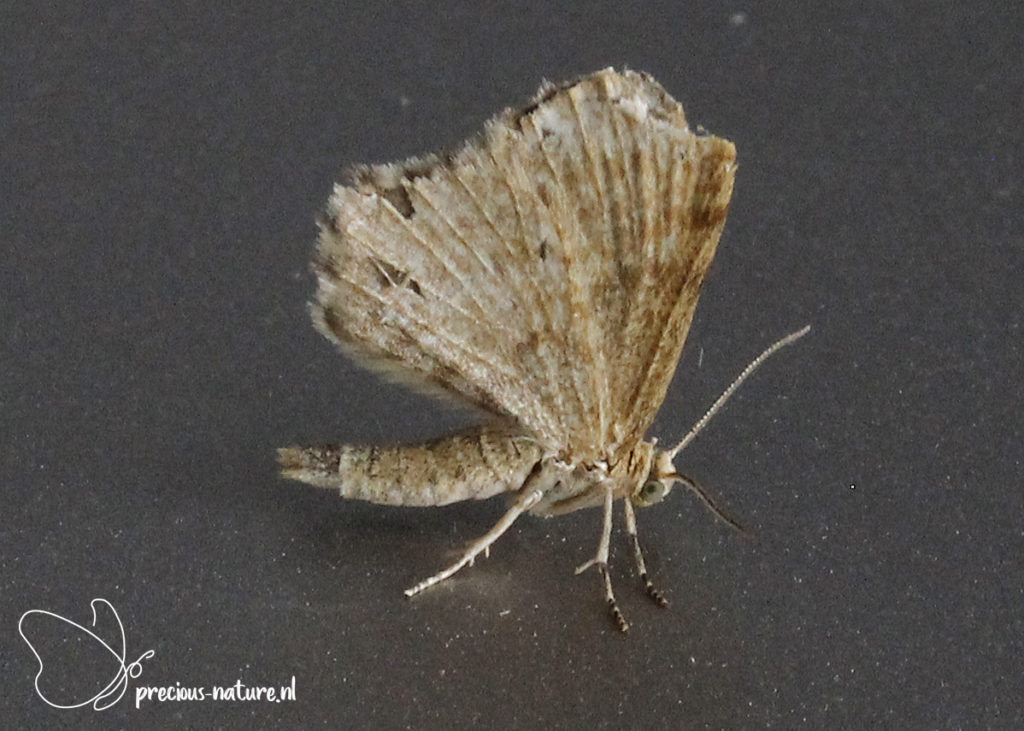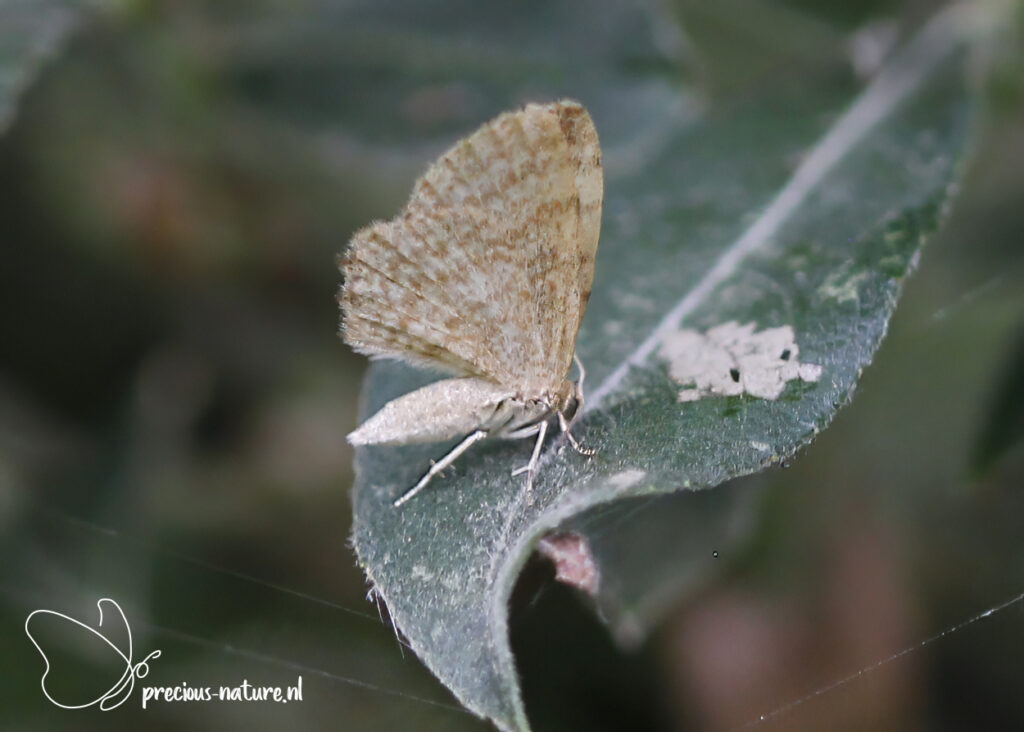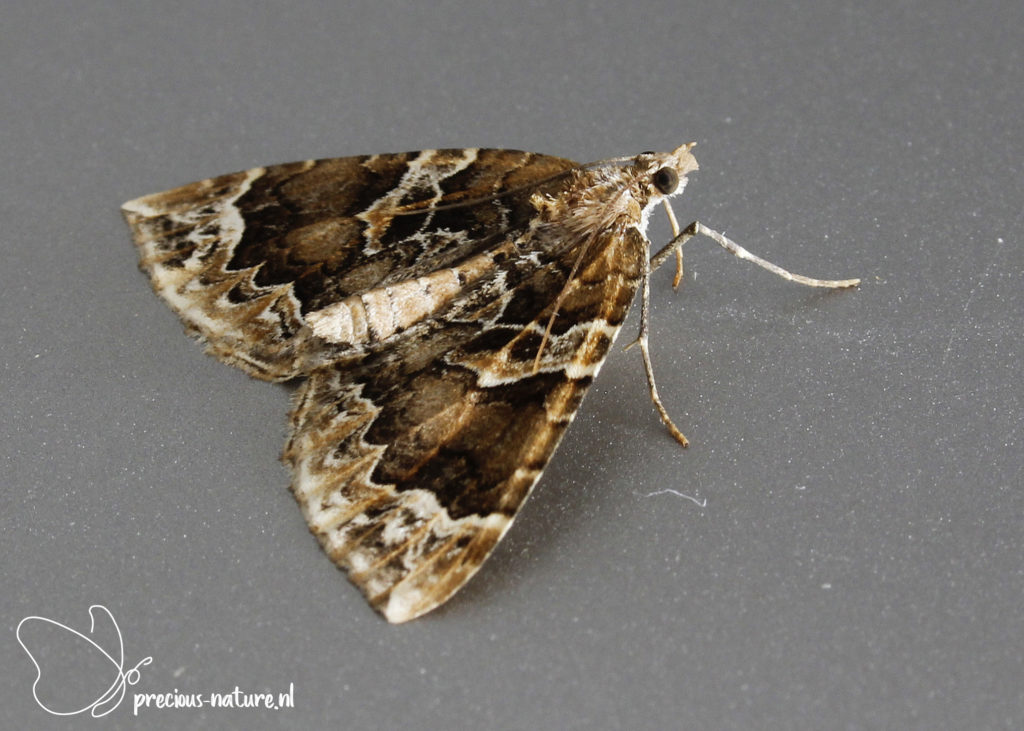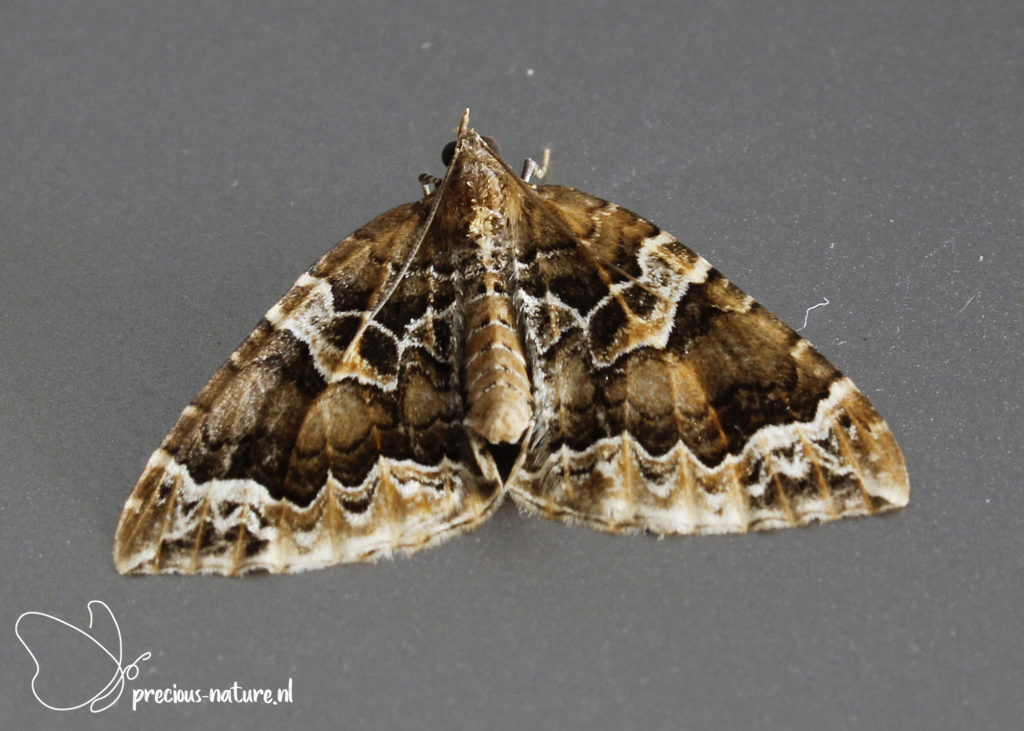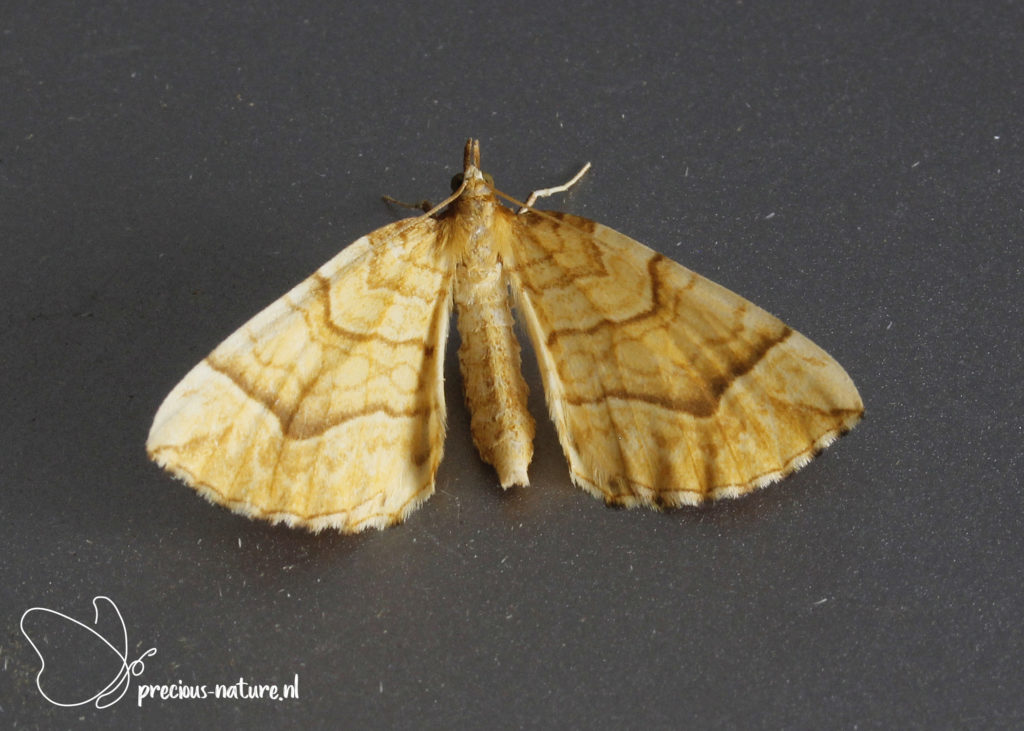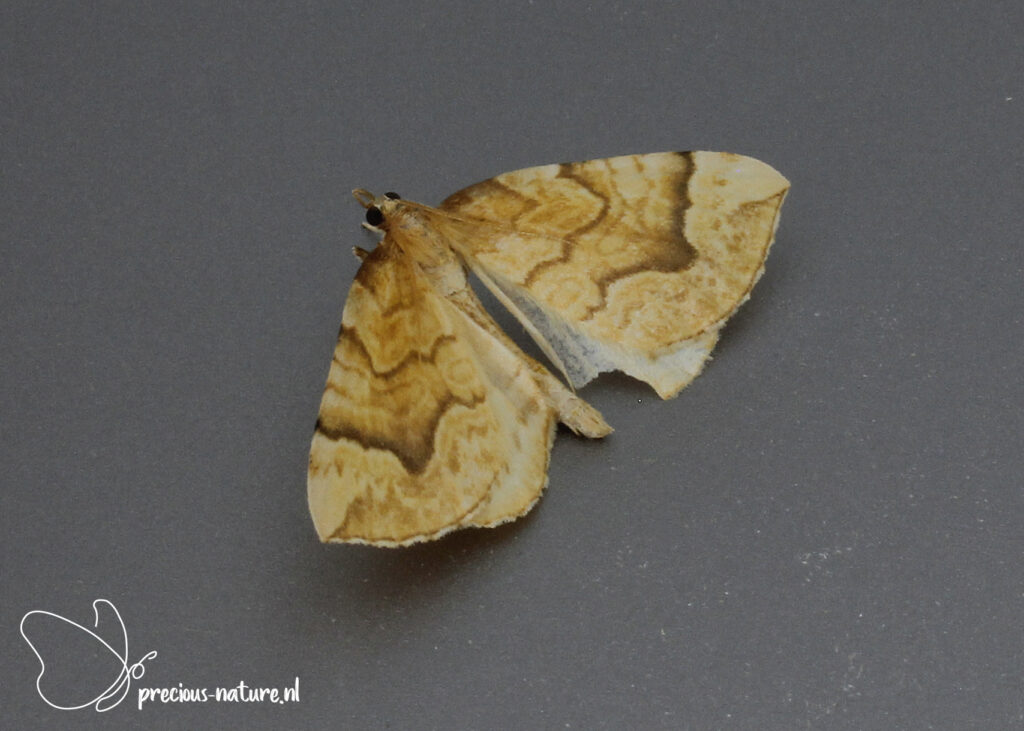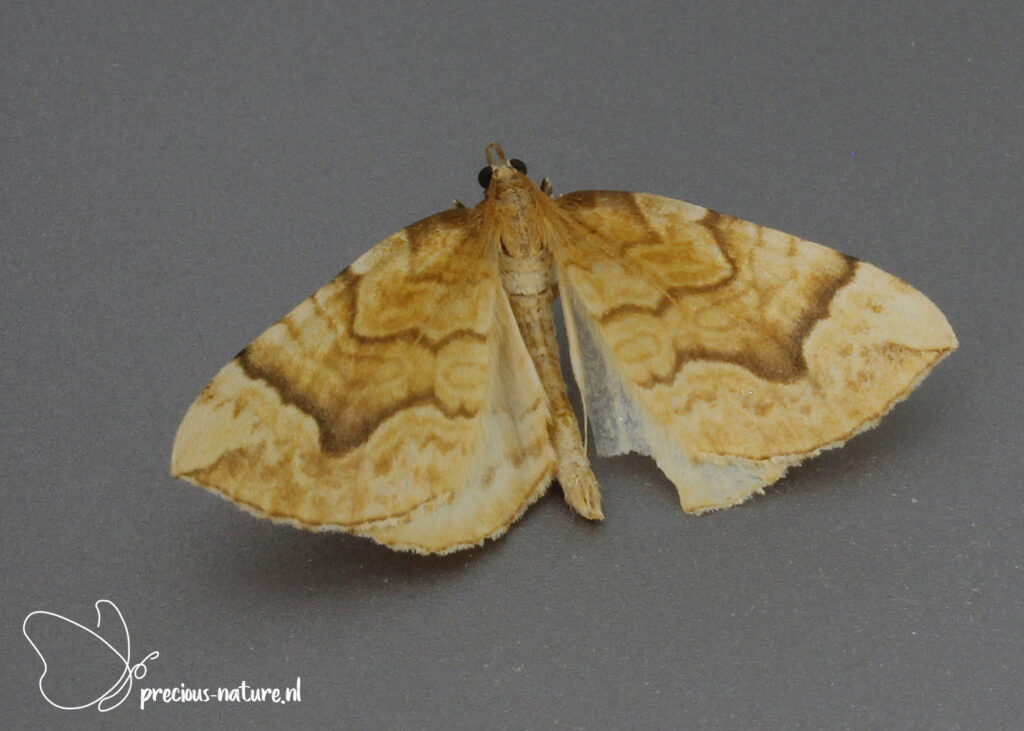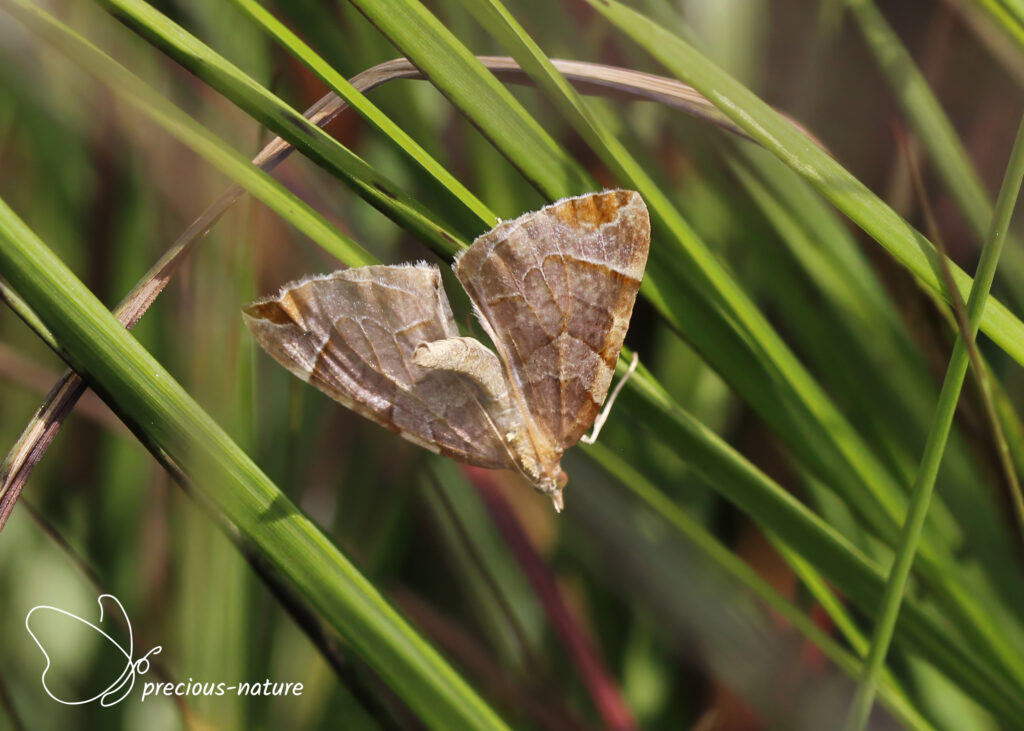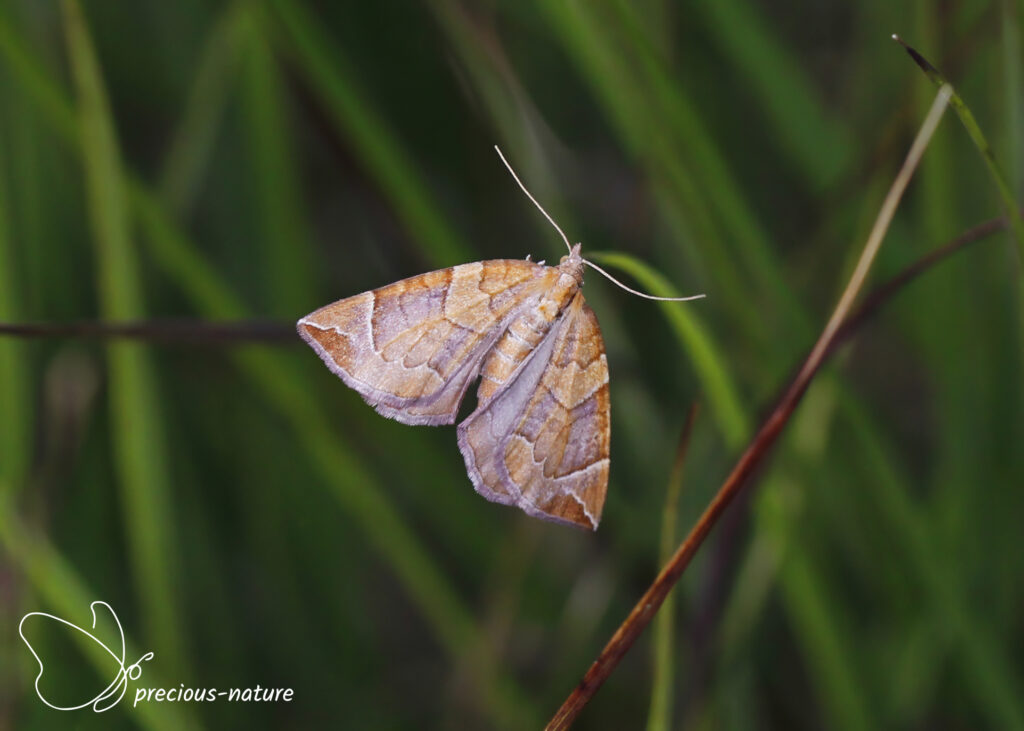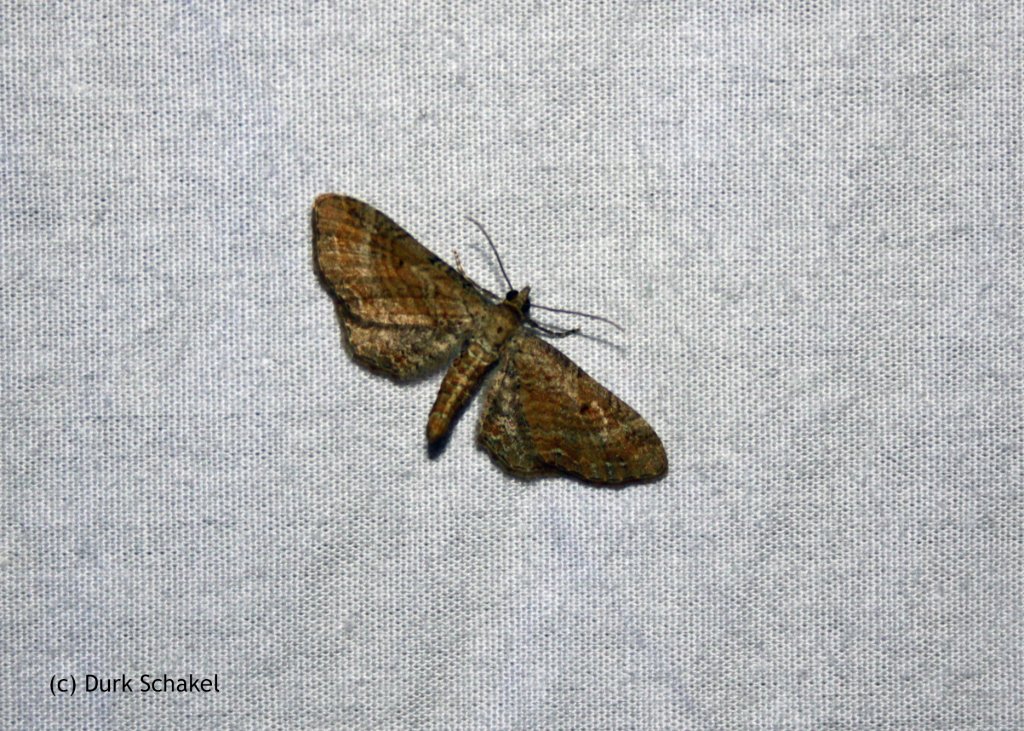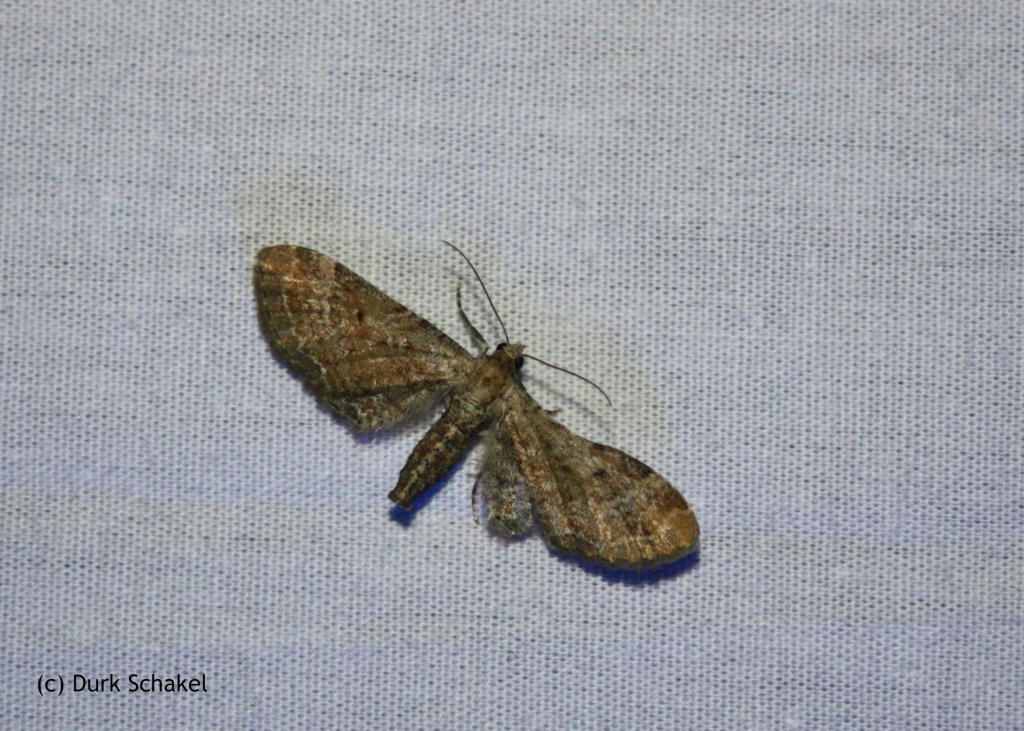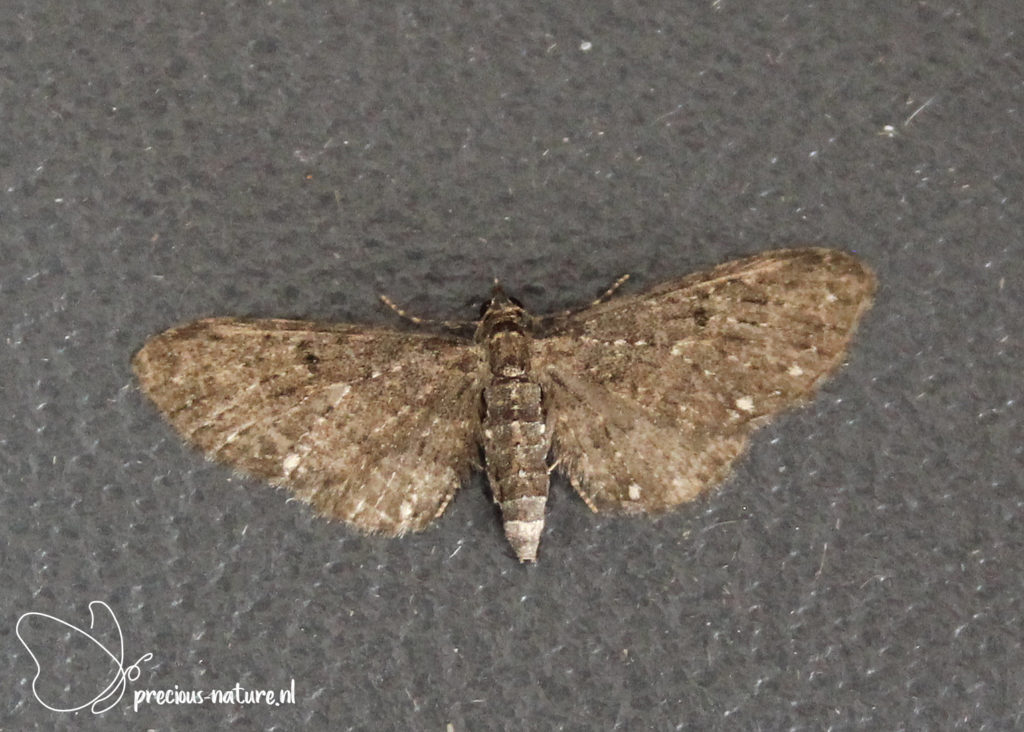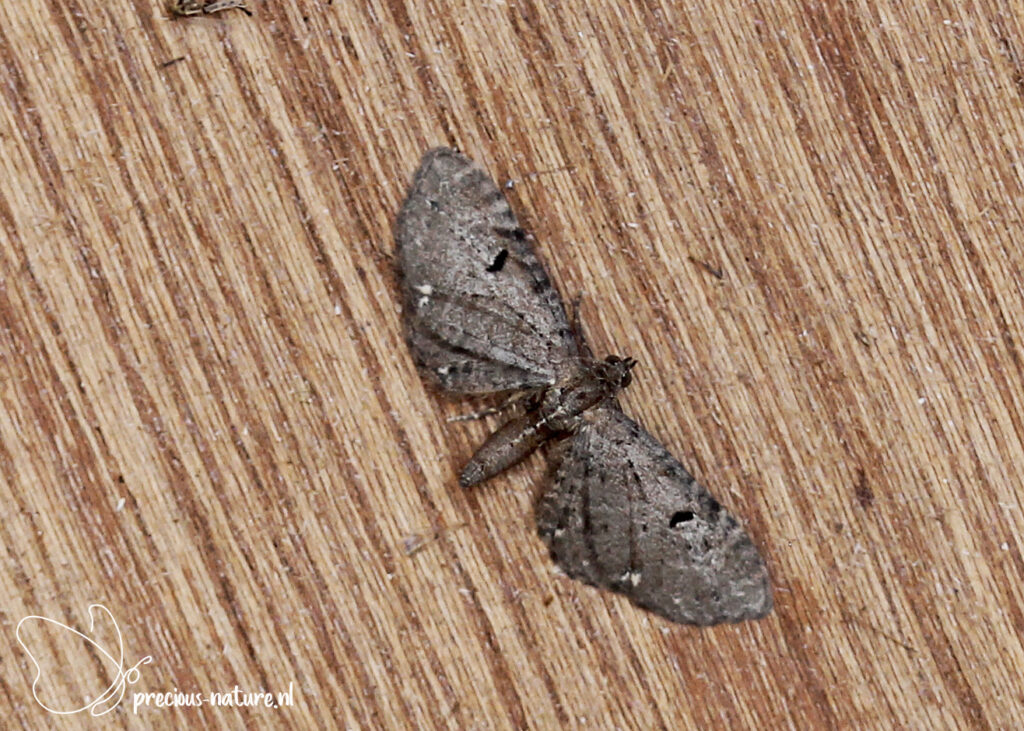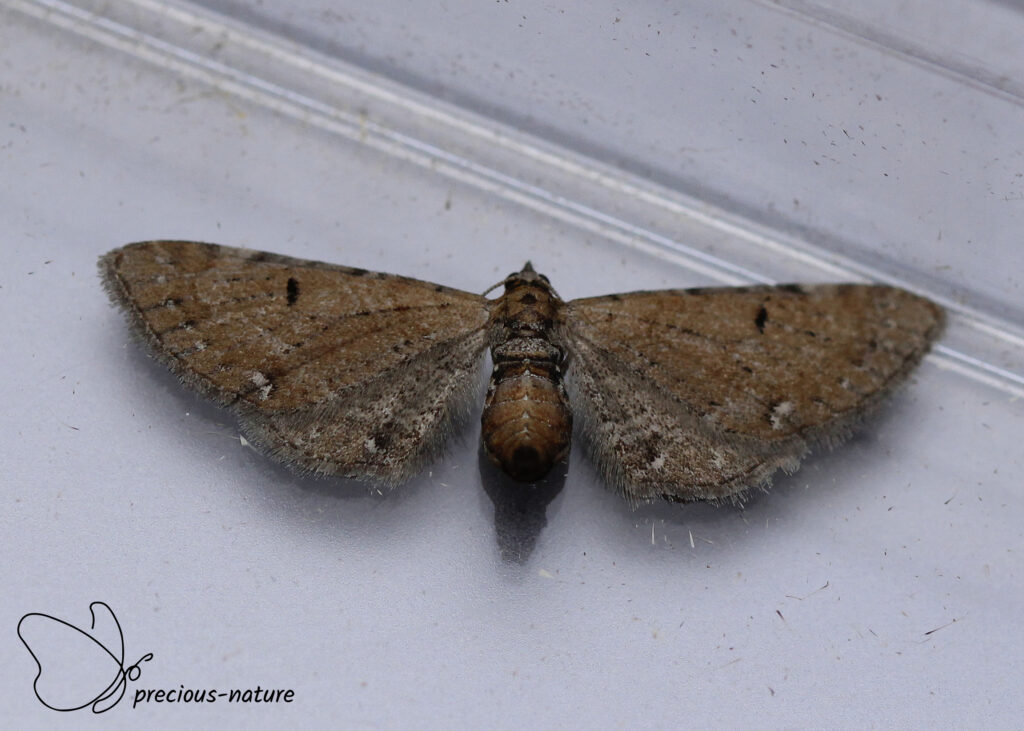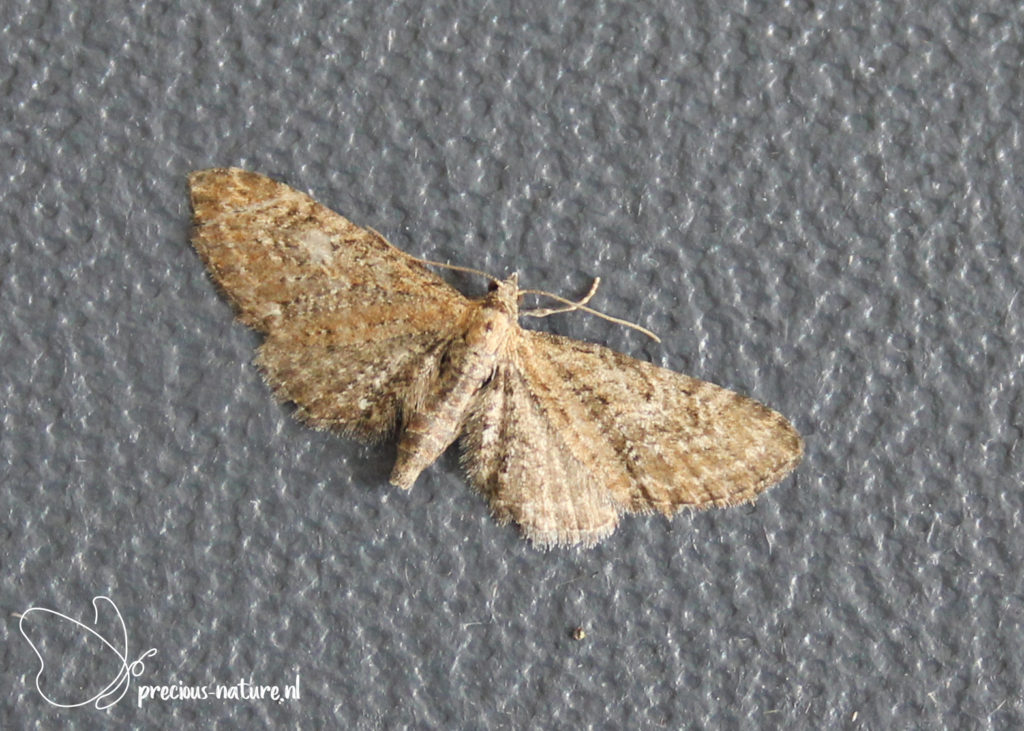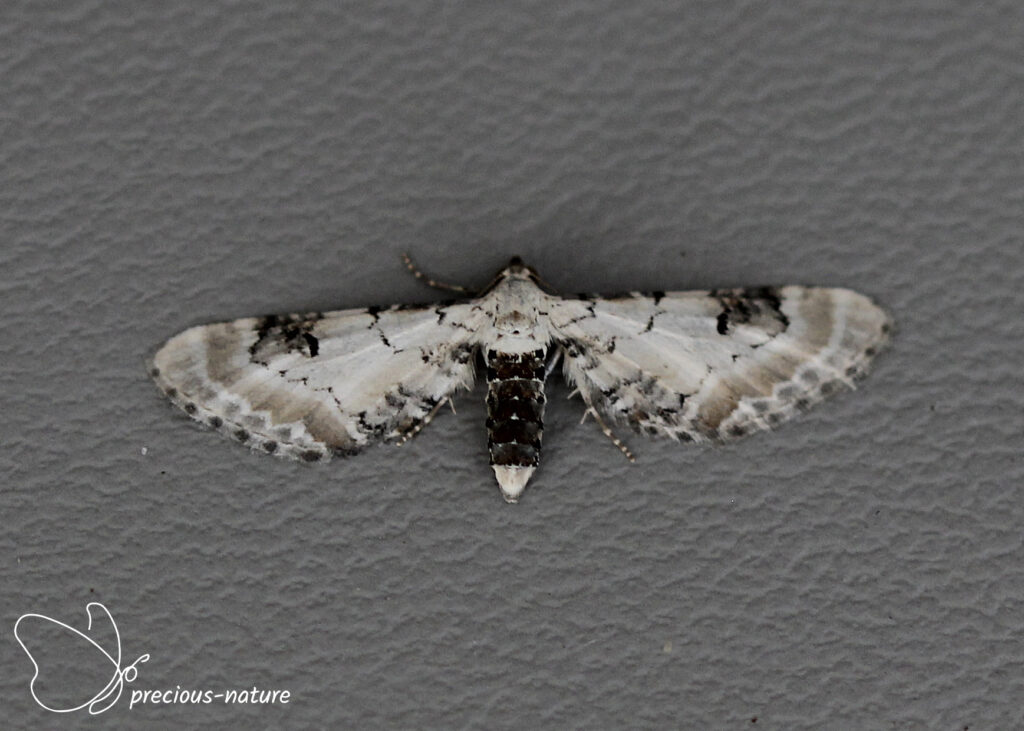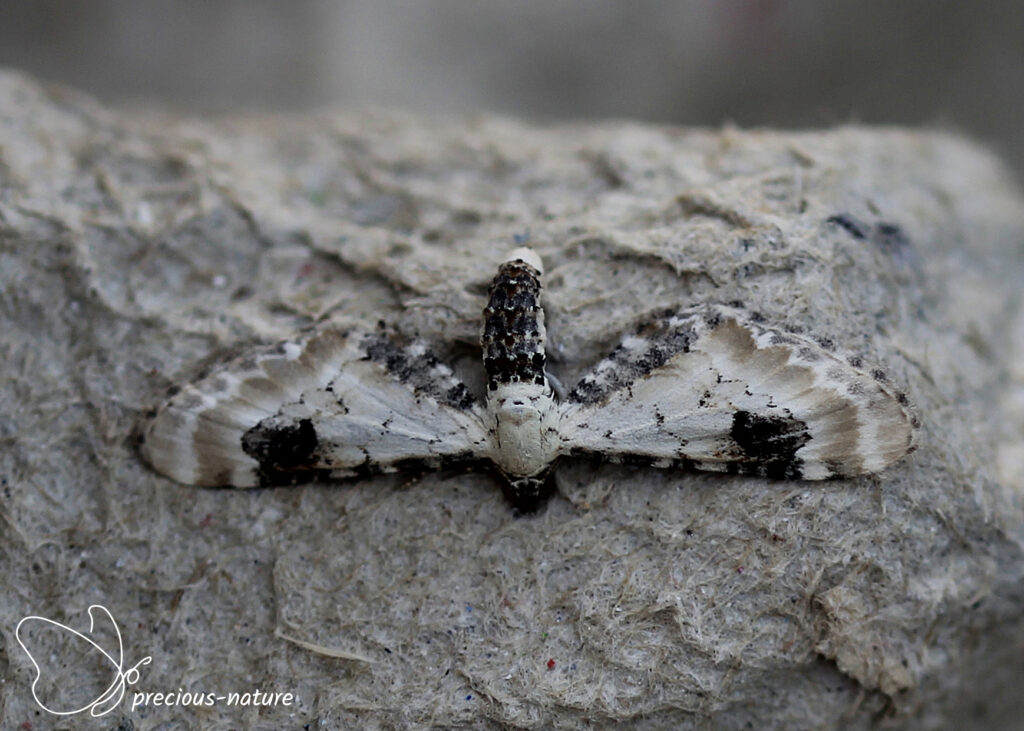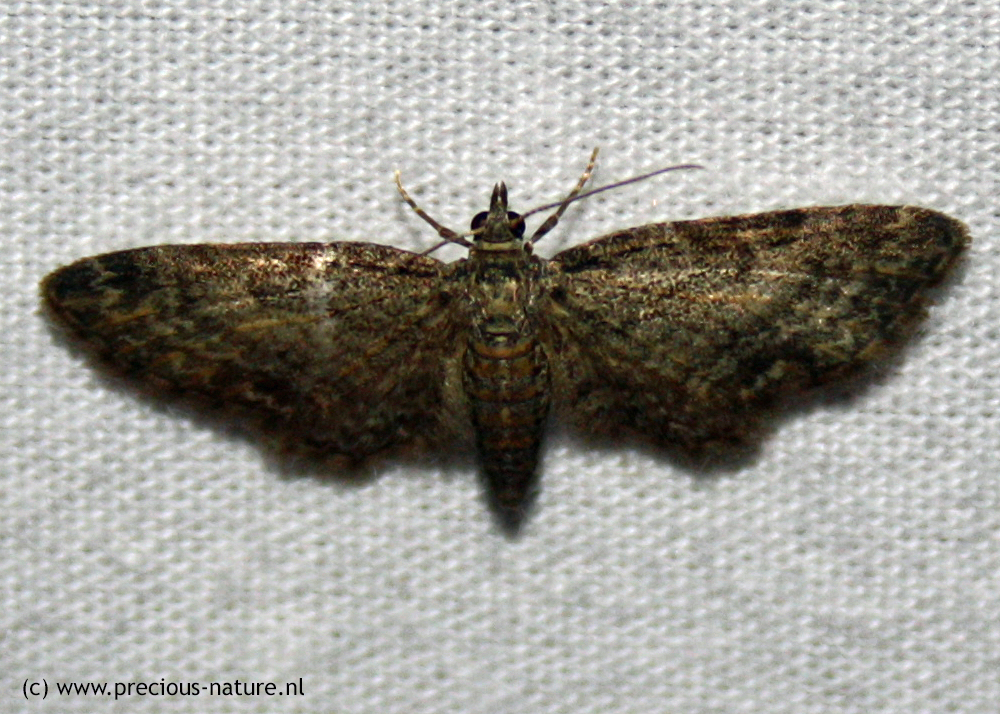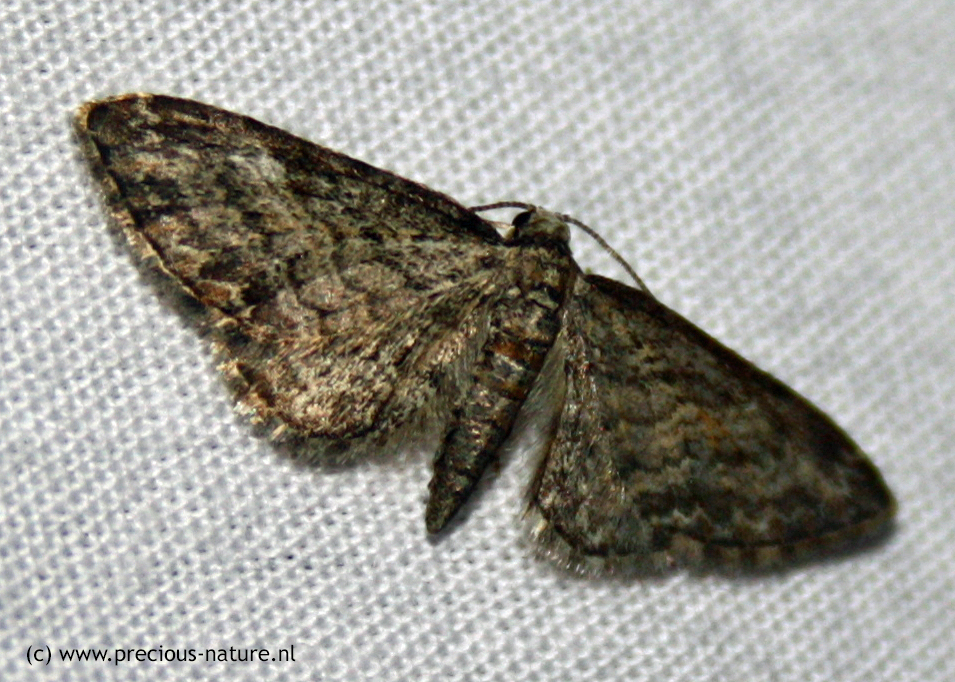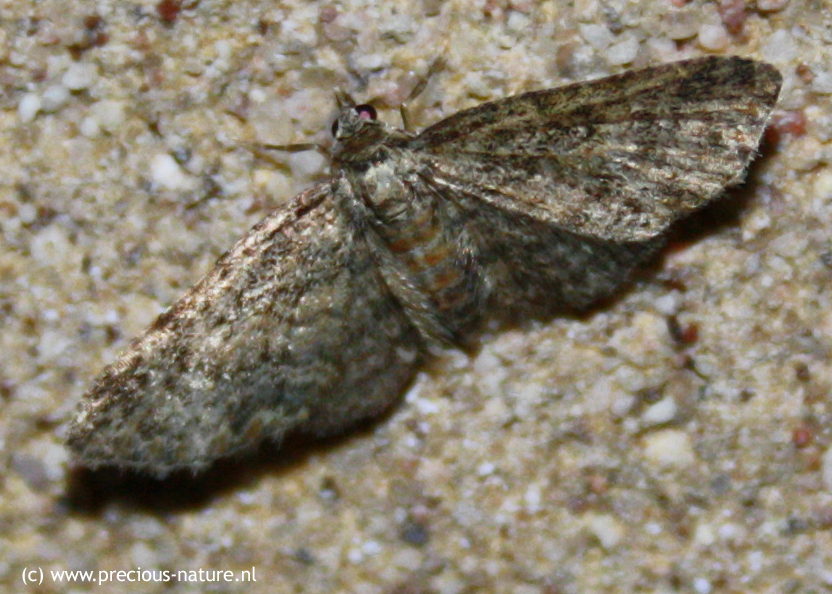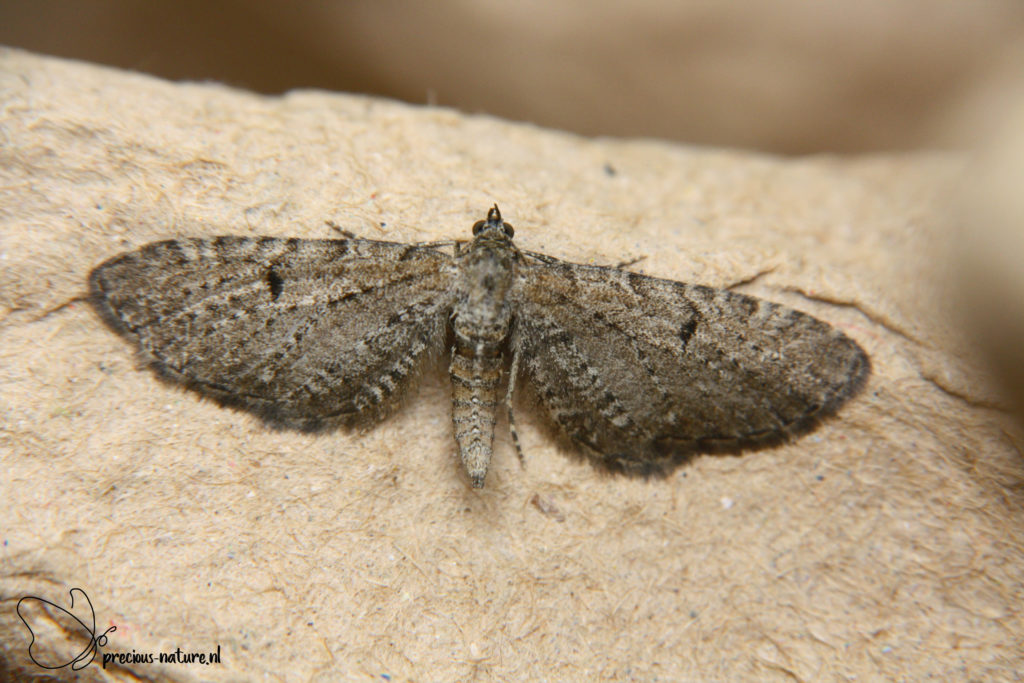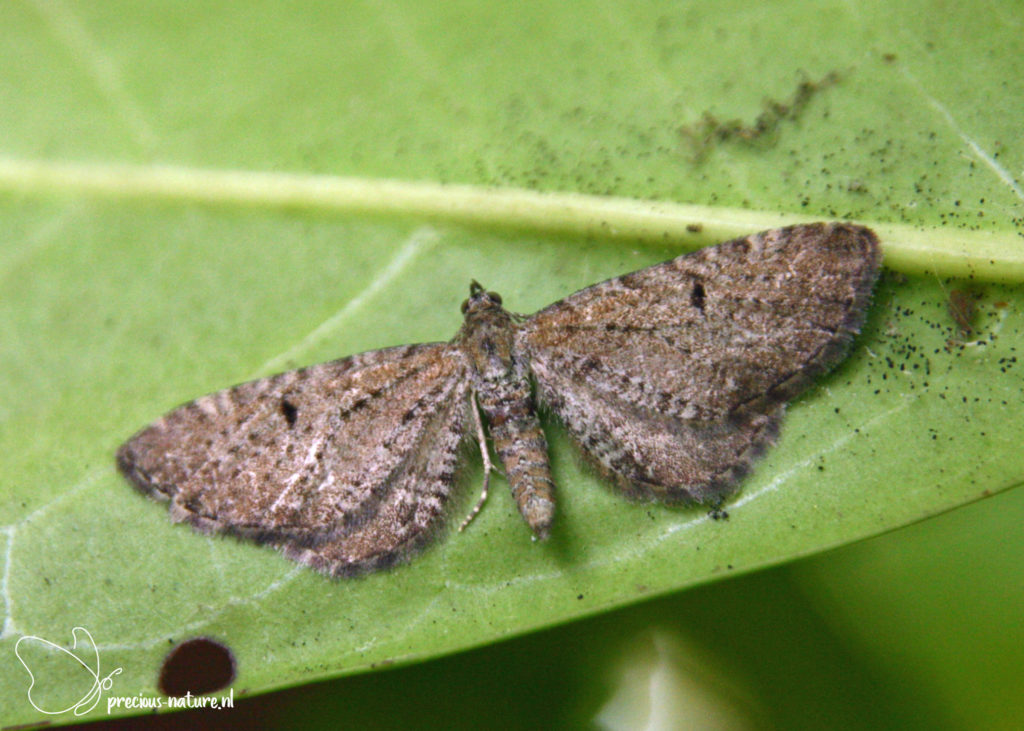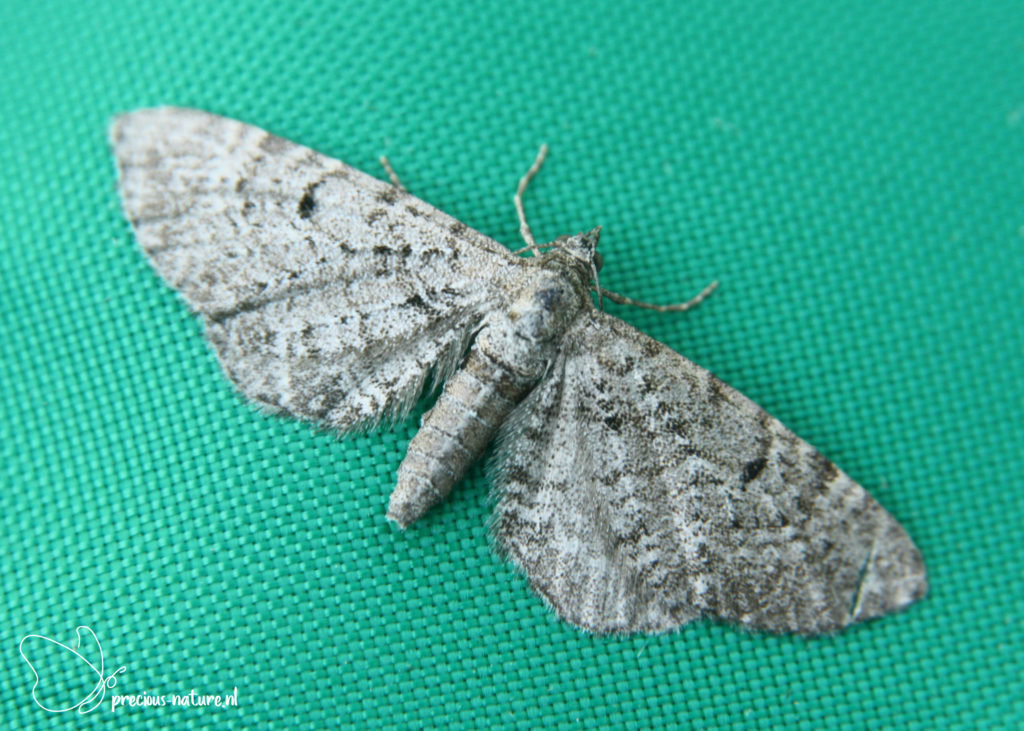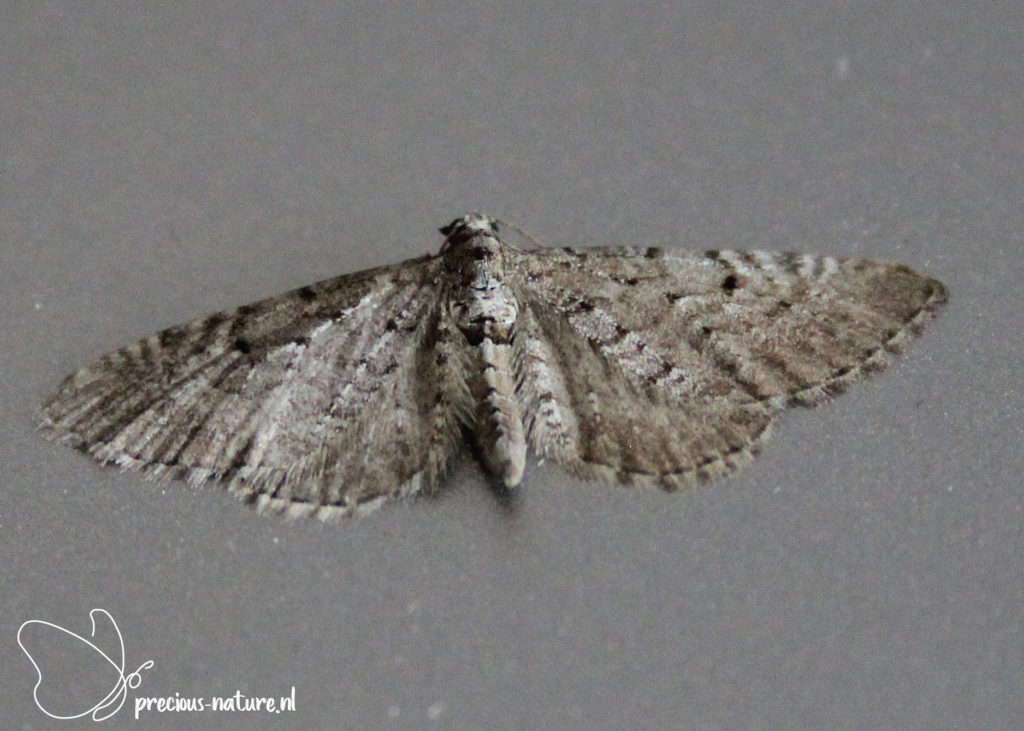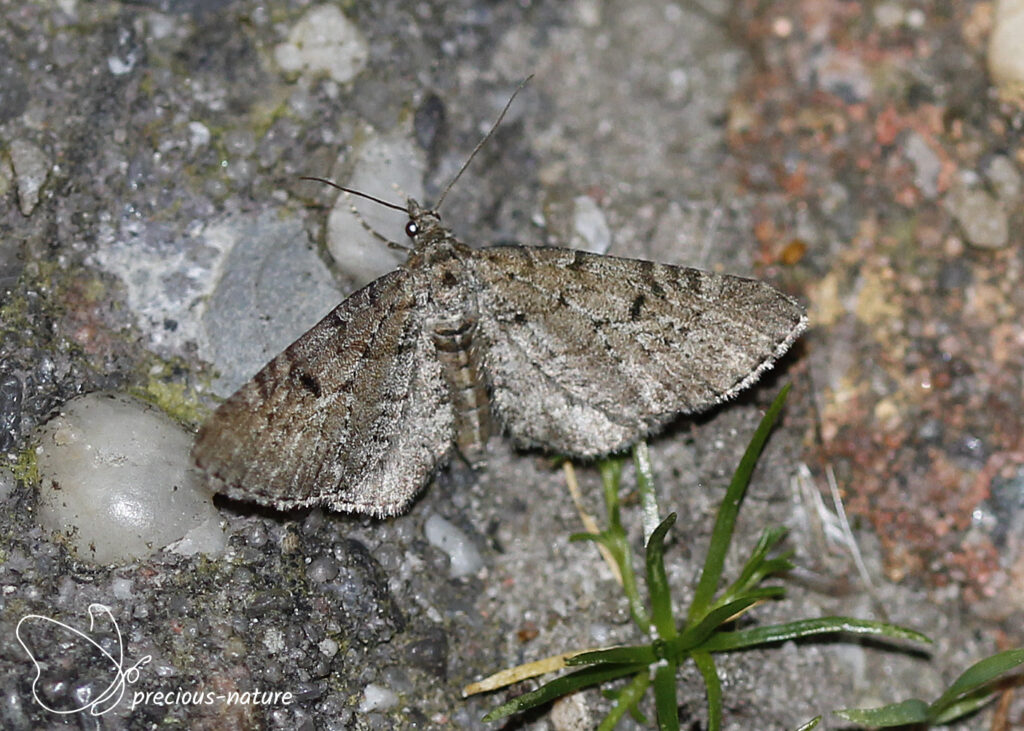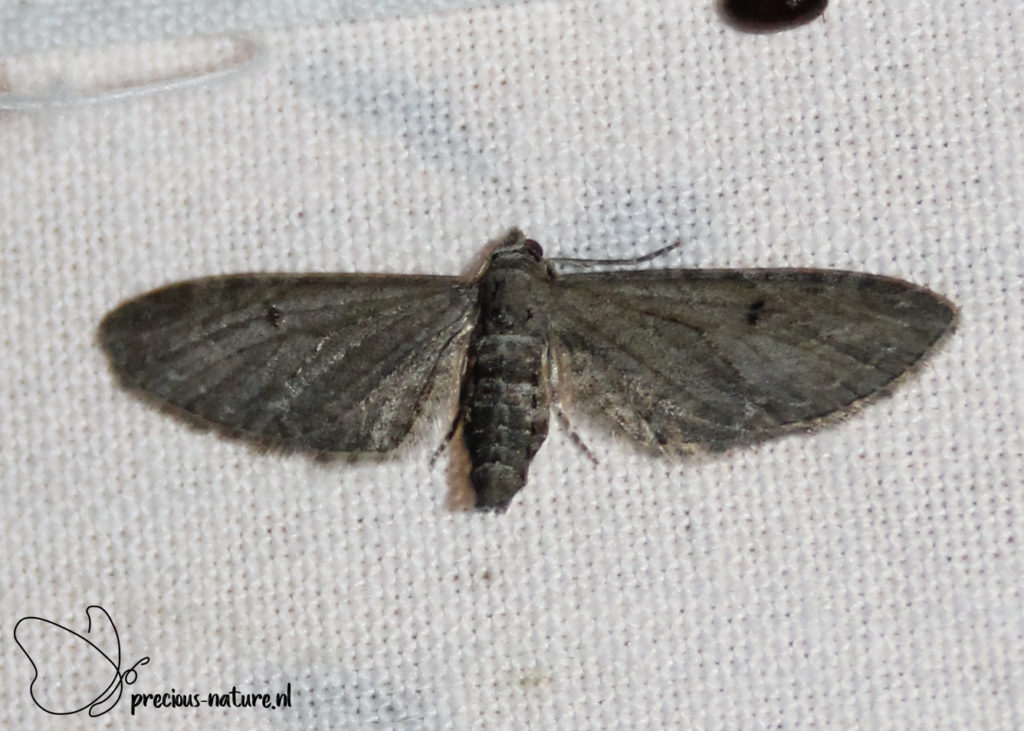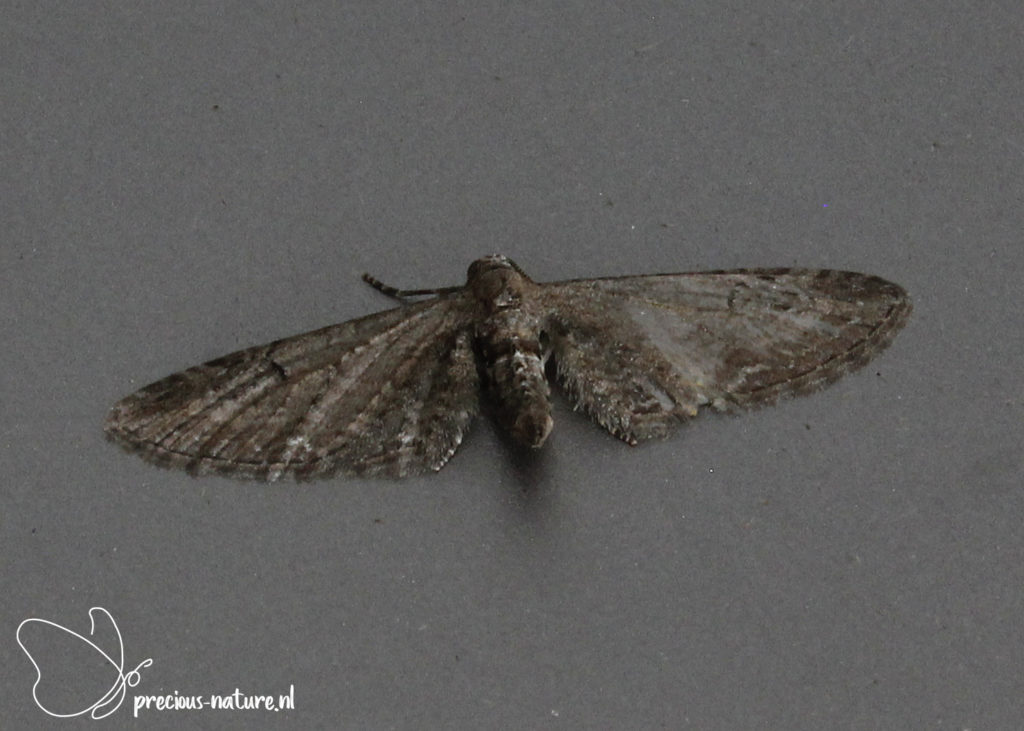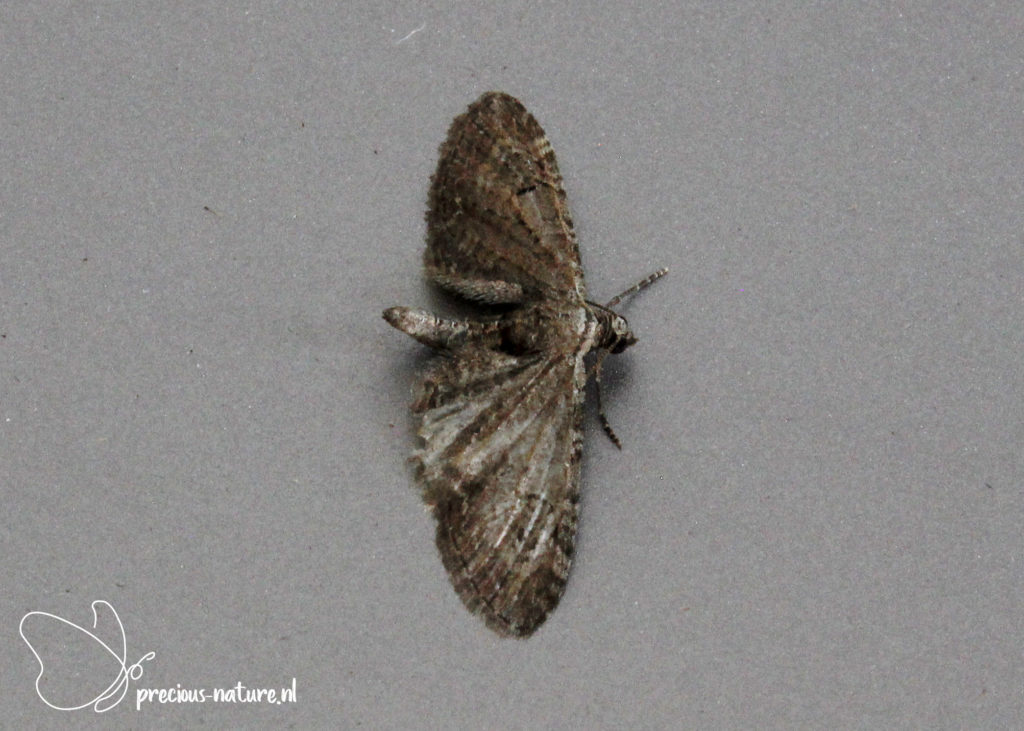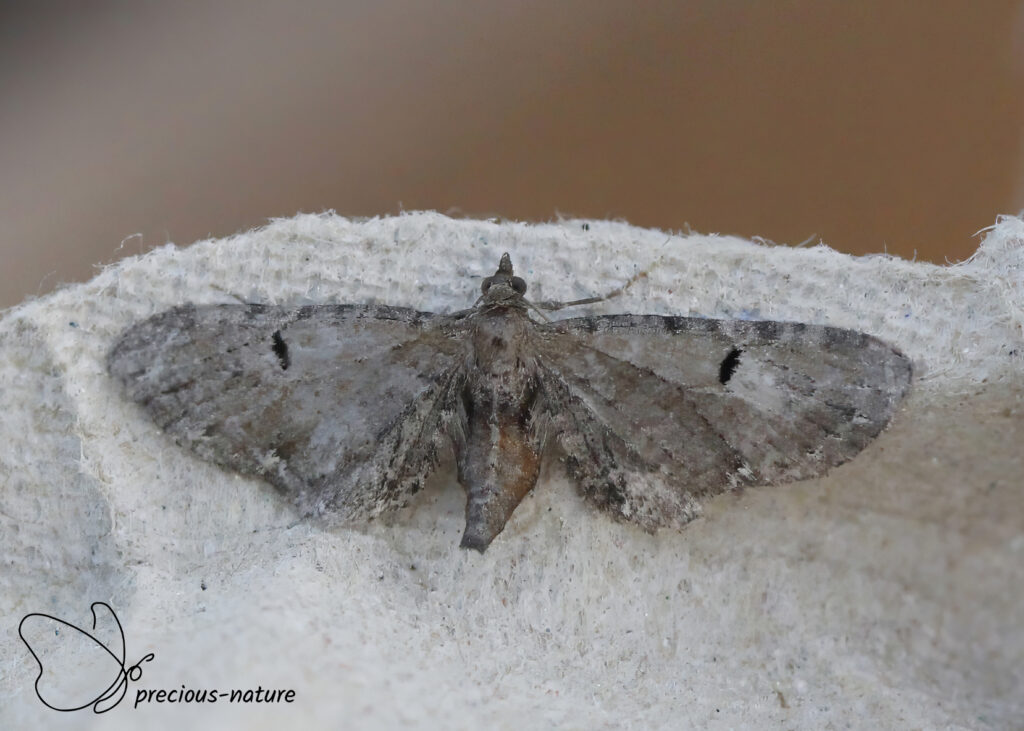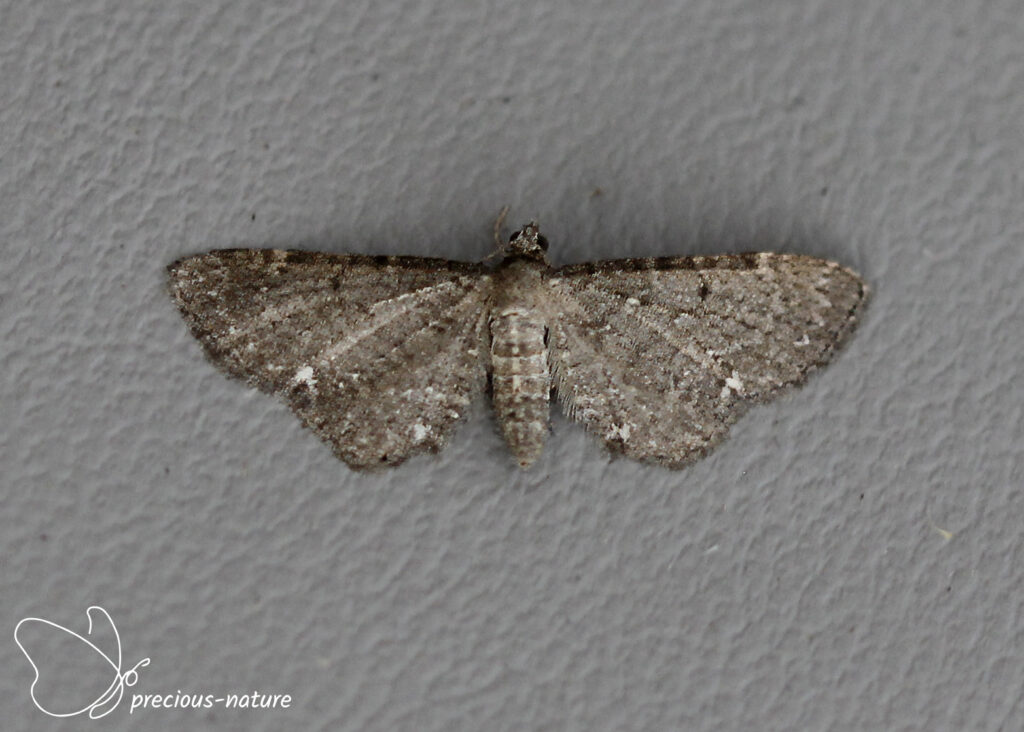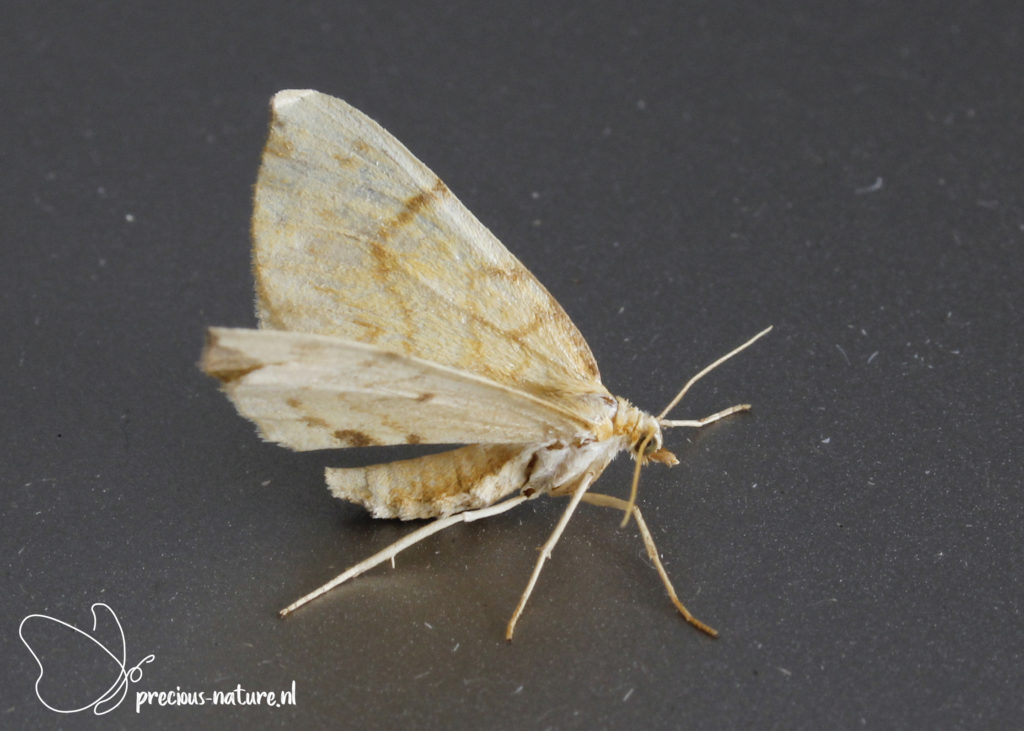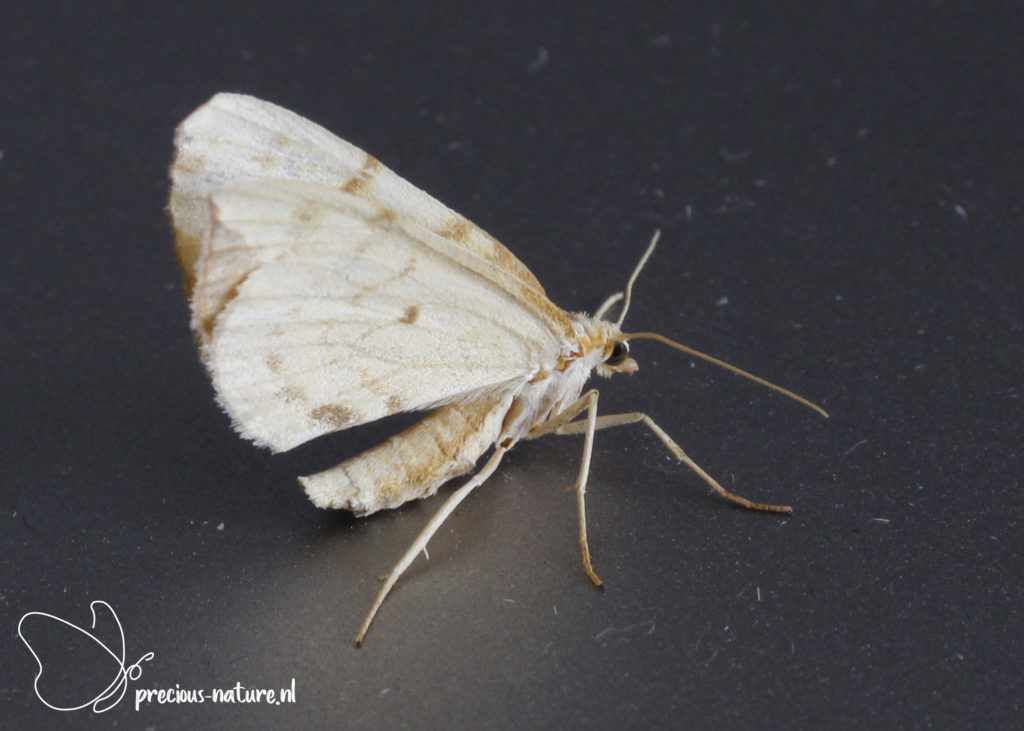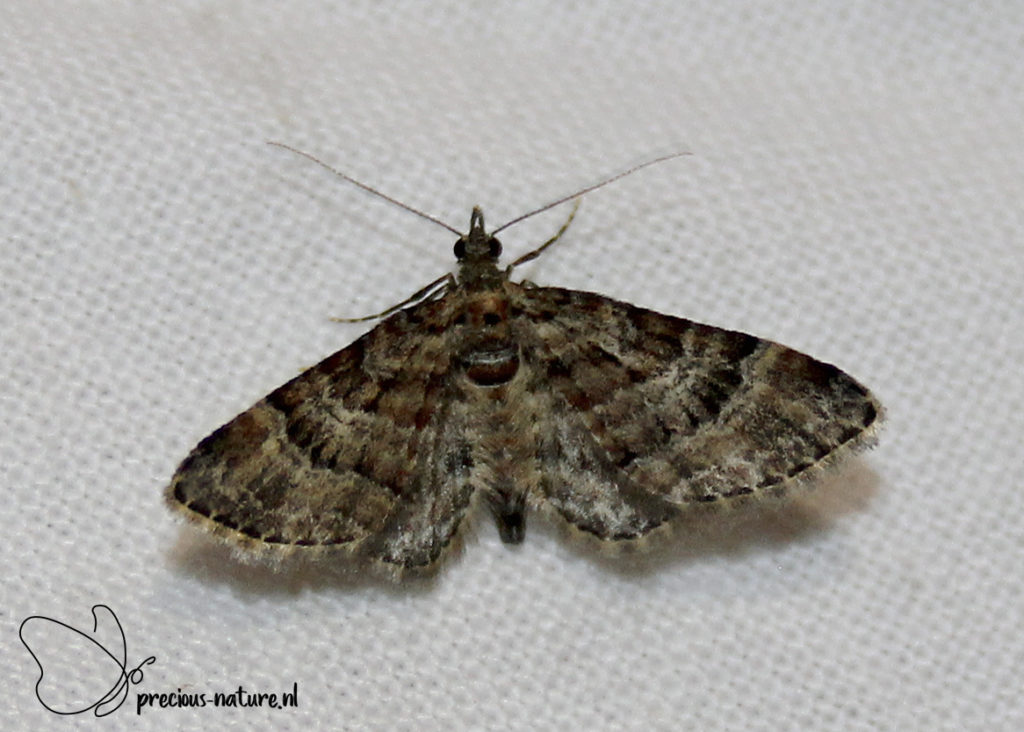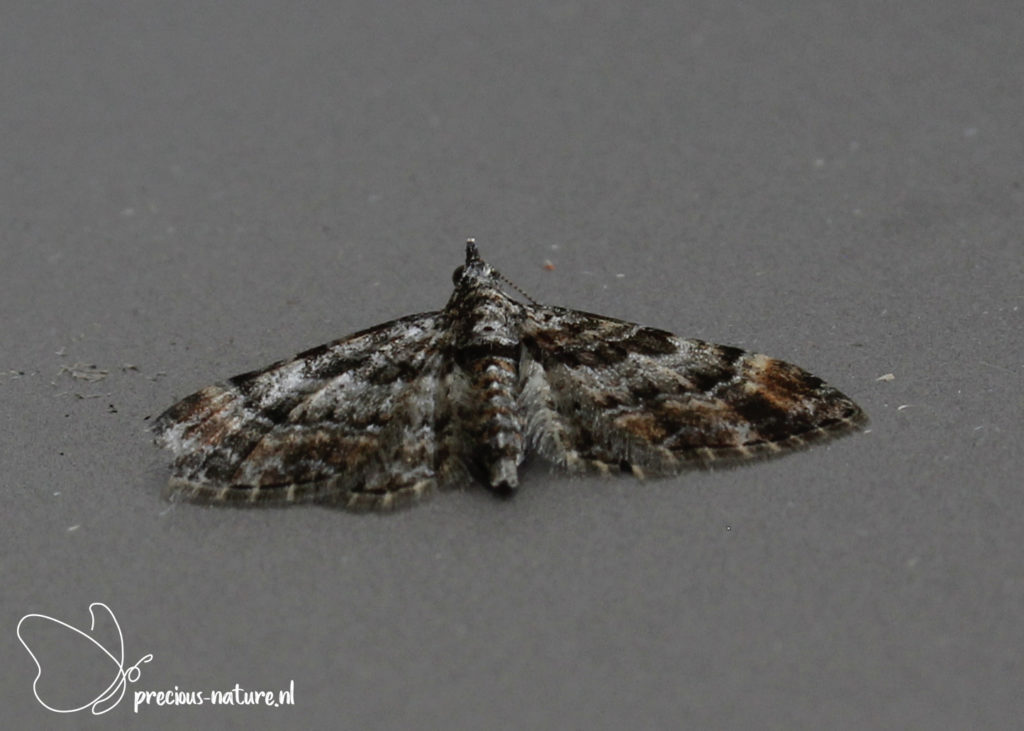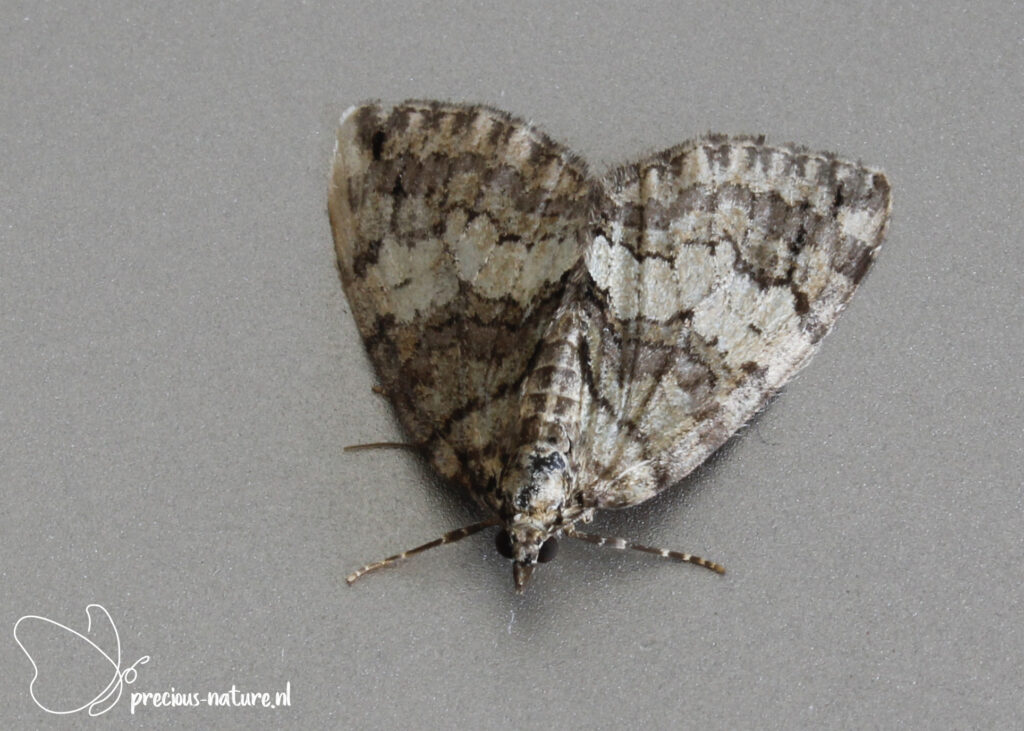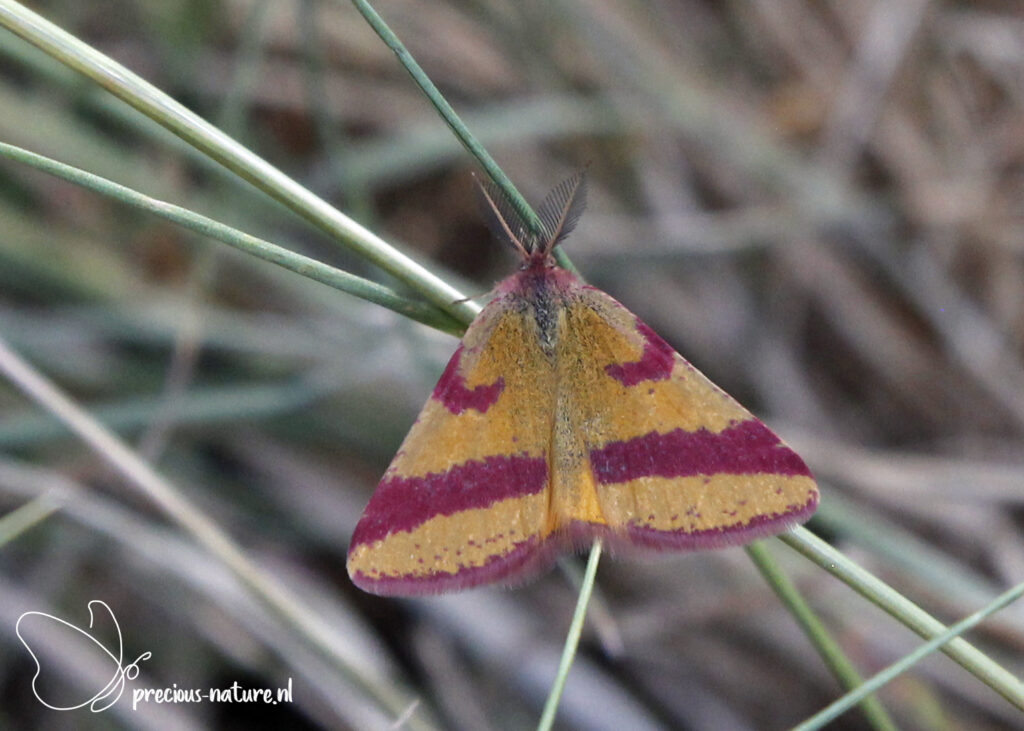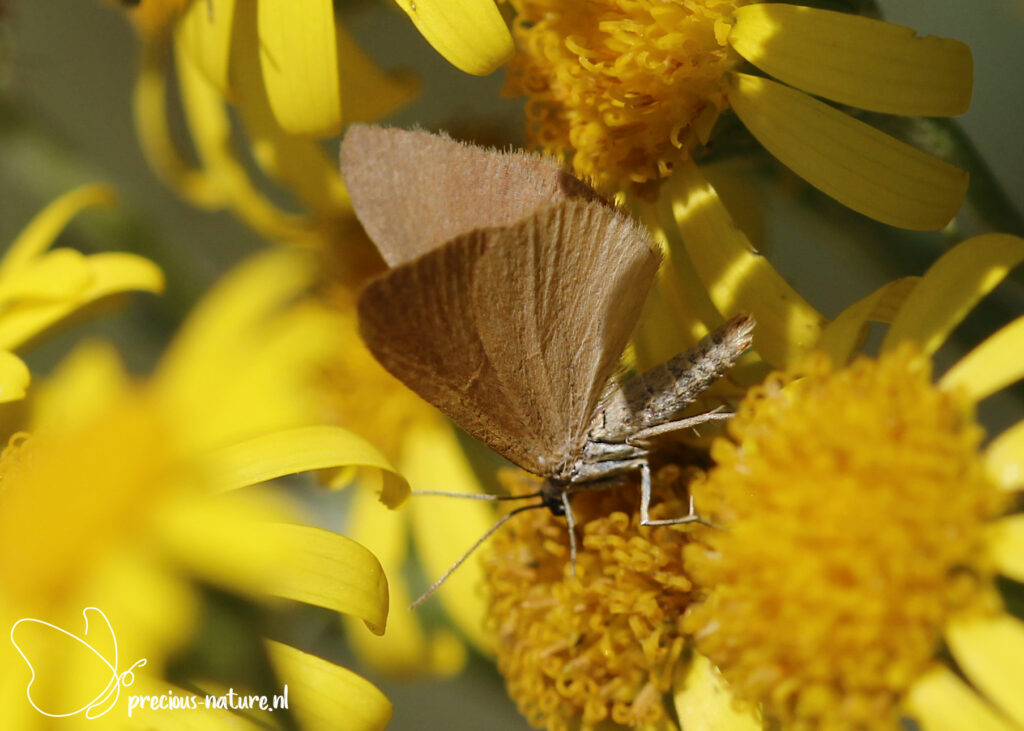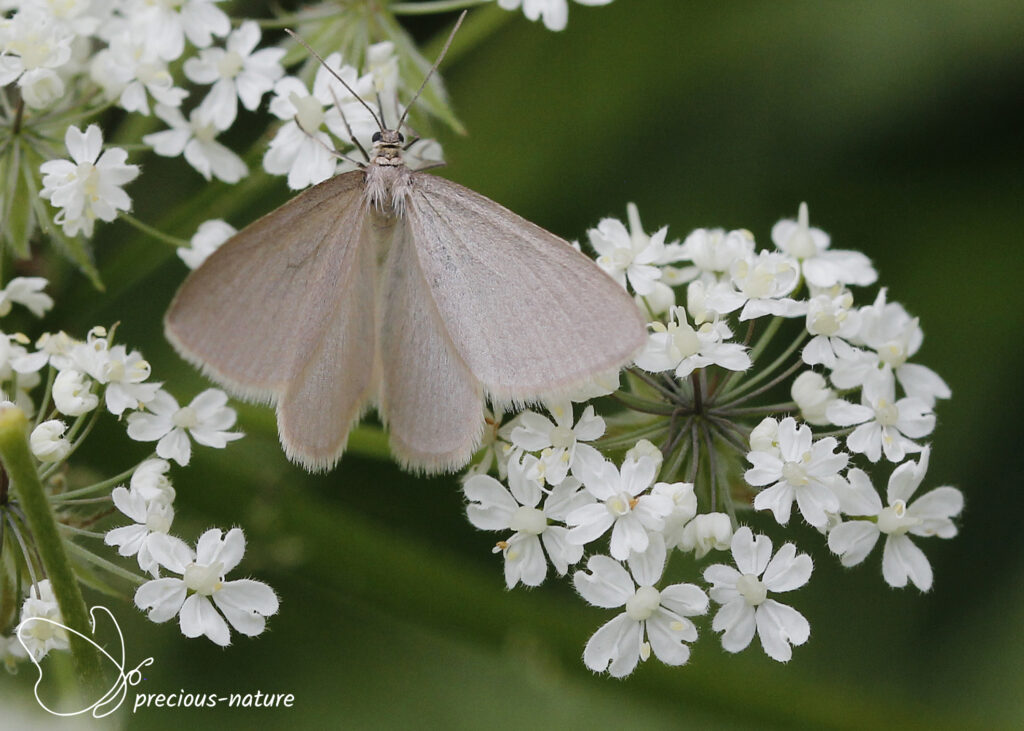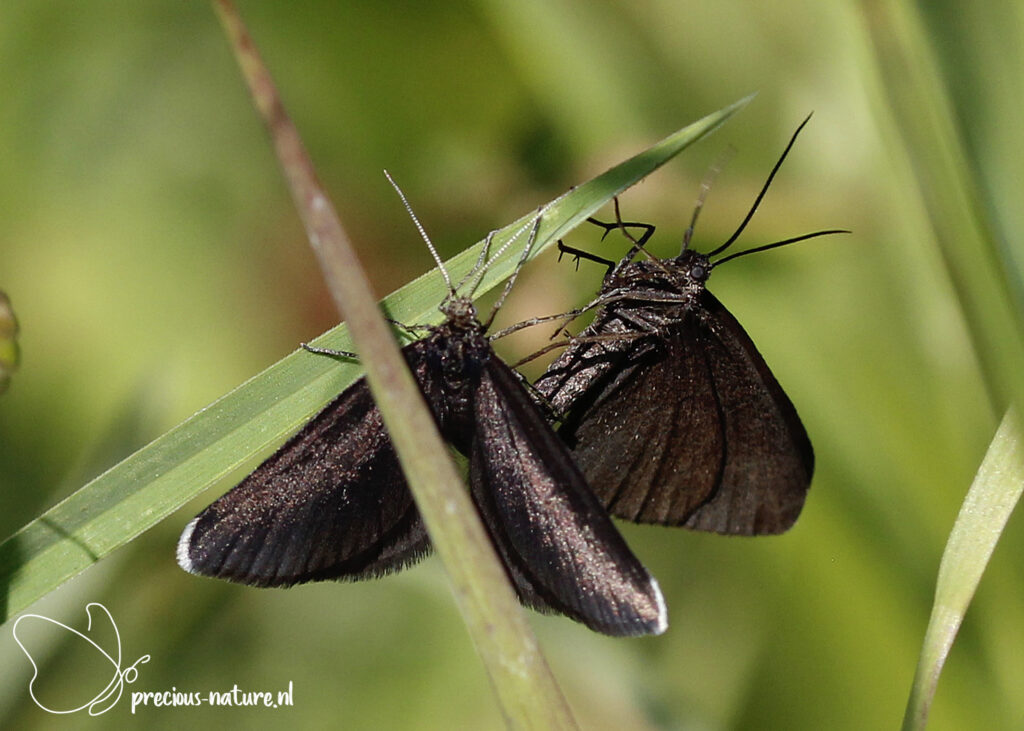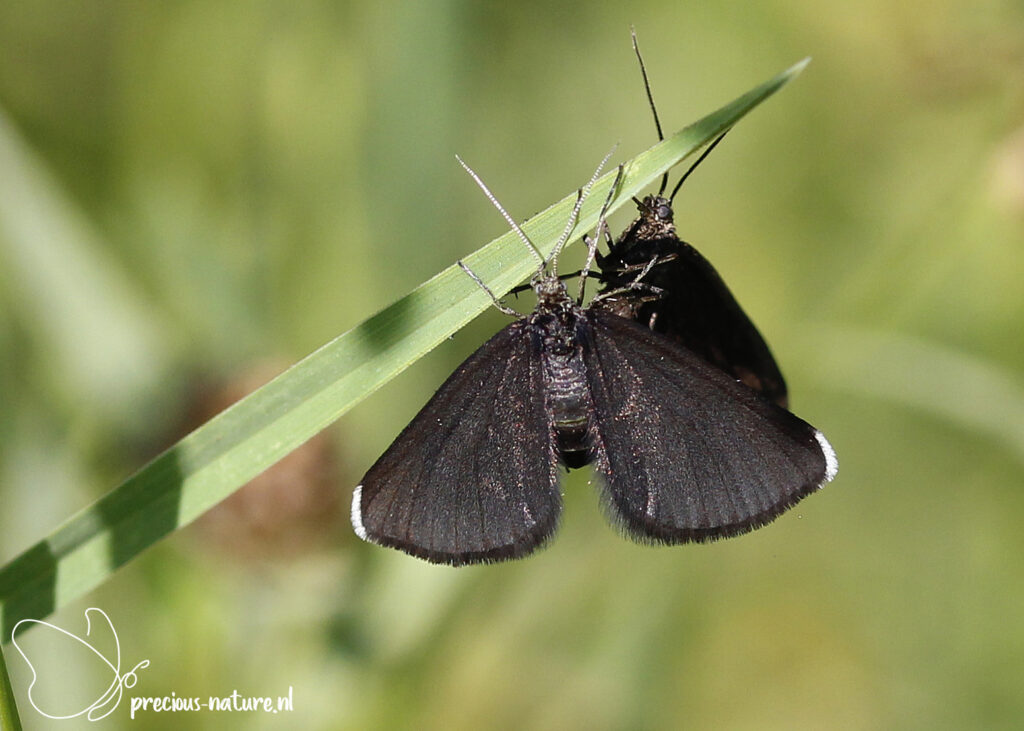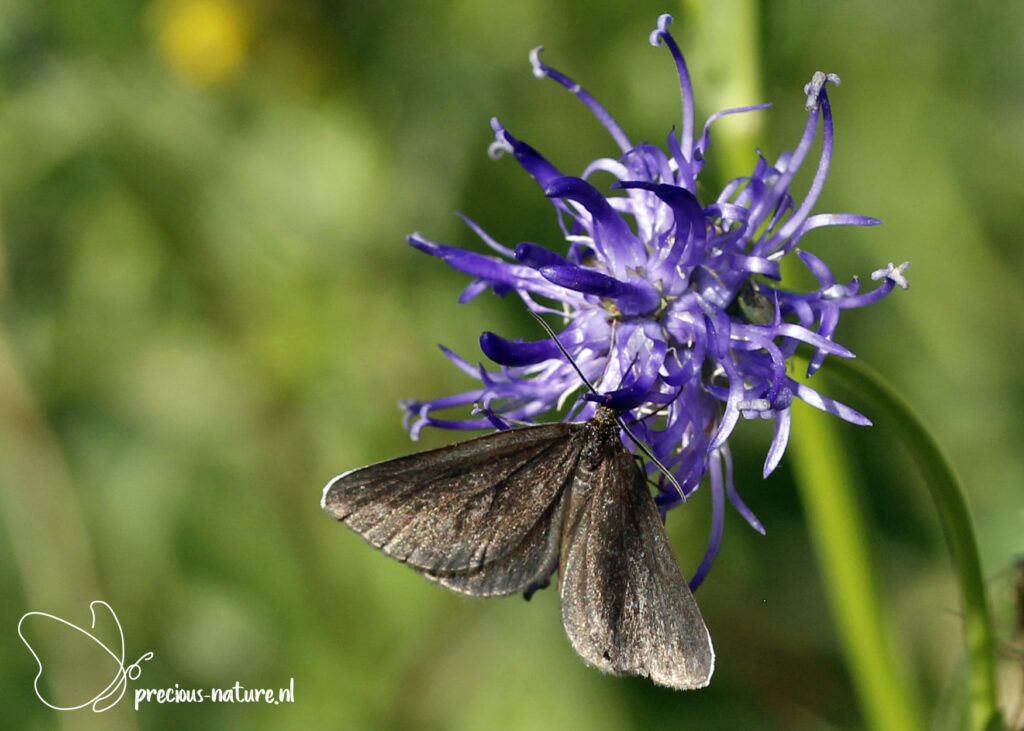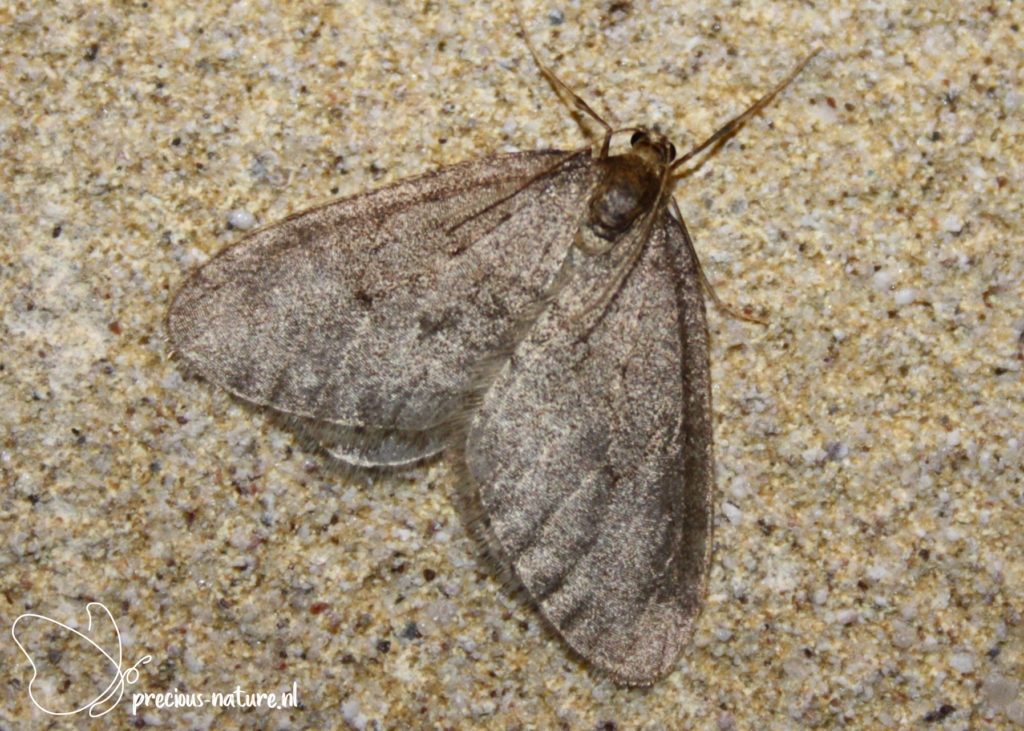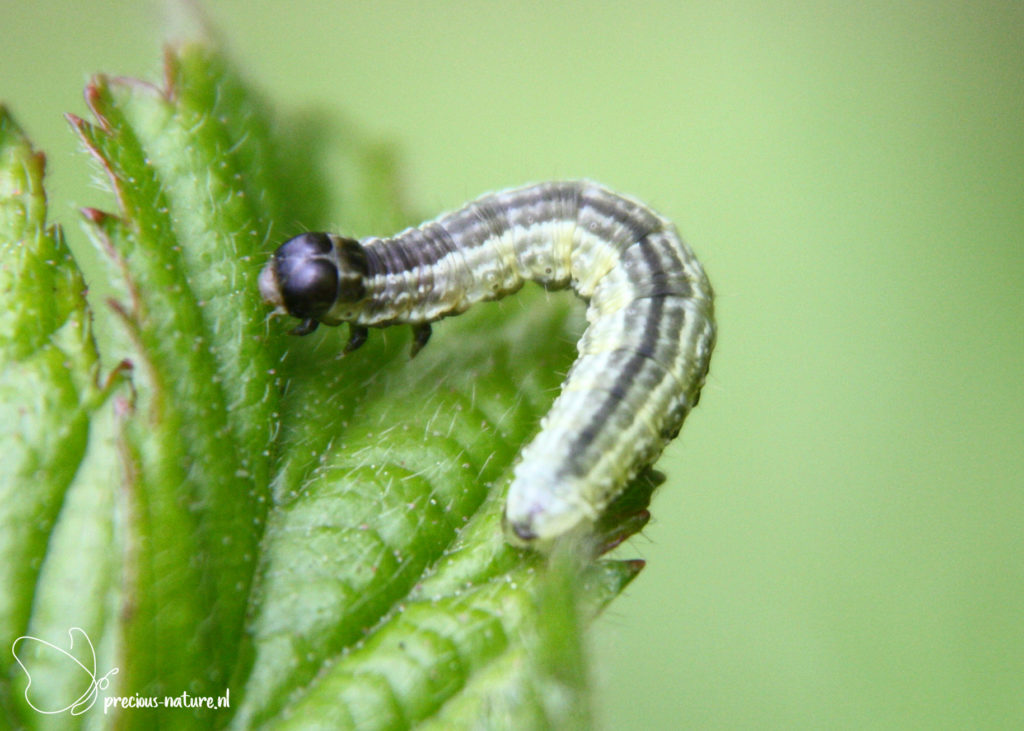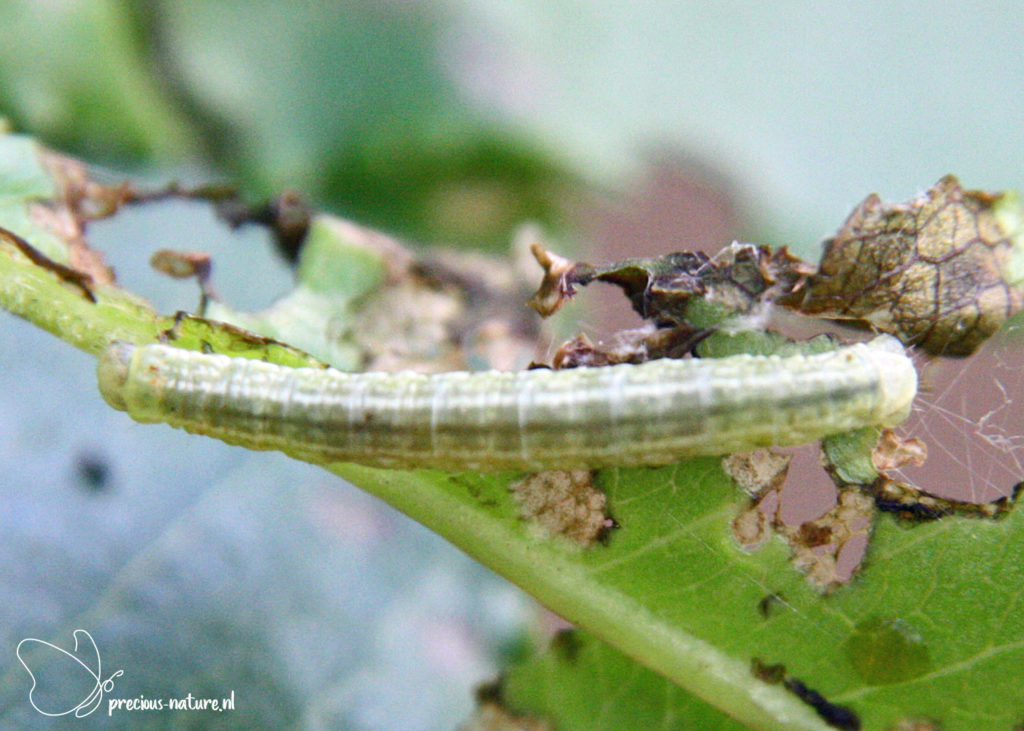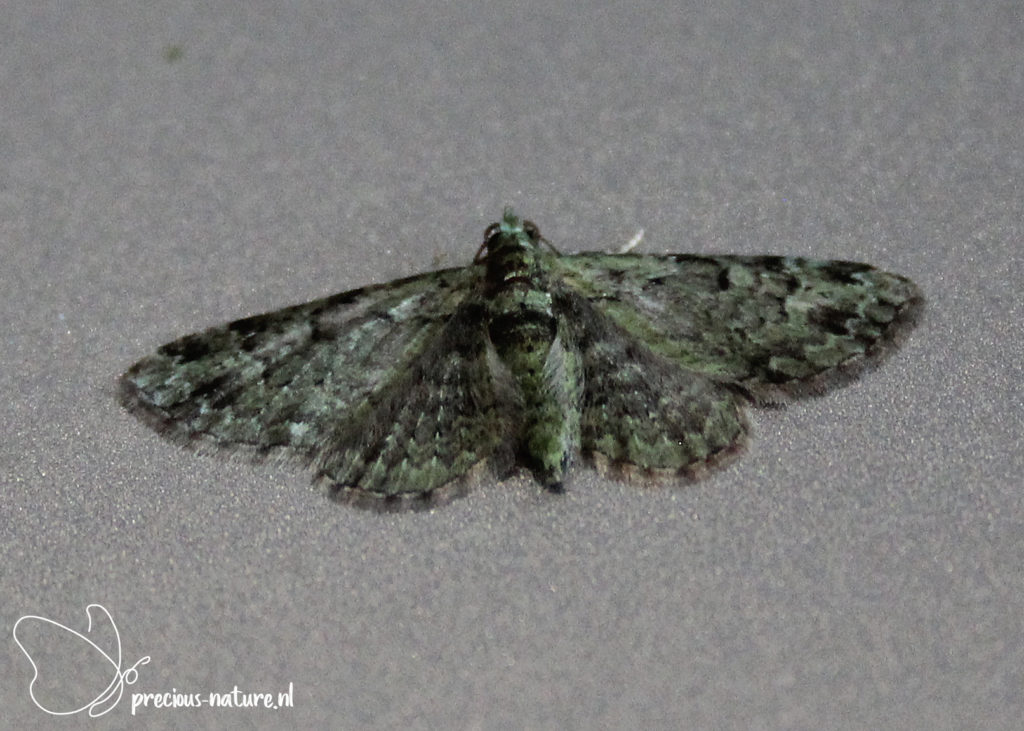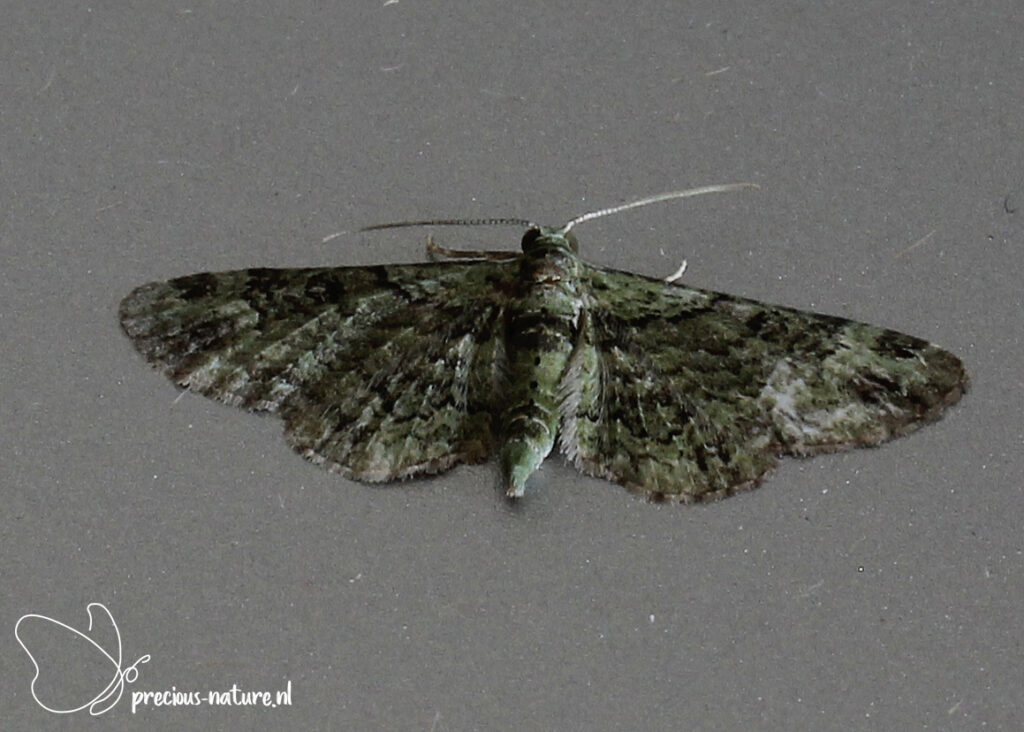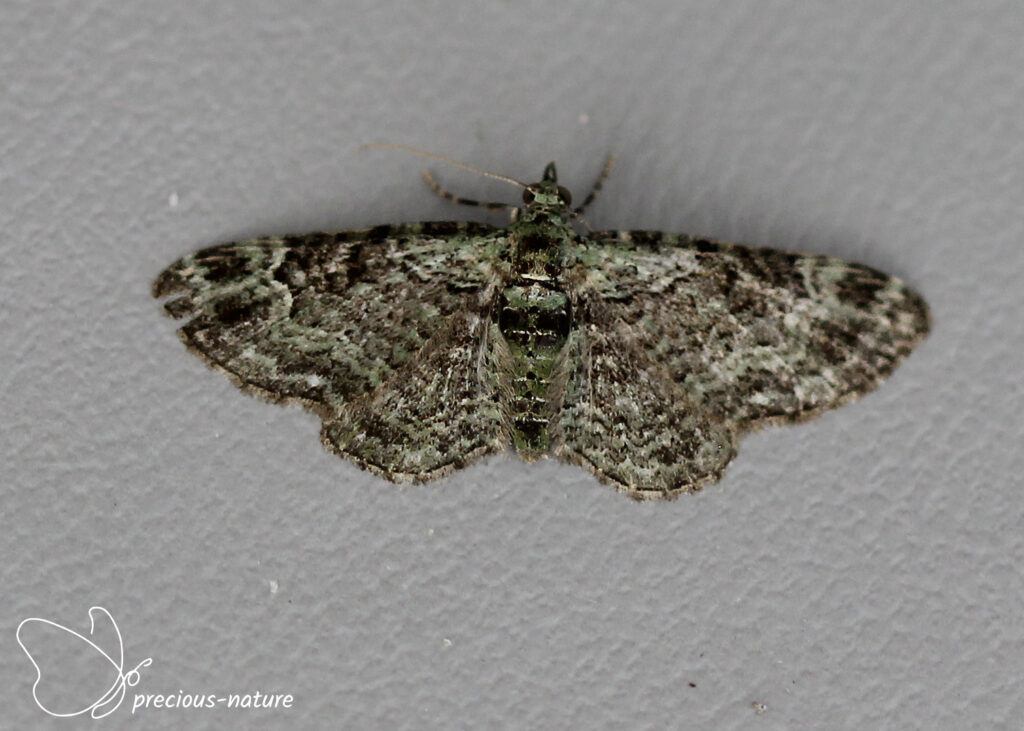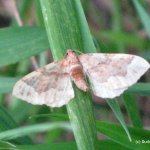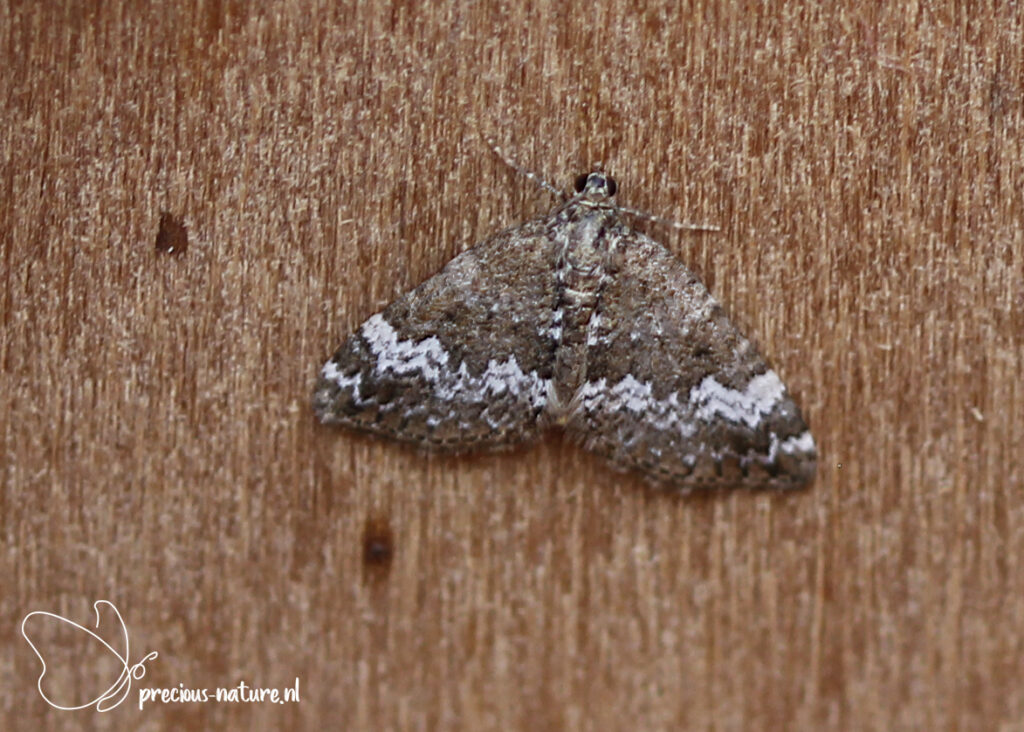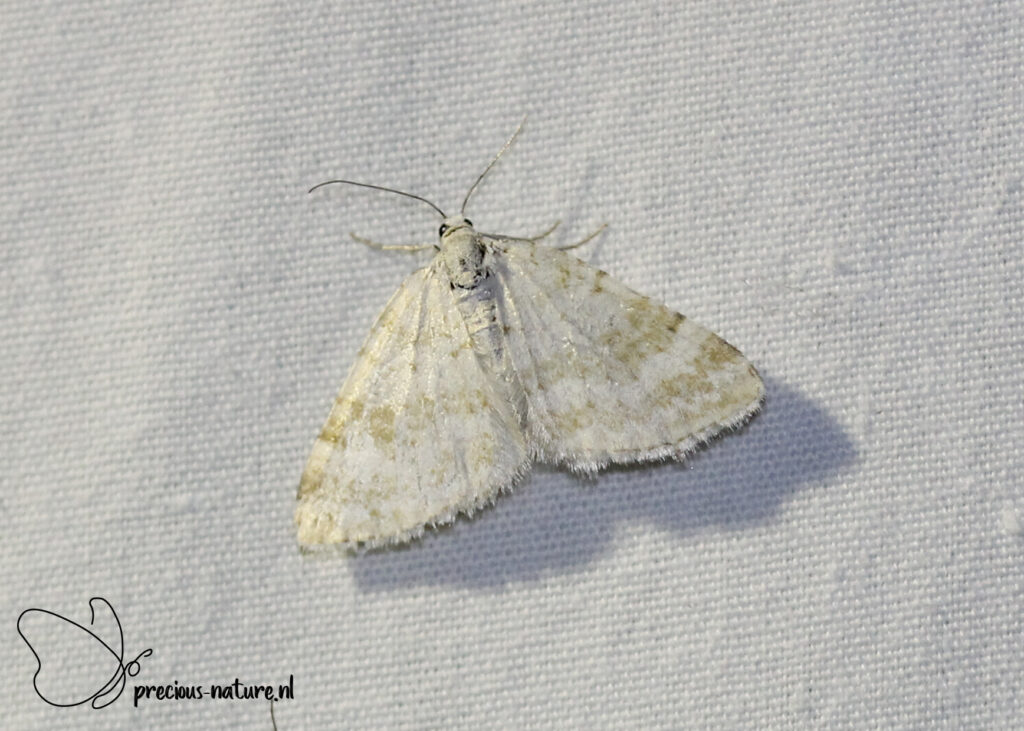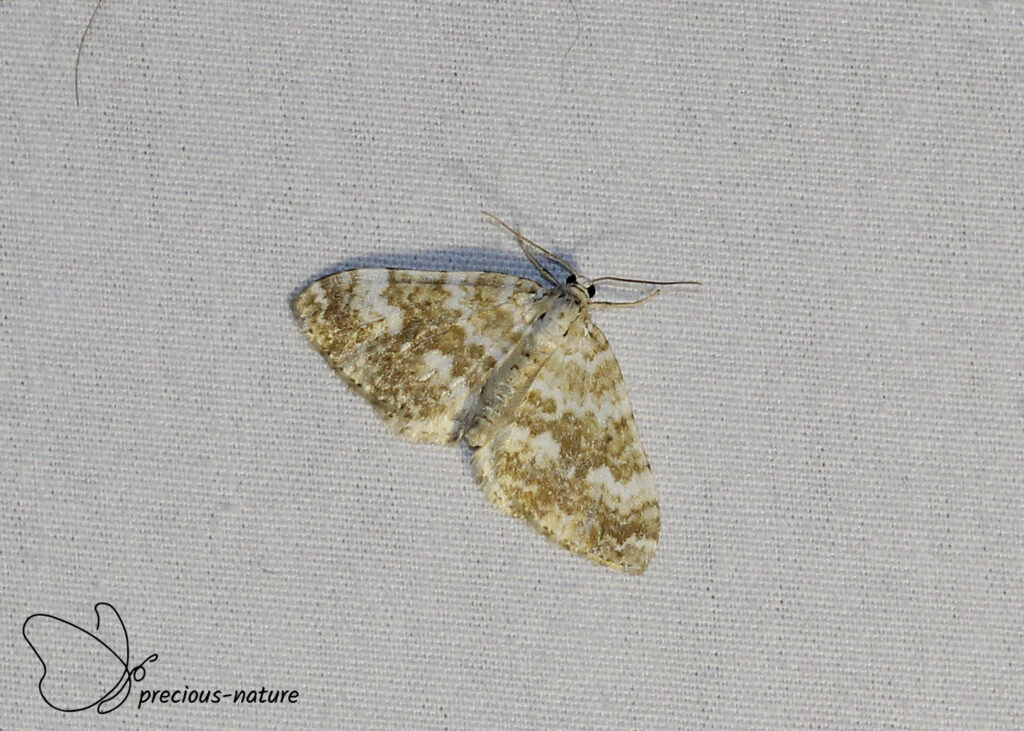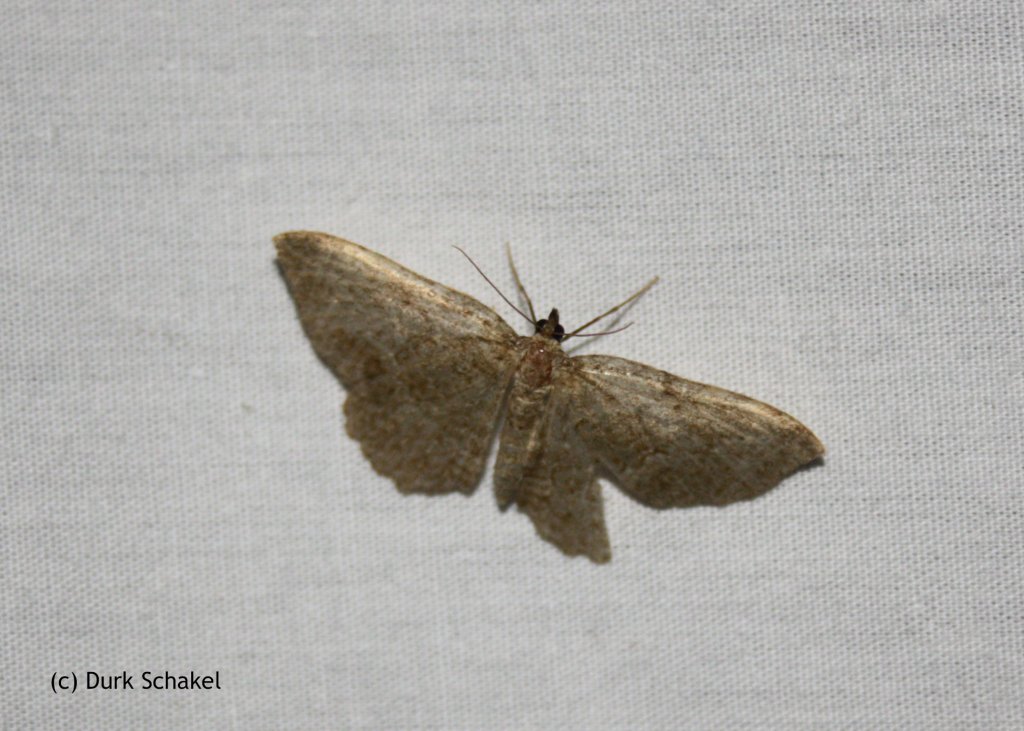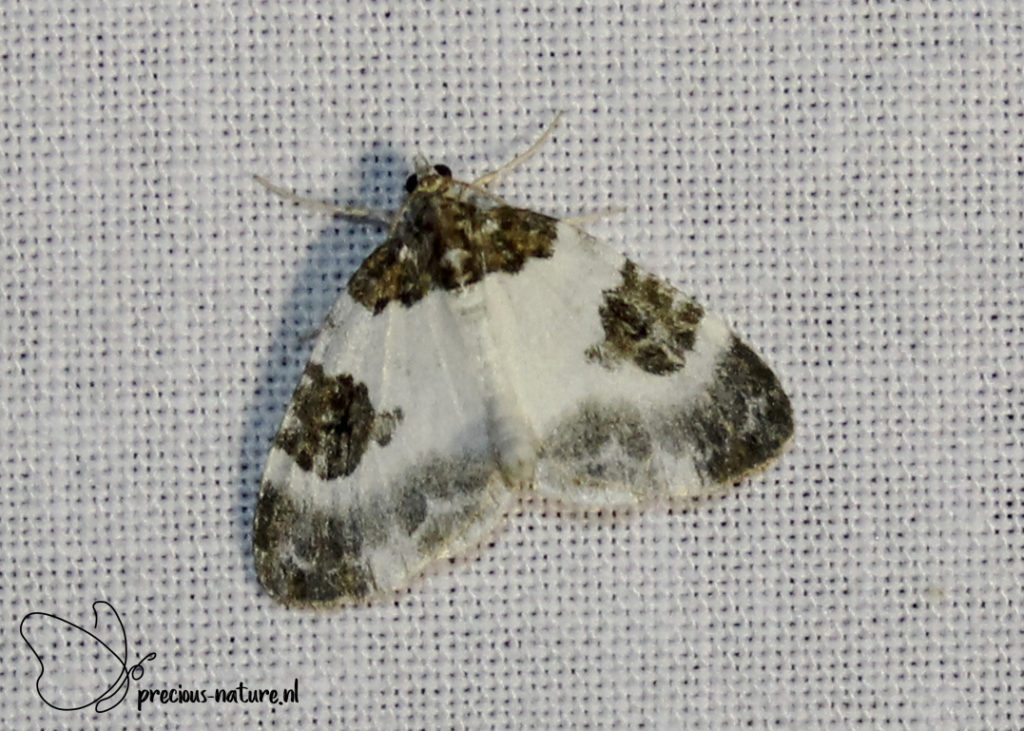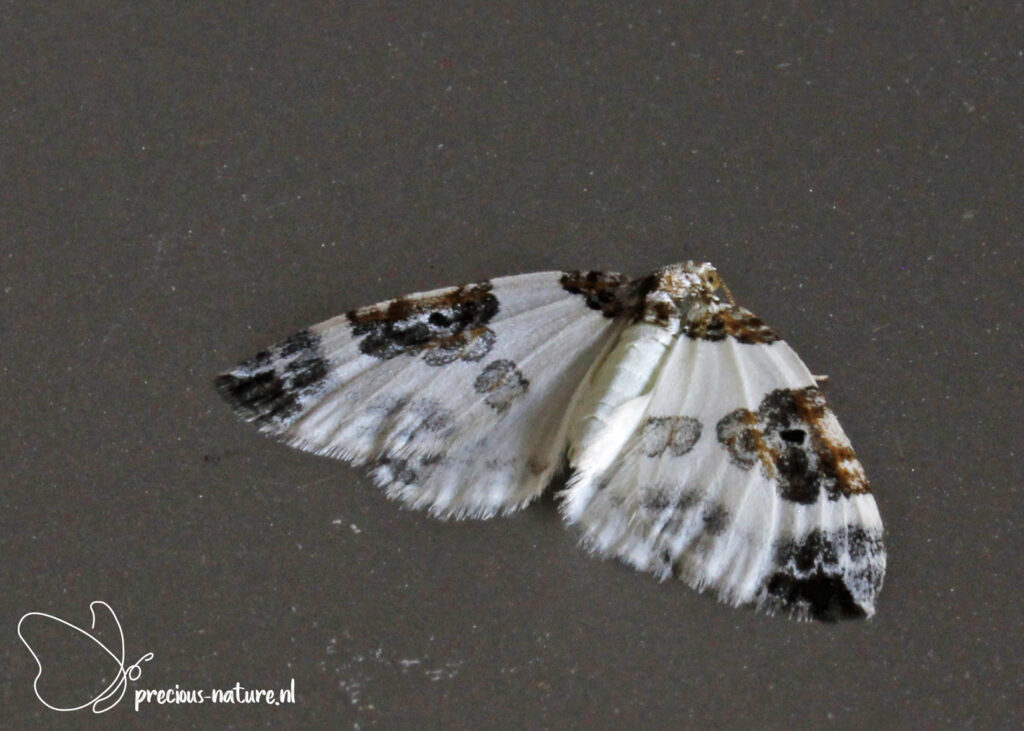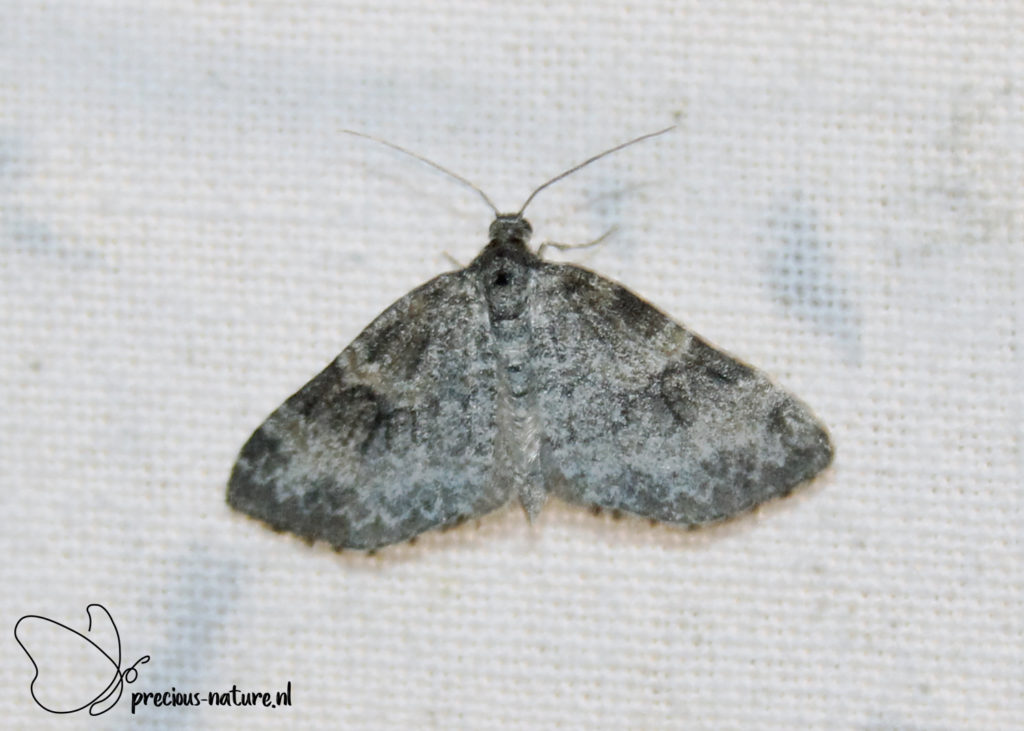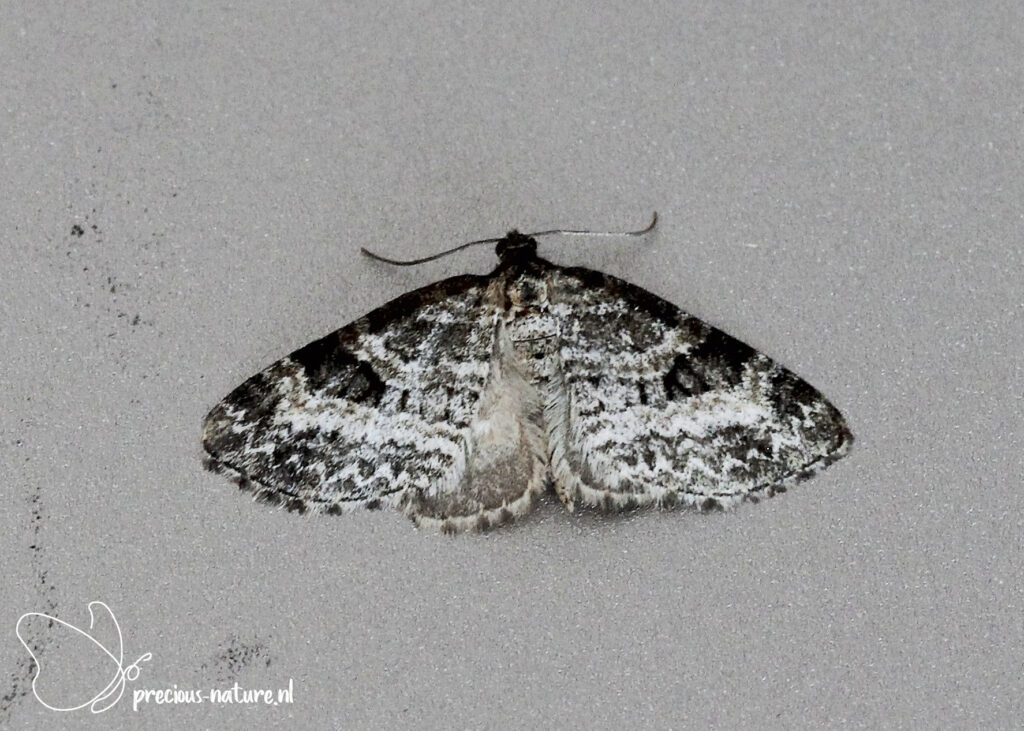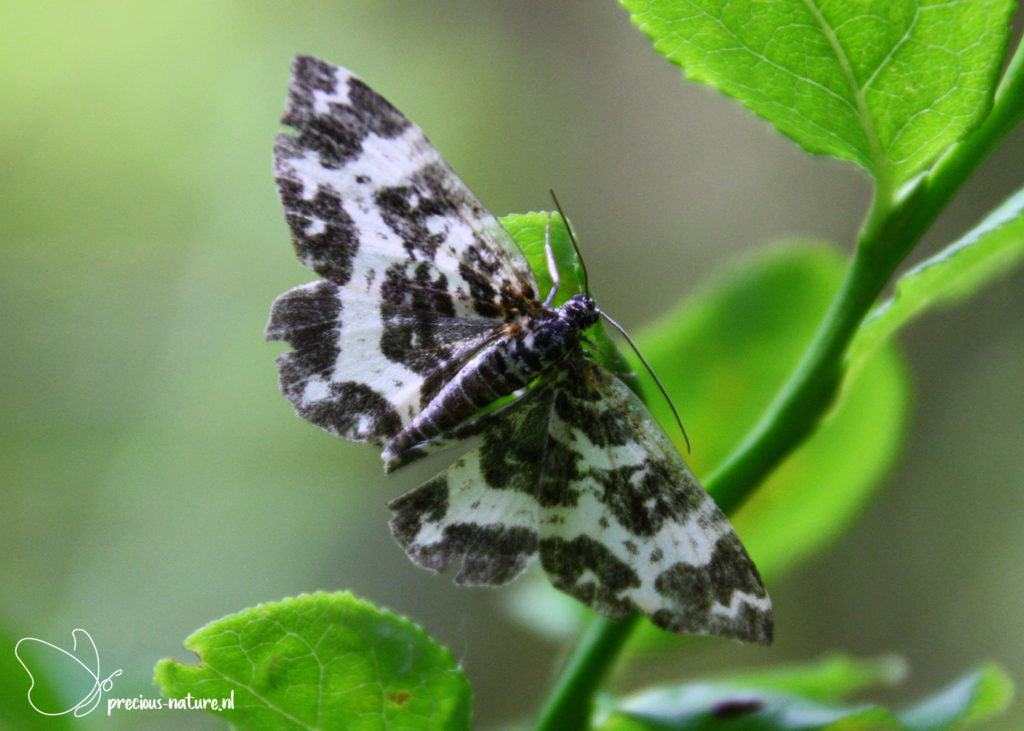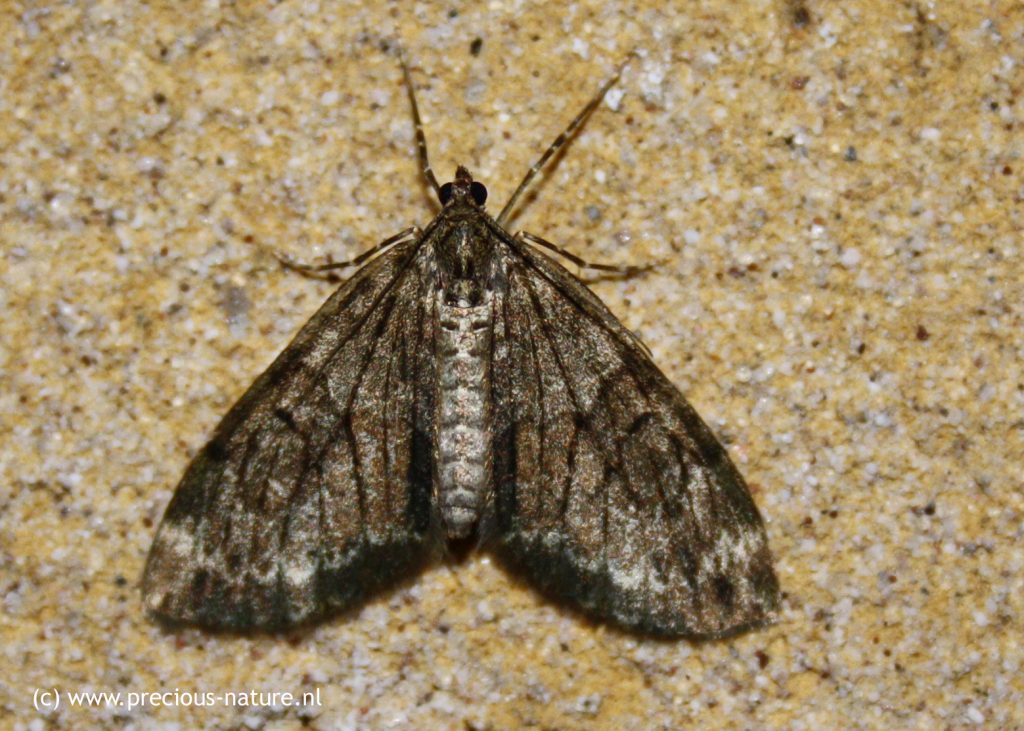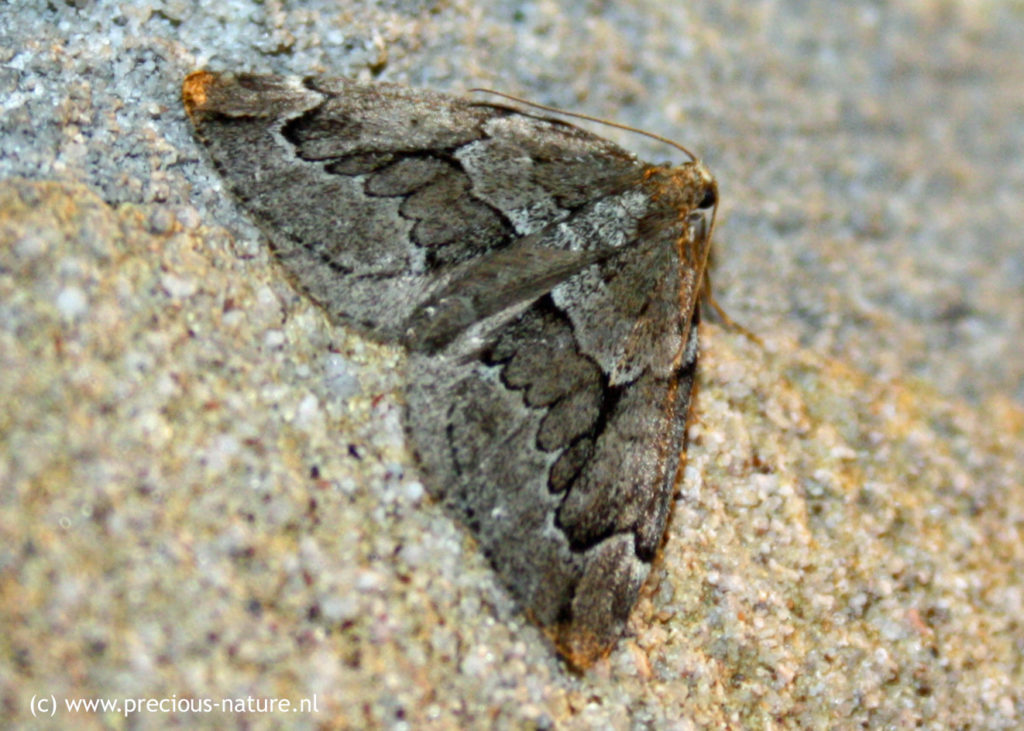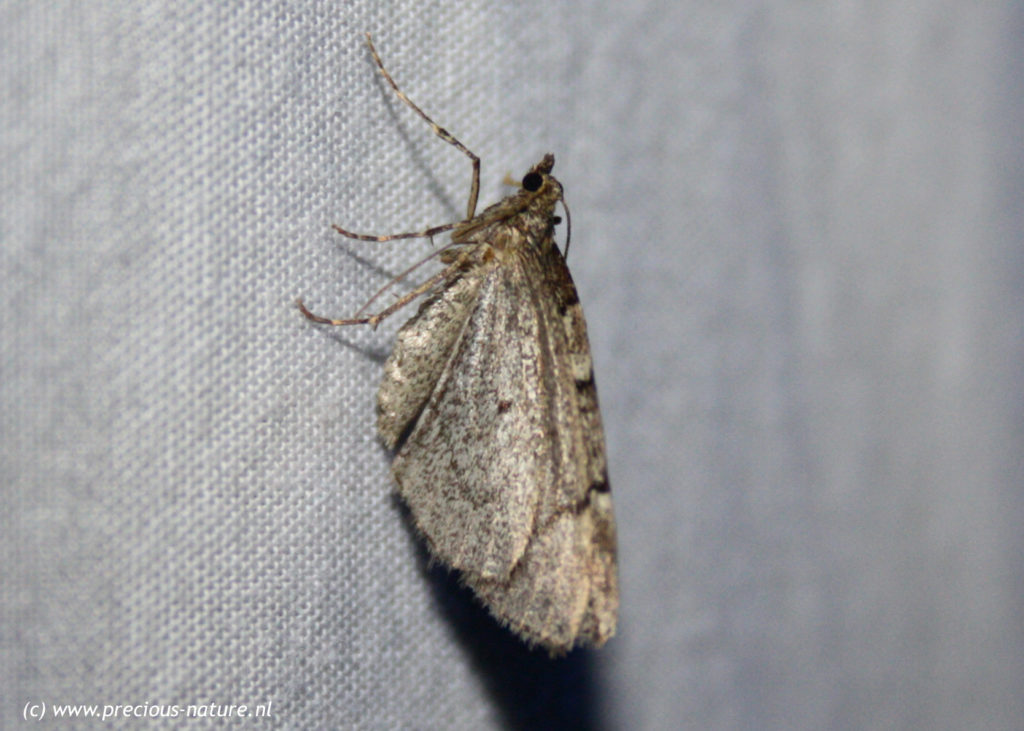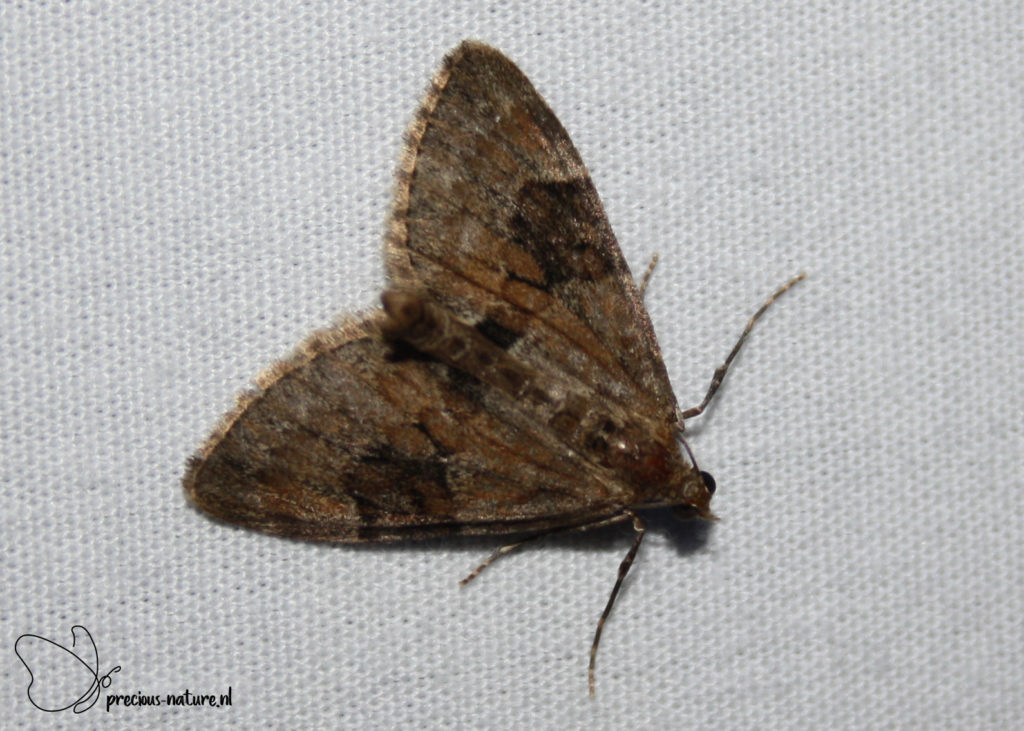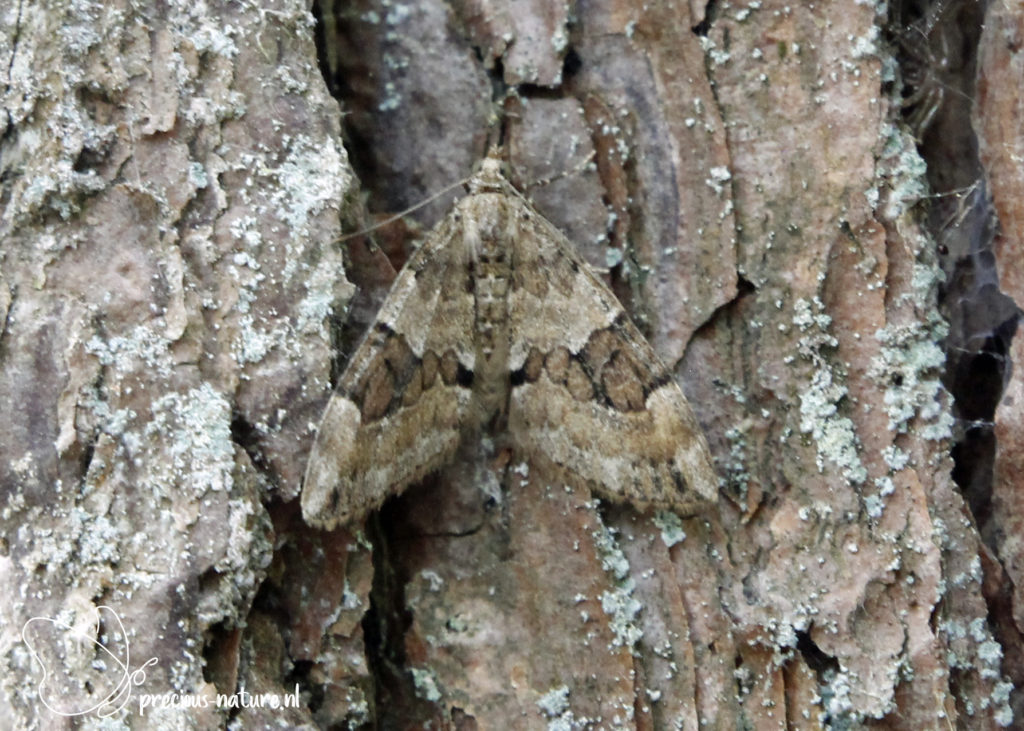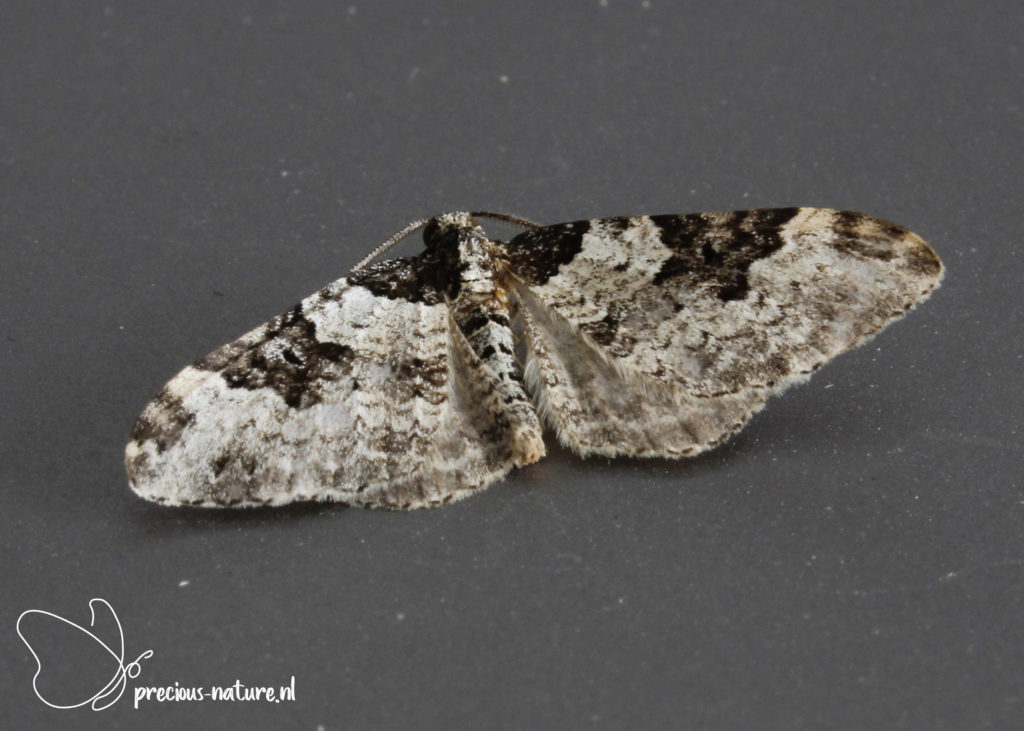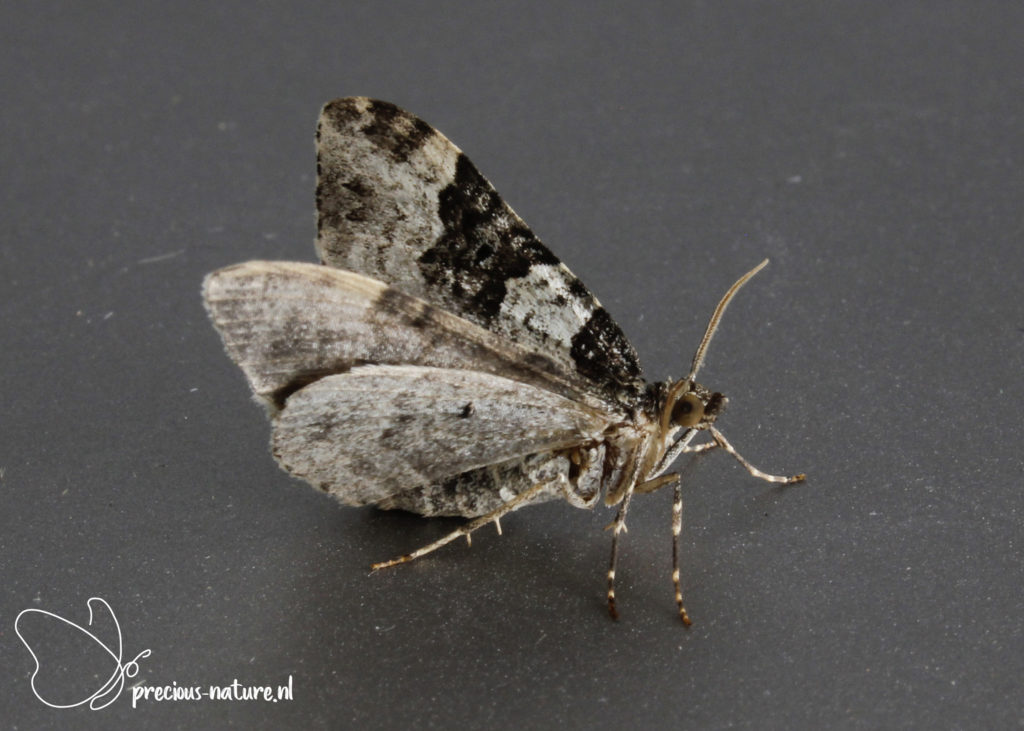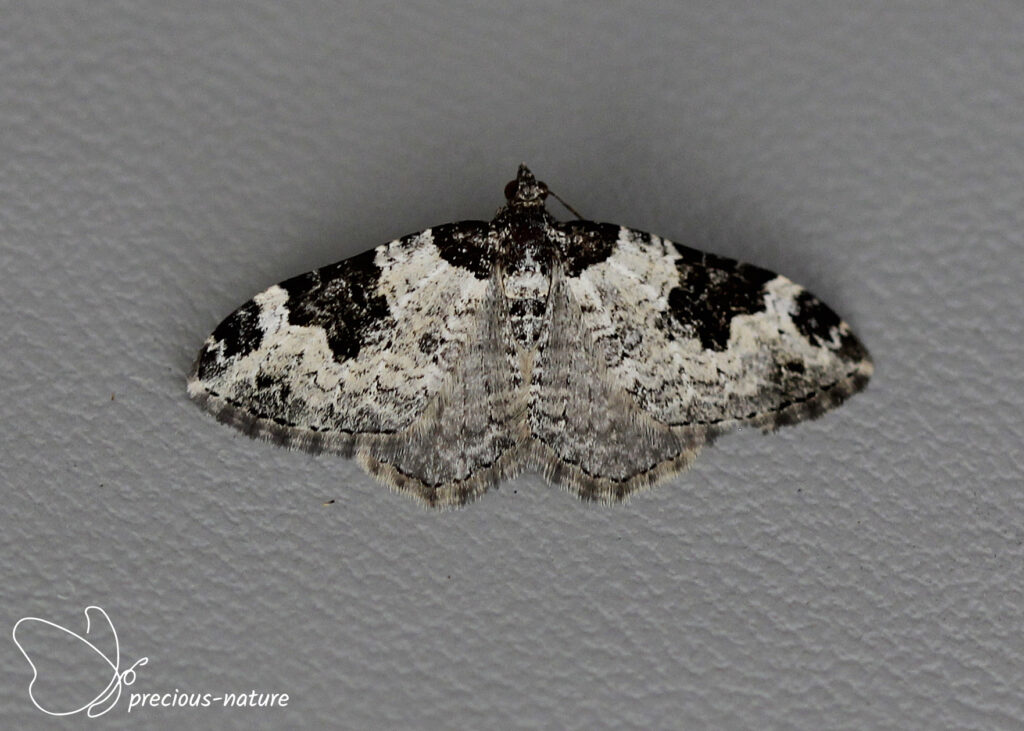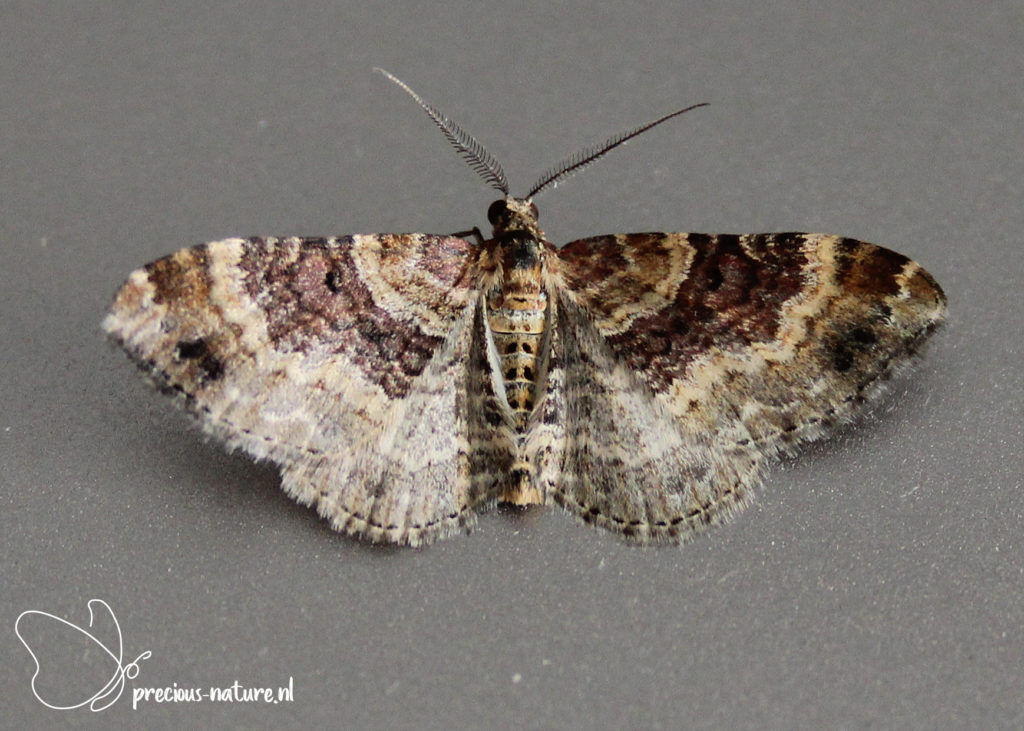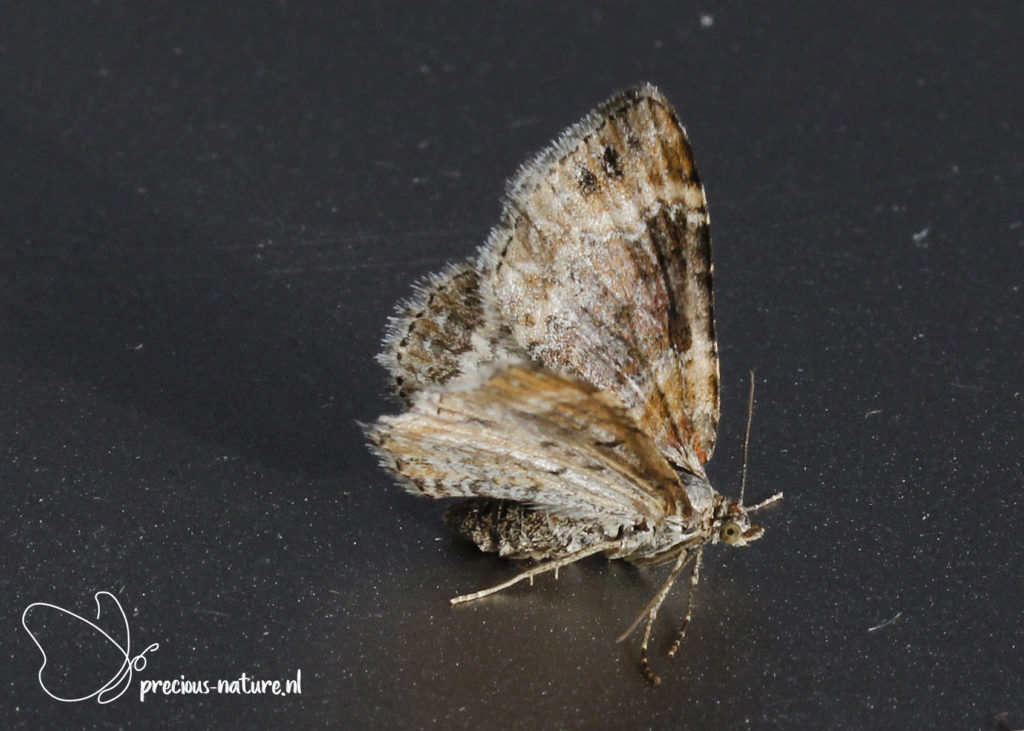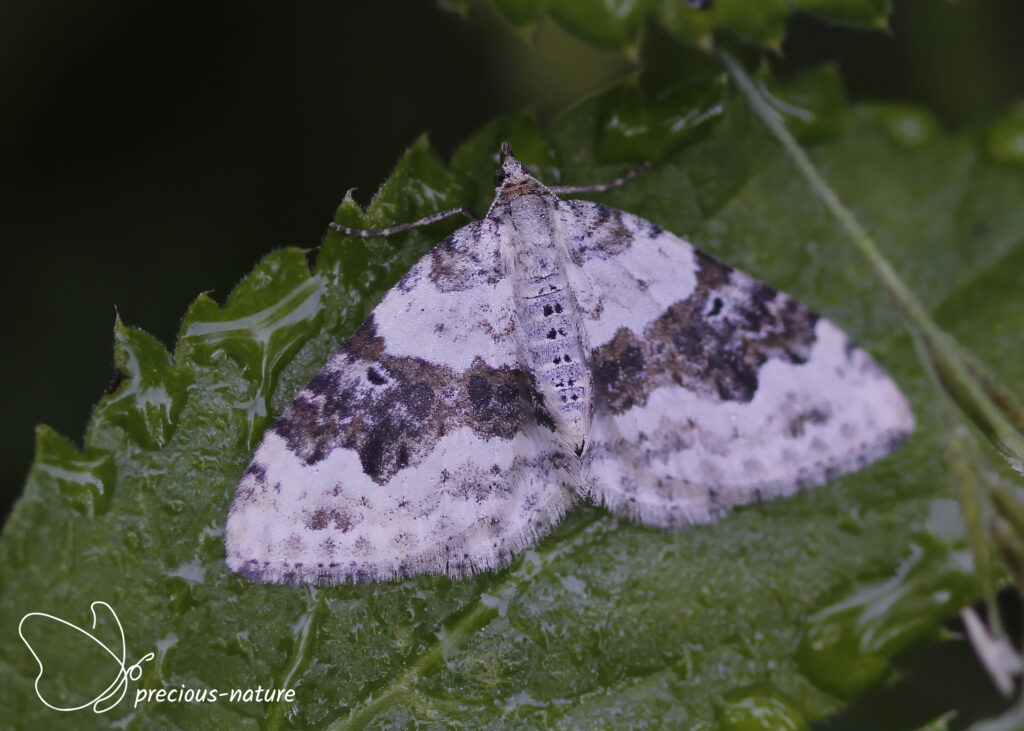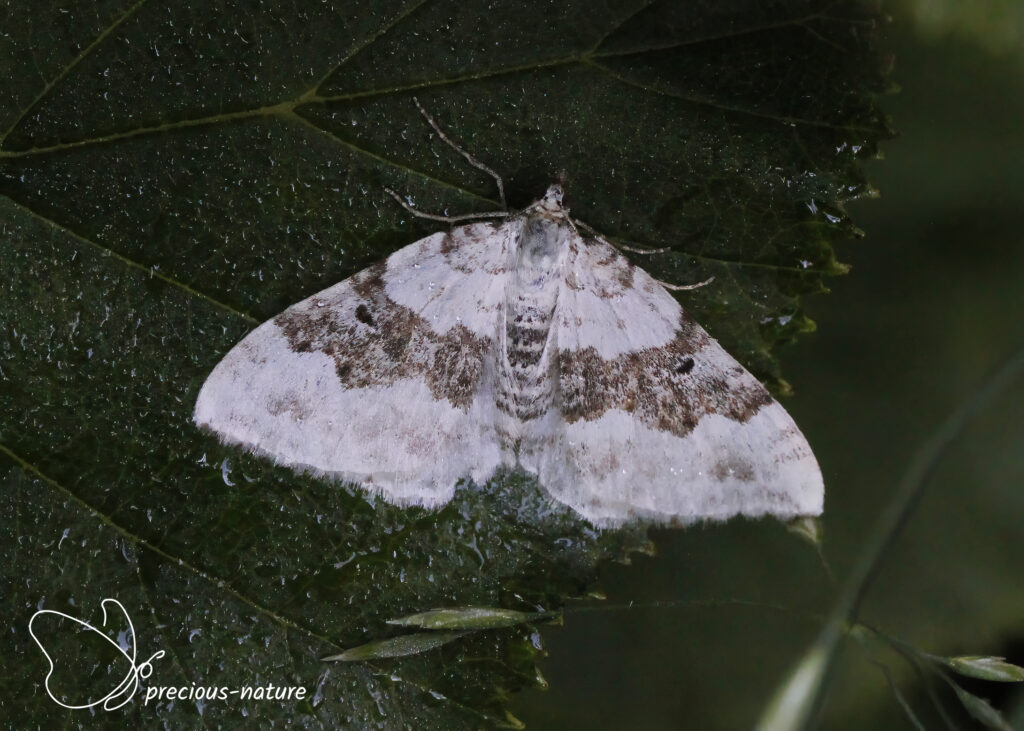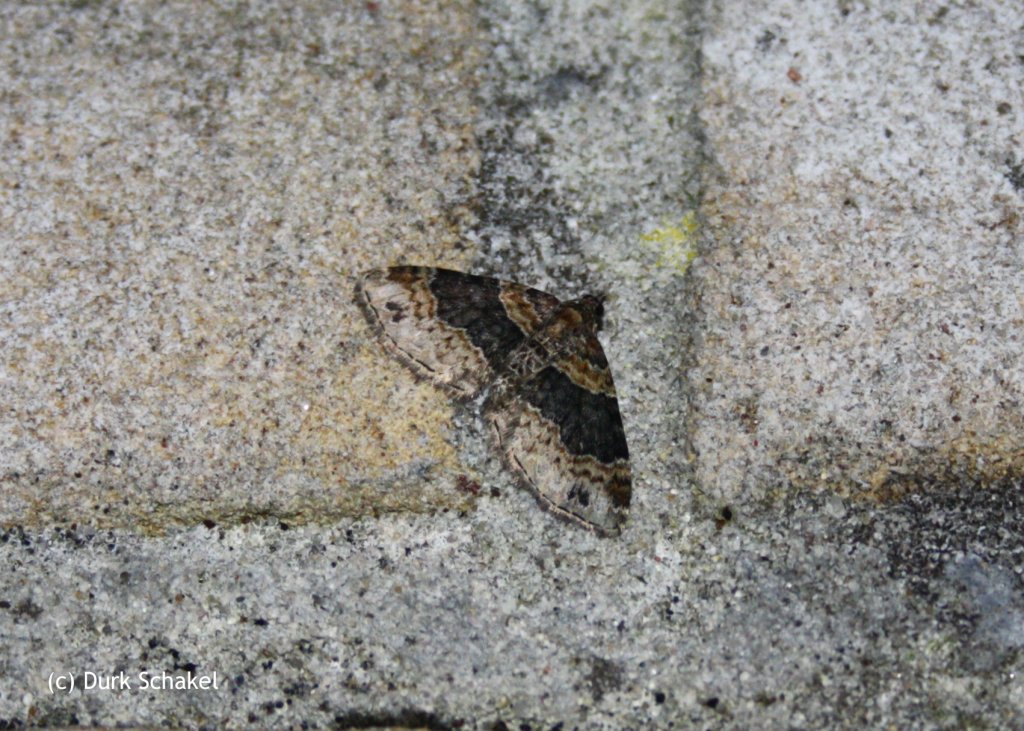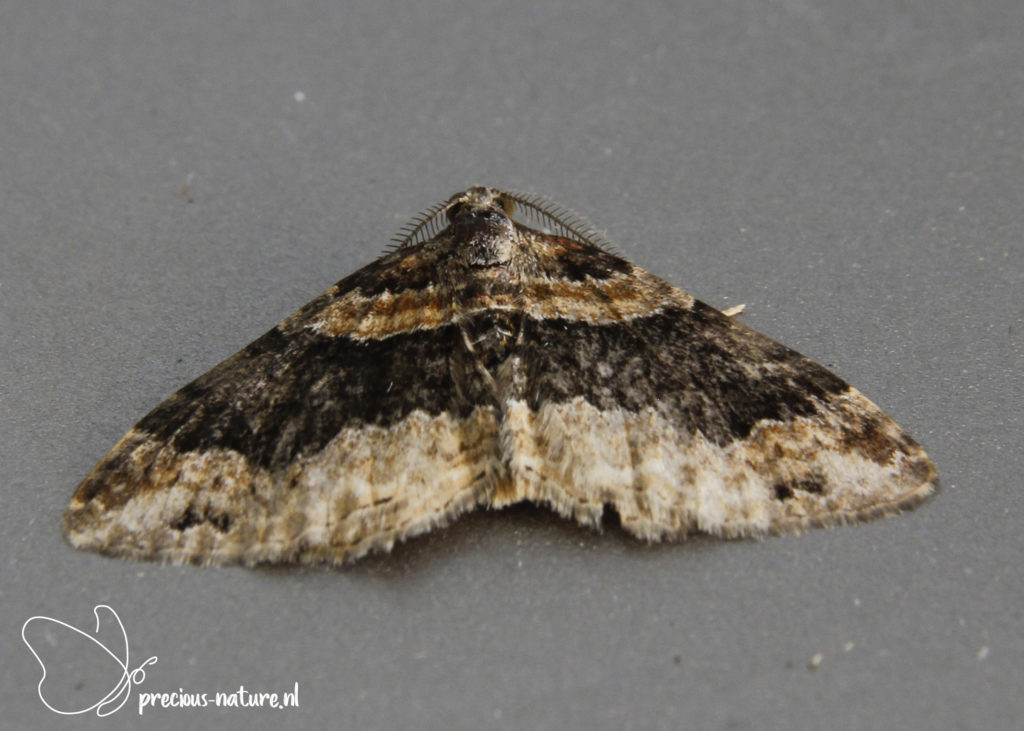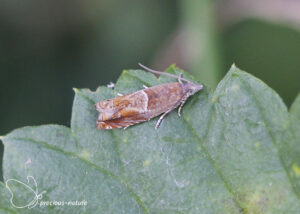Larentiines (Larentiinae) are a sub-family of the Geometer Moths (Geometridae). This subfamily consists of several larger genera and many small monotypic genera.
Genus: Acasis
Yellow-barred Brindle – 2022 (NL)
(NCBI-index: 934820)
Fresh moths of the Yellow-barred Brindle (Acasis viretata) have a striking olive to grass-green colour. However, this fades quickly as they age to yellowish-green or pale ocher yellow. Many black transverse lines can be seen on the forewing, creating a dark green-black median band. A lighter green-white zone is present on either side of the median band. This middle band fades much less quickly, so that older species can still be easily recognised. The flight period spans two generations, from mid-April to early October, and the wingspan ranges from 25 to 29 mm. Host plant: Alder, Buckthorn, Ivy, Privet, Holly, Dogwood. Dutch name: Groene blokspanner. Frisian name: –
Flying period:

Genus: Anticollix
Dentated Pug – 2021 (NL)
(NCBI-index: 504414)
The Dentated Pug (Anticollix sparsata) is a relatively large pug whose wings have a grey-brown ground colour. The most striking and characteristic are the deep notches in the trailing edge of the hindwing and the black serrated fringe line running along with them. There are dark spots along the costal edge of the forewing, and a precise centre spot can be seen close to the edge. The wing veins are usually black and white. The flight period spans two generations, from May to early September, and the wingspan ranges from 20 to 26 mm. Host plant: Yellow Loosestrife. Dutch name: Wederikdwergspanner. Frisian name: –
Flying period:

Genus: Camptogramma
Yellow Shell – 2017 (NL)
(NCBI-index: 934908)
The Yellow Shell (Camptogramma bilineata) is easily recognisable due to the unique, intricate, and wavy pattern resembling some seashells. The ground colour is golden yellow with many fine brown corrugated transverse lines. The median lines are visible on the forewing due to their bright white colour. The dark brown median bands easily recognise the female. The Yellow Shell flies in one or sometimes two generations from May to the end of August, and the wingspan is 20-25 mm. Host plant: Cleavers and other bedstraws. Dutch name: Gestreepte goudspanner. Frisian name: Strepe goudspanner.
Flying period:

Genus: Chloroclystis
The V-pug – 2015 (NL)
(NCBI-index: 190337)
With its black ‘V’ in the post-median line near the termen, the V-pug (Chloroclystis v-ata) lives up to its name. The forewing’s green colour changes to light yellow-brown as it ages. In contrast, the hindwing is pale grey with obscure transversely darker striae. The abdomen is green with two parallel rows of black dots and a black band. The flight period is from April to October in two or sometimes three generations, and the wingspan is 14-19 mm. Host plant: Elder and Brambles. Dutch name: V-dwergspanner. Frisian name: V-Dwerchspanner.
Flying period:

Genus: Cidaria
Barred Yellow – 2017 (NL)
(NCBI-index: 934927)
The Barred Yellow (Cidaria fulvata) is recognisable because of its bright orange-yellow forewing and the irregularly shaped red-brown median band. There is a light spot on the apex. This moth flies from one generation from May to August and has a 20-25 mm wingspan. Host plant: Wild and cultivated roses. Dutch name: Oranje bruinbandspanner. Frisian name: Oranje brúnbânspanner.
Flying period:

Genus: Colostygia
Green Carpet – 2017 (NL)
(NCBI-index: 934931)
The Green Carpet (Colostygia pectinataria) is best recognised by the green ground colour, the three black spots along the costa and the two black spots along the dorsum. The green colour of the fresh specimen fades to yellowish, whitish, or even pinkish-white with age. The dark cross bands are corrugated and edged with a thin white line. The flight period spans from April to October, occurring in two generations, with a 24-30 mm wingspan. Host plant: Hedge bedstraw and other bedstraws. Dutch name: Kleine groenbandspanner. Frisian name: Lytse grienbânspanner.
Flying period:

Genus: Dysstroma
Common Marbled Carpet – 2020 (NL)
(NCBI-index: 685363)
The Common Marbled Carpet (Dysstroma truncata) has a very varied appearance. The variation most easily recognised has a noticeably large orange-brown or reddish-brown spot on the midline of the forewing. The other variants consist of shades of colours and white, sharp-toothed, wavy lines. The base is orange-brown, the midfield is light grey, and a striking dark zone extends from the costa to the centre of the wing and a dark zone along the termen. The hindwing is grey. The wingspan is 24-30 mm, and the flight period runs from early May to October for two generations. Host plant: Various shrubs and herbaceous plants. Dutch name: Schimmelspanner. Frisian name: Skimmelspanner.
Flying period:

Genus: Electrophaes
Broken-barred Carpet – 2008 (NL)
(NCBI-index: 934936)
The Broken-barred Carpet (Electrophaes corylata) flies in one generation from May through July. Specifically, the forewing has a relatively narrow and irregularly edged dark median band. Between the dark median band and the dark base, there is a light brown zone in the middle and white around the edges. The wingspan is 22-30 mm. Host plant: Various deciduous trees and shrubs. Dutch name: Kleine wortelhoutspanner. Frisian name: –
Flying period:

Genus: Epirrhoe
Common Carpet – 2017 (NL)
(NCBI-index: 190347)
The Common Carpet (Epirrhoe alternate) is a reasonably recognisable carpet despite the many variations. Adults can often be disturbed by low vegetation during the day. Over the forewing, you can see a pattern of dark grey and brownish-grey bands. The darkest median band has one protruding, blunt dot on the outside. A thin grey line runs through the centre of white bands on either side of the median band. The wingspan is 26-28 mm. This geometer moth flies in two generations from May to September. Host plant: Cleavers and bedstraws. Dutch name: Gewone bandspanner. Frisian name: Gewoane bânspanner.
Flying period:

Genus: Epirrhoe
Small Argent and Sable – 2020 (NL)
(NCBI-index: 934838)
Although the markings of the Small Argent and Sable (Epirrhoe tristata) are very variable, the pattern of black to sometimes brownish-dark grey and narrower white bands distinguishes it from other species. This drawing gives the moth a rather colourful appearance. White transverse lines are often visible in the black bands. In the band in the marginal area is a serrated wavy line, which may contain a small arrow-like spot on both the fore- and hindwings. This spot sometimes forms a spearhead with the outwardly protruding white median band. This geometer moth derives its English name from this combination. The post-median band is always at least as dark as the median band and at the wing base. A row of small dark dots runs through the centre of the white bands. The fringes are checkered. The flight period is from mid-April to September, and the wingspan is 24-26 mm. Host plant: Bedstraw. Dutch name: Bonte bandspanner. Frisian name: Bûnte bânspanner.
Flying period:

Genus: Epirrita
November Moth – 2018 (NL)
(NCBI-index: 116128)
A moth that occurs later in the year is the November Moth (Epirrita dilutata). The forewing is grey or brownish and not shiny. The forewing has a pattern of mainly narrow, alternating light and dark-coloured bands with black cross lines and veins. The centre spot is faint and has the shape of an oval or a small stripe. A protrusion of the irregular inner edge of the dark outer crossband touches the centre spot. The inner edge of the transverse band has the shape of a horizontal three. The wingspan is 38-44mm. The flight period is one generation, from late September to late November. Host plant: A Variety of trees and shrubs. Dutch name: Herfstspanner. Frisian name: Hjerstspanner.
Flying period:

Genus: Euchoeca
Dingy Shell – 2022 (NL)
(NCBI-index: 326953)
With geometer moths, whether I have seen them before or whether they are new species is always a question. For the Dingy Shell (Euchoeca nebulata), I suspected this must be a new species for me. The resting position of this small moth is striking, with the wings always pointing upwards. Dark transverse lines can be seen on the sand-coloured underside of the wing. The fringe is cream and brown checkered, the top of the forewing is liver along the leading edge, and yellowish-brown at the wing base. Three transverse bands are present on the forewing, sometimes only clearly visible at the leading edge. The flight period spans two generations, from late April to mid-September, and the wingspan measures 23-25 mm. Host plant: Alder and Birch. Dutch name: Leverkleurige spanner. Frisian name: –
Flying period:

Genus: Eulithis
The Phoenix – 2017 (NL)
(NCBI-index: 934839)
The Phoenix (Eulithis prunata) is a recognisable, drawn, and brown moth. The strongly wavy outer edge of the wide, dark median band is the most recognisable. At rest, the abdomen is curled upward like its other relatives. The wingspan is 30-35mm and is one of the largest Larentiines. He flies in one generation from June to the end of August. Host plant: Black Currant, Red Currant, Hawthorn. Dutch name: Wortelhoutspanner. Frisian name: Woartelhoutspanner.
Flying period:

Genus: Eulithis
The Spinach – 2018 (NL)
(NCBI-index: 1.869886)
A moth that stands out very much because it keeps its wings in a dormant state is The Spinach (Eulithis mellinata). The wings are held off the ground above the body, and the hindwing curls slightly upwards. The base of this yellow-brown moth, the edges of the middle band, and the triangular spot adjacent to the slash in the apex are tinted brown. The fringes of the wings are checkered yellow and brown. The central band features a sharply pointed indentation on the inside and a single-pointed protrusion on the outside, both of which point slightly toward the costa. The flying period spans one generation, from May to August, and the wingspan measures 27-30 mm. Host plant: Blueberry and Currant. Dutch name: Bessentakvlinder. Frisian name: –
Flying period:

Genus: Eulithis
The Chevron – 2023 (NL)
(NCBI-index: 326959)
Wandering through the heathland, I kept seeing a slightly larger orange-brown moth flying around, but it was always too fast to discover where it was hiding. Eventually, I discovered the Chevron (Eulithis testata), a short distance from the walkway and sitting in the tall grass. The ground colour of this moth can vary from bright brownish to light or dark brown, sometimes with a reddish tinge. Characteristic is the white haze that is present to varying degrees on the wing. An important feature is the wide V-shaped central band on the forewing, the white-trimmed outer edge of which has several striking round bulges. Another striking feature is the white stripe in the wing tip, often part of a more or less triangular orange or brown spot. The flight period is one generation from mid-June to mid-September, and the wingspan is 25-35 mm. Host plant: Blueberry, Poplar. Dutch name: Oranje agaatspanner. Frisian name: –
Flying period:

Genus: Eupithecia
Plain Pug – 2017 (NL)
(NCBI-index: 1.906382)
The Plain Pug (Eupithecia simpliciata) is a yellow-brown pug with a reasonably broad, rounded forewing. On the forewing, you can see a clear, light, broad transverse line and a wavy line. The dot in the middle is small but often easy to discover. This pug flies in one generation from May to October with a wingspan of 21-23 mm. Host plant: Goosefoot, Sea Wormwood, Mugwort. Dutch name: Meldedwergspanner. Frisian name: Mealjedwerchspanner.
Flying period:

Genus: Eupithecia
White-spotted Pug – 2017 (NL)
(NCBI-index: 934860)
The White-spotted Pug (Eupithecia tripunctaria) is a moth that can be recognised by the three white spots along the termen of the forewing. Furthermore, this brownish-grey moth has hardly any markings. The veins are often slightly darker than the ground colour. Its habitat is mainly damp and well-wooded areas. It flies in two generations from March to September with a 17-21 mm wingspan. Host plant: Hogweed, Wild Angelica. Dutch name: Schermbloemdwergspanner. Frisian name: –
Flying period:

Genus: Eupithecia
Wormwood Pug – 2017 (NL)
(NCBI-index: 934841)
The Wormwood Pug (Eupithecia absinthiata) has a reddish-brown or yellow-brown forewing. There are dark spots along the costa. The central spot is visible, and a white spot is visible at the tornus. The flight period spans from April to mid-September, encompassing one generation, with a wingspan of 21-23 mm. Host plant: Yarrow, Ragwort. Dutch name: Egale dwergspanner. Frisian name: Egale dwerchspanner.
Flying period:

Genus: Eupithecia
Common Pug – 2018 (NL)
(NCBI-index: 934866)
A pug that is variable in colour is the Common Pug (Eupithecia vulgata). The most characteristic is the very small but usually present central spot on the reddish-brown forewing and the transverse lines formed by the black and white spots on the veins. Also characteristic is the white wavy line and the white spot at the tornus. Black spots are visible along the side of the abdomen. The flight period spans from March to October, occurring in two generations, and features a 15-18 mm wingspan. Host plant: Sallow, Hawthorn. Dutch name: Gewone dwergspanner. Frisian name: –
Flying period:

Genus: Eupithecia
Lime-speck Pug – 2018 (NL)
(NCBI-index: 934844)
A very striking and easily identifiable moth is the Lime-speck Pug (Eupithecia centaureata). It is thought that this species may resemble a bird dropping, thereby reducing its attraction to predators. The predominantly white pug has a clear, short, but intense black stripe on the forewing at the costa. This is often located directly against the grey-black spot. Near the termen is a pale brown band with a zigzagging edge and a white band on either side. The abdomen is speckled with white and brown, accented by a bright light blue shimmer. The wingspan is 16-20 mm. The flight period spans from mid-April to November, occurring in two or sometimes three generations. Host plant: flowers of a range of low-growing plants. Dutch name: Zwartvlekdwergspanner. Frisian name: Swartflekdwerchspanner.
Flying period:

Genus: Eupithecia
Maple Pug – 2018 (NL)
(NCBI-index: 934853)
Identifying pugs is always a challenge. I also had the necessary help for this Maple Pug (Eupithecia inturbata). The forewing has a brownish-grey ground colour, often with a slight ocher yellow colour, especially in the midfield. The dark central spot is often clearly visible. The wavy lines are mainly along the dorsum and are especially visible at the tornus. There are three dark spots in the marginal area: one in the apex, one right next to it, and one slightly larger at the tornus. The black broken fringe line is always clearly visible. The flying period spans one generation, from July to September, and the wingspan ranges from 13 to 18 mm. Host plant: Field Maple. Dutch name: Esdoorndwergspanner. Frisian name: Eskdoarndwerchspanner.
Flying period:

Genus: Eupithecia
Freyer’s Pug – 2019 (NL)
(NCBI-index: 689280)
The Freyer’s Pug (Eupithecia intricata) is mainly characterised by the many corrugated transverse lines in the middle of the forewing, which bend inwards just before the costa and are thickened there. The central spot is visible and slightly elongated. You often see black spots on the veins. The base colour of the wing varies from sandy brown to greyish brown. At rest, the abdomen is separate from the wings. You see a thin black cross band on the abdomen’s base. The wingspan is 20-24 mm. The flight period spans from late April to early August, occurring in one or sometimes two generations. Host plant: Juniper, Cypress. Dutch name: Streepjesdwergspanner. Frisian name: –
Flying period:

Genus: Eupithecia
Angle-barred Pug – 2020 (NL)
(NCBI-index: 326948)
Despite its solid brownish-grey colour, the Angle-barred Pug (Eupithecia innotata) is easily distinguishable from other brownish-grey species by its elongated forewing. The distinction is evident in the post-median line, which forms a sharp angle adjacent to the central spot and points like an arrow to the apex. If they are visible, the other transverse lines also stand out because of the sharp angle. The black central spot is long and thin. In the marginal area, a light wavy line is widened at the tornus, ending in a small light spot. The hindwing usually does not protrude far below the forewing, and the abdomen is often curled upwards. The flying period is from February to October in two generations, and the wingspan is 21 mm. Host plant: Sea-buckthorn. Dutch name: Bijvoetdwergspanner. Frisian name: –
Flying period:

Genus: Eupithecia
Currant Pug – 2023 (NL)
(NCBI-index: 214139)
Geometer moths are often difficult to identify, especially when they have flown for a while. By paying close attention to the specific characteristics, you can often figure out which species it is. The large cream-coloured spot in the inner edge corner of the forewing and the cream-coloured wavy line are characteristic of the Currant Pug (Eupithecia assimilata). Furthermore, the Currant Pug imitates a twig in a resting position by laying its wings flat on the ground with the short abdomen pointing upwards. Both the centre dot and the spots along the leading edge are visible. The ground colour of the forewing is orange-brown. The fringes of the fore and hind wings are checkered, distinguishing this species from the slightly smaller Wormwood Pug (Eupithecia absinthiata). The flight period spans two generations, from mid-April to mid-September, and the wingspan ranges from 17 to 22 mm. Host plant: Hop, Black Currant, Red Currant. Dutch name: Hopdwergspanner. Frisian name: –
Flying period:

Genus: Eupithecia
Valerian Pug – 2024 (NL)
(NCBI-index: 934862)
The Valerian Pug (Eupithecia valerianata) lives along ditch banks, wet meadows, forest edges and other places where herbaceous plants of the honeysuckle family grow, especially valerian. The most striking feature of this grey or brownish grey, weakly marked Pug is the zigzagging white wavy line that ends in a white spot in the inner edge corner of both the forewing and the hindwing. In some specimens, the wavy line is reduced to a row of white dots. The wings are reasonably pointed, and the central spot is small, stripe-shaped and sometimes even absent. The flight period spans one generation, from May to early August, with a wingspan of 16-20 mm. Host plant: Valerian. Dutch name: Valeriaandwergspanner. Frisian name: –
Flying period:
![]()
Genus: Gandaritis
Barred Straw – 2017 (NL)
(NCBI-index: 934938)
The Barred Straw (Gandaritis pyraliata) has a specific resting position where the hindwing disappears completely under the forewing. The light-yellow wings show little drawings. The middle band is slightly darker, with a light brown blotch on both sides. Small V-shaped spots can be seen just outside the median band. The Barred Straw flies in one generation from June to August with a 28-33 mm wingspan. Host plant: Bedstraw. Dutch name: Gele agaatspanner. Frisian name: –
Flying period:

Genus: Gymnoscelis
Double-striped Pug – 2018 (NL)
(NCBI-index: 934940)
A notable relative of the pugs is the Double-striped Pug (Gymnoscelis rufifasciata). The black of the post-median line, running from the costa and weakening halfway, resembles an inward-pointing comb. Some specimens have a striking reddish pattern along the brownish or whitish forewing. Strongly marked moths often have black spots at the apex. The flight period is from February to November in three, sometimes four generations, and the wingspan is 15-19 mm. This species is often found indoors, which was also the case for me. I found him in the attic, where the window is sometimes open. Host plant: Gorse, Holly. Dutch name: Zwartkamdwergspanner. Frisian name: –
Flying period:

Genus: Hydriomena
May Highflyer – 2022 (NL)
(NCBI-index: 104459)
The May Highflyer (Hydriomena impluviata) has predominantly grey or greenish-grey wings, and the broad median band is whitish to grey. Like its congeners, the leading edge of the forewing has a characteristic bend near the wing base, the so-called “shoulder”, which is particularly visible in the resting position. Two or three short, oblique, pointed stripes can be seen in and near the wing tip. Sometimes, there is still a slash in the upper part of the wing tip. The flight period is one generation, from the end of April to the end of July, and the wingspan is 30-34 mm. Host plant: Alder. Dutch name: Groenbandspanner. Frisian name: Grienbânspanner.
Flying period:

Genus: Lythria
Purple-barred Yellow – 2022 (DE)
(NCBI-index: 505418)
Having just arrived in the Eifel region in Germany, I came across the Purple-barred Yellow (Lythria cruentaria). A very beautiful, strikingly coloured moth that in the Netherlands is mainly seen on sandy soils in the inner lands and in the dunes. The basic colour of the forewing is olive green or orange-brown in the spring generation and ochre yellow or orange in the summer generation. The purple-coloured bands are very recognisable on the front wing. The flight period is two or three generations from the end of April to the end of September, and the wingspan is 17-23 mm. Host plant: Sheep Sorrel, Field Sorrel. Dutch name: Zuringspanner. Frisian name: Soerstâlspanner.
Flying period:

Genus: Minoa
Drab Looper – 2023 (DE)
(NCBI-index: 934949)
A moth that can be easily recognised by its smooth, light-faded brown wings is the Drab Looper (Minoa murinata). There is no further drawing on the wings. As the English name suggests, this is a dull, unpatterned species. I first saw this variant in Germany. In the Netherlands, the black melanistic form is mainly found. The males fly during the day in sunny weather and visit thistles near the host plant. The flight period spans one generation, from early June to mid-August, and the wingspan ranges from 14 to 18 mm. Host plant: Wood Spurge. Dutch name: Bruin spannertje. Frisian name: –
Flying period:

Genus: Odezia
Chimney Sweeper – 2023 (DE)
(NCBI-index: 934953)
The Chimney Sweeper (Odezia atrata) is very rare in the Netherlands. Only a few observations of this species are known in Limburg. During my visit to the Eifel region in Germany, many specimens were active during the day in sunny weather. This moth stands out with its black wings and white edge at the wing tip. Over time, the black colour fades to brownish black. The flight period is one generation from June to early August, and the wingspan is 23-27 mm. Host plant: Pignut. Dutch name: Rouwspanner. Frisian name: –
Flying period:

Genus: Operopthera
Winter Moth – 2018 (NL)
(NCBI-index: 104452)
A moth that can be observed quite late in the year and can cope with freezing temperatures is the Winter Moth (Operophtera brumata). The special feature of this moth is that the male does have wings, and the female has only small stubby wings and, therefore, cannot fly. The female will climb a tree trunk to attract a mate and release pheromones. The male’s wings are pale to dark grey-brown and often have an unclear, slightly dark middle band on the forewing. The wingspan is 22-28 mm. They come well toward light, so you often see them sitting on the wall near outdoor lamps. The flight period spans one generation, from October to mid-December, depending on the prevailing temperature. Host plant: Broadleaved trees and shrubs. Dutch name: Kleine wintervlinder. Frisian name: Lytse winter flinter.
Flying period:

Genus: Pasiphila
Green Pug – 2017 (NL)
(NCBI-index: 572874)
Particularly recognisable for its fresh specimen by its green colour is the Green Pug (Pasiphila rectangulata). The forewing has many dark parallel lines at the top. The most characteristic is the presence of the median transverse lines, the outer one of which has a zigzagging, especially in the front half of the wing, and borders on a black band and one row of black dots. The Green Pug flies in one generation from April to August with a 16-22 mm wingspan. Host plant: Apples and pears. Dutch name: Groene dwergspanner. Frisian name: Griene dwerchspanner.
Flying period:

Genus: Pelurga
Dark Spinach – 2009 (NL)
(NCBI-index: 997283)
The Dark Spinach (Pelurga comitata) has a brownish-yellow or light brown forewing that is broad and has a rounded shape. The median band is darker, consisting of several zones that become lighter in colour towards the middle, and has a distinct bulge. A dark dot is present in the light zone. This geometer moth flies in one generation from June to September, and the wingspan is 25-30 mm. Host plant: Orache and Goosefoot. Dutch name: Kajatehoutspanner. Frisian name: –
Flying period:

Genus: Perizoma
Small Rivulet – 2018 (NL)
(NCBI-index: 326947)
A carpet whose name suggests that something illicit is happening around here is the Common Hemp Nettle or Small Rivulet (Perizoma alchemillata). It is very similar to The Rivulet (Perizoma affinitata). Still, it is a bit smaller and always has a double, sharp indentation in the whitish transverse band and only a faint median band on the hindwing. The forewing has a ground colour of greyish-dark brown. A white transverse band with a thin, dark central line runs across the wing. The flying period spans one generation, from May to the end of August, and the wingspan ranges from 14 to 18 mm. Sometimes, there is a second generation from late September to October. Host plant: Hemp-nettle, Wild Buckthorn. Dutch name: Hennepnetelspanner. Frisian name: Himpnettelspanner.
Flying period:

Genus: Perizoma
Grass Rivulet – 2023 (NL)
(NCBI-index: 326945)
A moth that is usually active during the day, at the end of the afternoon, and sporadically comes to light is the Grass Rivulet (Perizoma albulata). The wings are grey-white, and yellow-brown transverse bands run over them that can vary in intensity. The white wavy and black interrupted fringe lines are usually clearly visible in the yellow-brown zoom field. The flight period is from May to July, with a second generation sometimes occurring from August to September. The wingspan is 20-26 mm. Host plant: Yellow Rattle. Dutch name: Ratelaarspanner. Frisian name: –
Flying period:

Genus: Perizoma
Sandy Carpet – 2025 (NL)
(NCBI-index: 934819)
It looks a bit like the Grass Rivulet (Perizoma albulata), but the Sandy Carpet (Perizoma flavofasciata) is more yellow. Several yellow-brown transverse lines and bands run across the white forewings. A white line intersects the middle band and has two conspicuous protrusions on the outside. The hindwing is lightly dusted brown. There is a slight variation in pattern and colour. The flight period spans from the end of April to the beginning of September, occurring in two generations, and the wingspan is 26-32 mm. Host plant: Red Campion. Dutch name: Silenespanner. Frisian name: –
Flying period:

Genus: Philereme
Brown Scallop – 2017 (NL)
(NCBI-index: 934888)
The Brown Scallop (Philereme vetulata) is a pale, light greyish geometer moth with many faint transverse lines on the forewing and a dot just off-centre in the direction of the base. The fringes are grey and brownish-yellow, with a checkered pattern. The specimen I spotted is already quite discoloured. This carpet flies in one generation from May to September, and the wingspan is 24-30 mm. Host plant: Buckthorn. Dutch name: Sporkehoutspanner. Frisian name: –
Flying period:

Genus: Plemyria
Blue-bordered Carpet – 2020 (NL)
(NCBI-index: 934957)
Moth sessions in a place other than your garden often yield beautiful new species. One of those species is the Blue-bordered Carpet (Plemyria rubiginata). The wings of this geometer moth are white with a large brown spot halfway through the wings at the costa. The base has the same brown colour. In the marginal area, a row of grey-blue spots lights up over the entire width to look like a cross band. The apex is coloured blue-black to grey. There is also a dark form where the base colour of the wing is grey, and a brown central band can be seen across the entire wing. The wingspan is 24-30 mm, and the flight period runs from June to September for one generation. Host plant: Alder and Blackthorn. Dutch name: Blauwrandspanner. Frisian name: –
Flying period:

Genus: Pterapherapteryx
Small Seraphim – 2020 (NL)
(NCBI-index: 987030)
The Small Seraphim (Pterapherapteryx sexalata) is a small grey and white banded moth with a striking grey median band and several rusty brown bands on the forewing. The median band is lighter in colour at the inner edge of the wing and has a small but distinct black dot in the centre close to the inner edge of the band. The male has a small hindwing with a double-pleated lobe at the top along the inner edge, which is attached only to the base of the wing and hidden under the forewings when resting. The flying period spans from May to August in one generation, and occasionally extends into a second generation. The wingspan is 22-26 mm. Host plant: Willow. Dutch name: Kleine blokspanner. Frisian name: –
Flying period:

Genus: Rheumaptera
Argent and Sable – 2019 (NL)
(NCBI-index: 691601)
Occasionally, I visit areas a little further to the country’s south to discover other species. For example, I came across the Argent and Sable (Rheumaptera hastata) near Leuvenum. This is an easy-to-recognise moth due to its distinctive black and white drawing on the fore- and hindwings consisting of an alternation of black and white cross bands. Characteristics are the white “spear points” that project from the wide outer white cross band into the coastal area. The area between this cross band and the black field is irregularly scalloped. On the dorsum of the wing is a clear and relatively wide white cross band. The cross bands normally contain relatively few small black dots. The wingspan is 30-38 mm. The flight period is one generation, from late April to early August. Host plant: Birch and Bog Myrtle. Dutch name: Speerpuntspanner. Frisian name: –
Flying period:

Genus: Thera
(False) Spruce Carpet – 2018 (NL)
(NCBI-index: -)
It is very difficult to distinguish the False Spruce Carpet (Thera britannica) and the Spruce Carpet (Thera variata). In males, this can only be seen in the shape of the scales of the antennae, which have a saw structure in the False Spruce Carpet but not in the Spruce Carpet. For females, a thorough examination of the genitalia is required. The base colour of this moth varies from light grey to brownish to almost black. The median band is usually tinted brown, and the edges have an irregular course. The black transverse lines are often strongly drawn. The flight time is from mid-April to late October in two generations, and the wingspan is 18-25 mm. Host plant: Spruces and firs. Dutch name: (Schijn) sparspanner. Frisian name: –
Flying period:

Genus: Thera
Juniper Carpet – 2018 (NL)
(NCBI-index: 689108)
Sometimes, you do not need a special light to attract moths; an ordinary outdoor lamp is sufficient. The Juniper Carpet (Thera juniperata) just sat on the garage wall and was willingly photographed. It is a light brownish-grey moth with a variable median band built up with a series of individual spots that are sometimes separated from each other at the tornus. The median band is delimited by black transverse lines that border a lighter zone with a white barrier and contrast sharply against it. The inner side of the middle band has a strikingly sharp notch. In the apex is a row of three, sometimes one or two, consecutive diagonal black stripes that sometimes extend to the median band. The wingspan is 26-29 mm. The flight period is one generation, from late September to mid-November. Host plant: Juniper and conifers. Dutch name: Jeneverbesspanner. Frisian name: –
Flying period:

Genus: Thera
Grey Pine Carpet – 2019 (NL)
(NCBI-index: 934896)
A moth that varies strongly in base colour is the Grey Pine Carpet (Thera obeliscata). The base colour of the wing ranges from sandy through various greyish-brown shades to black. The median band varies from reddish-brown, dark brown, to greyish-brown. This median band is wide at the costa and tapers towards the dorsum. There is a slightly obtuse angle halfway in the inner edge. The female is often somewhat larger than the male, and the wingspan is 28-36 mm. The flight period spans from the end of April to mid-October, occurring in two generations. Host plant: Pine, Spruce, and other conifers. Dutch name: Naaldboomspanner. Frisian name: Nullebeamspanner.
Flying period:

Genus: Xanthorhoe
Garden Carpet – 2014 (NL)
(NCBI-index: 934902)
The Garden Carpet (Xanthorhoe fluctuata) resembles the Galium Carpet (Epirrhoe galiata), which has more pointed forewings and more distinctive white areas between darker forewing bands. Adults can be found resting on walls and fences during the day and are readily disturbed. He has two visible black fields on the forewing along the costa and near the apex. The field at the base forms one black field with the head and thorax. This carpet flies in two generations from April to October, and the wingspan is 26-32 mm. Host plant: Garlic Mustard, wild Horse-radish, Hairy Bitter-cress, and cultivated cabbages. Dutch name: Zwartbandspanner. Frisian name: Swartbânspanner.
Flying period:

Genus: Xanthorhoe
Red Twin-spot Carpet – 2017 (NL)
(NCBI-index: 934904)
The Red Twin-spot Carpet (Xanthorhoe spadicearia) typically has a distinct double black spot near the apex. A pale purplish-brown median band is visible on the top of the forewing with white borders on both sides. Adults rest during the day on shaded rocks, stone walls, bushes, hedges, and tree trunks from which it is easily disturbed. Flies from dusk and into the night. The flight period spans from April to October, occurring in two or sometimes three generations. Host plant: Bedstraws, Ground-ivy, Wild Carrot. Dutch name: Bruine vierbandspanner. Frisian name: Brune fjouwerbânspanner.
Flying period:

Genus: Xanthorhoe
Silver-ground Carpet – 2017 (NL)
(NCBI-index: 934903)
The Silver-ground Carpet (Xanthorhoe montanata) is characterised by a white to cream-coloured fore- and hindwing with an irregular median band. The band usually has a white field at the costa with a visible black dot. The variation in the median band colouring is large. It can be easily disturbed out of vegetation during the day from grassy ditches and the edges of woodland rides. This geometer moth flies in one generation from May to July. Host plant: Cleavers, Hedge Bedstraw, Primrose. Dutch name: Geoogde bandspanner. Frisian name: Eachbânspanner.
Flying period:

Genus: Xanthorhoe
Dark-barred Twin-spot Carpet – 2017 (NL)
(NCBI-index: 190369)
The Dark-barred Twin-spot Carpet (Xanthorhoe ferrugata) has a distinctive double spot near the apex. For many years, the double spot was thought to separate this species from the Red Twin-spot Carpet (Xanthorhoe spadicearia). However, this has recently been proven unreliable as a determining factor. The wings are greyish with a black or reddish-brown median band. This carpet flies in two and sometimes three generations from April to early September with an 18-22 mm wingspan. Host plant: Various herbaceous plants. Dutch name: Vierbandspanner. Frisian name: Fjouwerbânspanner.
Flying period:


